Quick filters:
Heat trapping gases Stock Photos and Images
 Aerial view of the rapidly reclining Moiry in the Pennine Alps in the canton of Valais. The glacier had an area of 5.75 square kilometers in 1973, but the volume has been drastically reduced due to warmer climate. Stock Photohttps://www.alamy.com/image-license-details/?v=1https://www.alamy.com/aerial-view-of-the-rapidly-reclining-moiry-in-the-pennine-alps-in-the-canton-of-valais-the-glacier-had-an-area-of-575-square-kilometers-in-1973-but-the-volume-has-been-drastically-reduced-due-to-warmer-climate-image259683452.html
Aerial view of the rapidly reclining Moiry in the Pennine Alps in the canton of Valais. The glacier had an area of 5.75 square kilometers in 1973, but the volume has been drastically reduced due to warmer climate. Stock Photohttps://www.alamy.com/image-license-details/?v=1https://www.alamy.com/aerial-view-of-the-rapidly-reclining-moiry-in-the-pennine-alps-in-the-canton-of-valais-the-glacier-had-an-area-of-575-square-kilometers-in-1973-but-the-volume-has-been-drastically-reduced-due-to-warmer-climate-image259683452.htmlRMW2DGW0–Aerial view of the rapidly reclining Moiry in the Pennine Alps in the canton of Valais. The glacier had an area of 5.75 square kilometers in 1973, but the volume has been drastically reduced due to warmer climate.
 Mar 10, 2008 - Minneapolis, Minnesota, USA - Thirty-five mayors in Minnesota and hundreds more nationwide have pledged to stem the flow of heat-trapping gases from their cities into the warming atmosphere. Minneapolis sustainability manager GAYLE PREST task is to reduce the carbon dioxide emissions. Stock Photohttps://www.alamy.com/image-license-details/?v=1https://www.alamy.com/stock-photo-mar-10-2008-minneapolis-minnesota-usa-thirty-five-mayors-in-minnesota-42474390.html
Mar 10, 2008 - Minneapolis, Minnesota, USA - Thirty-five mayors in Minnesota and hundreds more nationwide have pledged to stem the flow of heat-trapping gases from their cities into the warming atmosphere. Minneapolis sustainability manager GAYLE PREST task is to reduce the carbon dioxide emissions. Stock Photohttps://www.alamy.com/image-license-details/?v=1https://www.alamy.com/stock-photo-mar-10-2008-minneapolis-minnesota-usa-thirty-five-mayors-in-minnesota-42474390.htmlRMCD2TEE–Mar 10, 2008 - Minneapolis, Minnesota, USA - Thirty-five mayors in Minnesota and hundreds more nationwide have pledged to stem the flow of heat-trapping gases from their cities into the warming atmosphere. Minneapolis sustainability manager GAYLE PREST task is to reduce the carbon dioxide emissions.
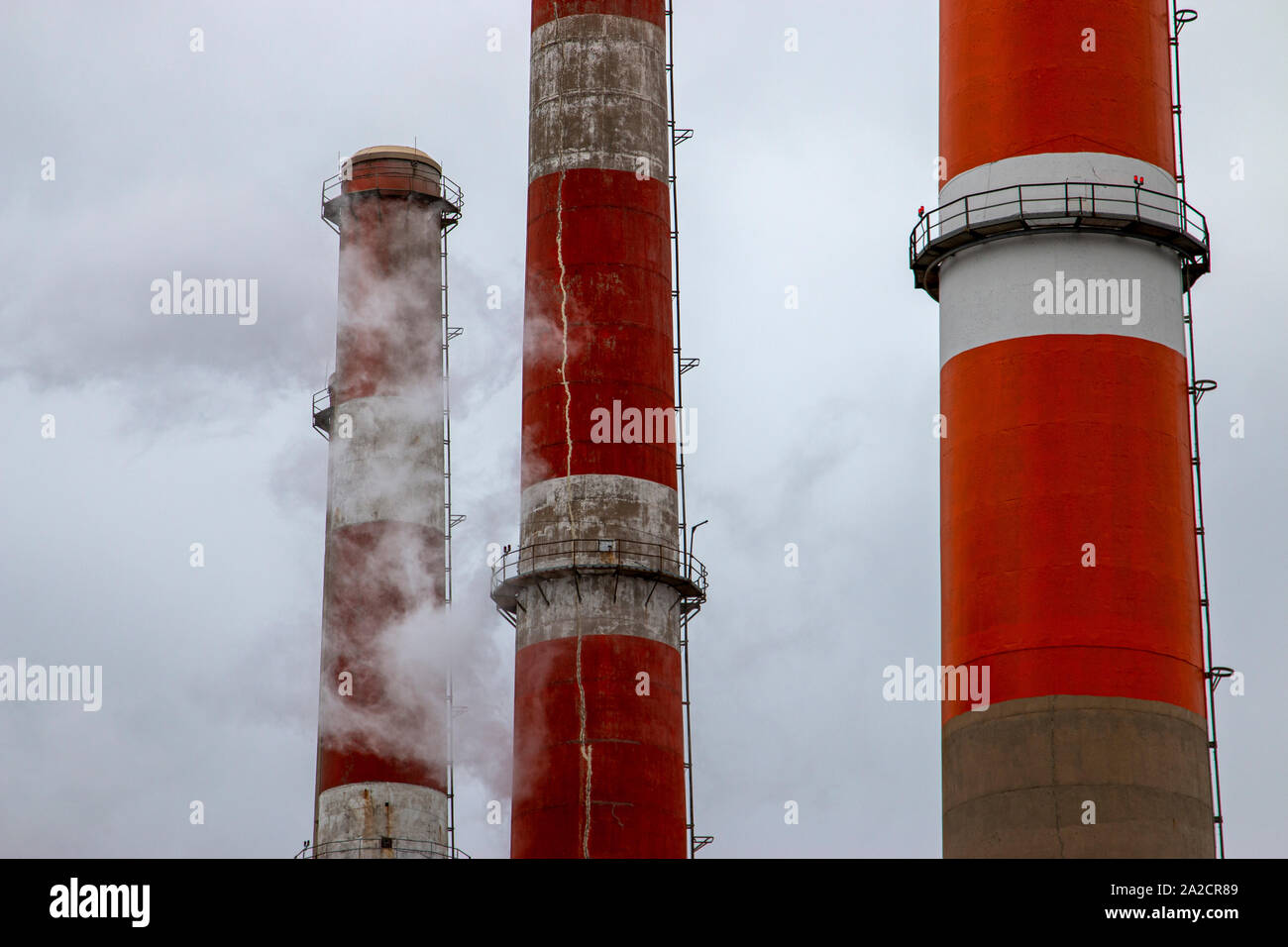 The Canadian Sask Power Plant Boundary Dam claims to be the worlds first coal power plant with viable carbon capture and storage incorporated. Stock Photohttps://www.alamy.com/image-license-details/?v=1https://www.alamy.com/the-canadian-sask-power-plant-boundary-dam-claims-to-be-the-worlds-first-coal-power-plant-with-viable-carbon-capture-and-storage-incorporated-image328507993.html
The Canadian Sask Power Plant Boundary Dam claims to be the worlds first coal power plant with viable carbon capture and storage incorporated. Stock Photohttps://www.alamy.com/image-license-details/?v=1https://www.alamy.com/the-canadian-sask-power-plant-boundary-dam-claims-to-be-the-worlds-first-coal-power-plant-with-viable-carbon-capture-and-storage-incorporated-image328507993.htmlRM2A2CR89–The Canadian Sask Power Plant Boundary Dam claims to be the worlds first coal power plant with viable carbon capture and storage incorporated.
 Activists stage a demonstration near the Arc de Triomphe at the Avenue de la Grande Armee boulevard in Paris, France, on December 12, 2015. A proposed 195-nation accord to curb emissions of the heat-trapping gases that threaten to wreak havoc on Earth's climate system is to be presented at the United Nations conference on climate change COP21 in Le Bourget, on the outskirts of Paris. Photo by Somer/ABACAPRESS.COM Stock Photohttps://www.alamy.com/image-license-details/?v=1https://www.alamy.com/activists-stage-a-demonstration-near-the-arc-de-triomphe-at-the-avenue-de-la-grande-armee-boulevard-in-paris-france-on-december-12-2015-a-proposed-195-nation-accord-to-curb-emissions-of-the-heat-trapping-gases-that-threaten-to-wreak-havoc-on-earths-climate-system-is-to-be-presented-at-the-united-nations-conference-on-climate-change-cop21-in-le-bourget-on-the-outskirts-of-paris-photo-by-somerabacapresscom-image393009003.html
Activists stage a demonstration near the Arc de Triomphe at the Avenue de la Grande Armee boulevard in Paris, France, on December 12, 2015. A proposed 195-nation accord to curb emissions of the heat-trapping gases that threaten to wreak havoc on Earth's climate system is to be presented at the United Nations conference on climate change COP21 in Le Bourget, on the outskirts of Paris. Photo by Somer/ABACAPRESS.COM Stock Photohttps://www.alamy.com/image-license-details/?v=1https://www.alamy.com/activists-stage-a-demonstration-near-the-arc-de-triomphe-at-the-avenue-de-la-grande-armee-boulevard-in-paris-france-on-december-12-2015-a-proposed-195-nation-accord-to-curb-emissions-of-the-heat-trapping-gases-that-threaten-to-wreak-havoc-on-earths-climate-system-is-to-be-presented-at-the-united-nations-conference-on-climate-change-cop21-in-le-bourget-on-the-outskirts-of-paris-photo-by-somerabacapresscom-image393009003.htmlRM2DRB2YR–Activists stage a demonstration near the Arc de Triomphe at the Avenue de la Grande Armee boulevard in Paris, France, on December 12, 2015. A proposed 195-nation accord to curb emissions of the heat-trapping gases that threaten to wreak havoc on Earth's climate system is to be presented at the United Nations conference on climate change COP21 in Le Bourget, on the outskirts of Paris. Photo by Somer/ABACAPRESS.COM
 Hot summer season or heat wave, global warming concept, vintage, isolated thermometer showing high temperature, concept Stock Photohttps://www.alamy.com/image-license-details/?v=1https://www.alamy.com/hot-summer-season-or-heat-wave-global-warming-concept-vintage-isolated-thermometer-showing-high-temperature-concept-image369586054.html
Hot summer season or heat wave, global warming concept, vintage, isolated thermometer showing high temperature, concept Stock Photohttps://www.alamy.com/image-license-details/?v=1https://www.alamy.com/hot-summer-season-or-heat-wave-global-warming-concept-vintage-isolated-thermometer-showing-high-temperature-concept-image369586054.htmlRF2CD82NX–Hot summer season or heat wave, global warming concept, vintage, isolated thermometer showing high temperature, concept
 Men extract coal from an informal mine in Nalaikh, a poor urban district 36 km east of the capital Ulaanbaatar, Mongolia, January 16, 2019. Stock Photohttps://www.alamy.com/image-license-details/?v=1https://www.alamy.com/men-extract-coal-from-an-informal-mine-in-nalaikh-a-poor-urban-district-36-km-east-of-the-capital-ulaanbaatar-mongolia-january-16-2019-image328459772.html
Men extract coal from an informal mine in Nalaikh, a poor urban district 36 km east of the capital Ulaanbaatar, Mongolia, January 16, 2019. Stock Photohttps://www.alamy.com/image-license-details/?v=1https://www.alamy.com/men-extract-coal-from-an-informal-mine-in-nalaikh-a-poor-urban-district-36-km-east-of-the-capital-ulaanbaatar-mongolia-january-16-2019-image328459772.htmlRF2A2AHP4–Men extract coal from an informal mine in Nalaikh, a poor urban district 36 km east of the capital Ulaanbaatar, Mongolia, January 16, 2019.
![Deutschland. 23rd Apr, 2021. A symbolic wooden stamp with the words 'Green Deal', held by a hand in a bleed in front of a blurred EU flag in the background. Photo with composing [M]. The European Green Deal is a concept presented by the European Commission with the aim of reducing net greenhouse gas emissions to zero in the European Union by 2050 and becoming the first continent to become climate neutral. The Green Deal is to become a central component of the European Union's climate policy. | usage worldwide Credit: dpa/Alamy Live News Stock Photo Deutschland. 23rd Apr, 2021. A symbolic wooden stamp with the words 'Green Deal', held by a hand in a bleed in front of a blurred EU flag in the background. Photo with composing [M]. The European Green Deal is a concept presented by the European Commission with the aim of reducing net greenhouse gas emissions to zero in the European Union by 2050 and becoming the first continent to become climate neutral. The Green Deal is to become a central component of the European Union's climate policy. | usage worldwide Credit: dpa/Alamy Live News Stock Photo](https://c8.alamy.com/comp/2FK3E6R/deutschland-23rd-apr-2021-a-symbolic-wooden-stamp-with-the-words-green-deal-held-by-a-hand-in-a-bleed-in-front-of-a-blurred-eu-flag-in-the-background-photo-with-composing-m-the-european-green-deal-is-a-concept-presented-by-the-european-commission-with-the-aim-of-reducing-net-greenhouse-gas-emissions-to-zero-in-the-european-union-by-2050-and-becoming-the-first-continent-to-become-climate-neutral-the-green-deal-is-to-become-a-central-component-of-the-european-unions-climate-policy-usage-worldwide-credit-dpaalamy-live-news-2FK3E6R.jpg) Deutschland. 23rd Apr, 2021. A symbolic wooden stamp with the words 'Green Deal', held by a hand in a bleed in front of a blurred EU flag in the background. Photo with composing [M]. The European Green Deal is a concept presented by the European Commission with the aim of reducing net greenhouse gas emissions to zero in the European Union by 2050 and becoming the first continent to become climate neutral. The Green Deal is to become a central component of the European Union's climate policy. | usage worldwide Credit: dpa/Alamy Live News Stock Photohttps://www.alamy.com/image-license-details/?v=1https://www.alamy.com/deutschland-23rd-apr-2021-a-symbolic-wooden-stamp-with-the-words-green-deal-held-by-a-hand-in-a-bleed-in-front-of-a-blurred-eu-flag-in-the-background-photo-with-composing-m-the-european-green-deal-is-a-concept-presented-by-the-european-commission-with-the-aim-of-reducing-net-greenhouse-gas-emissions-to-zero-in-the-european-union-by-2050-and-becoming-the-first-continent-to-become-climate-neutral-the-green-deal-is-to-become-a-central-component-of-the-european-unions-climate-policy-usage-worldwide-credit-dpaalamy-live-news-image424804319.html
Deutschland. 23rd Apr, 2021. A symbolic wooden stamp with the words 'Green Deal', held by a hand in a bleed in front of a blurred EU flag in the background. Photo with composing [M]. The European Green Deal is a concept presented by the European Commission with the aim of reducing net greenhouse gas emissions to zero in the European Union by 2050 and becoming the first continent to become climate neutral. The Green Deal is to become a central component of the European Union's climate policy. | usage worldwide Credit: dpa/Alamy Live News Stock Photohttps://www.alamy.com/image-license-details/?v=1https://www.alamy.com/deutschland-23rd-apr-2021-a-symbolic-wooden-stamp-with-the-words-green-deal-held-by-a-hand-in-a-bleed-in-front-of-a-blurred-eu-flag-in-the-background-photo-with-composing-m-the-european-green-deal-is-a-concept-presented-by-the-european-commission-with-the-aim-of-reducing-net-greenhouse-gas-emissions-to-zero-in-the-european-union-by-2050-and-becoming-the-first-continent-to-become-climate-neutral-the-green-deal-is-to-become-a-central-component-of-the-european-unions-climate-policy-usage-worldwide-credit-dpaalamy-live-news-image424804319.htmlRM2FK3E6R–Deutschland. 23rd Apr, 2021. A symbolic wooden stamp with the words 'Green Deal', held by a hand in a bleed in front of a blurred EU flag in the background. Photo with composing [M]. The European Green Deal is a concept presented by the European Commission with the aim of reducing net greenhouse gas emissions to zero in the European Union by 2050 and becoming the first continent to become climate neutral. The Green Deal is to become a central component of the European Union's climate policy. | usage worldwide Credit: dpa/Alamy Live News
 Trucks carrying raw coal to be sold to residents of the capital Ulaanbaatar arrives on the outskirts of the city, January 14, 2019. Stock Photohttps://www.alamy.com/image-license-details/?v=1https://www.alamy.com/trucks-carrying-raw-coal-to-be-sold-to-residents-of-the-capital-ulaanbaatar-arrives-on-the-outskirts-of-the-city-january-14-2019-image328459761.html
Trucks carrying raw coal to be sold to residents of the capital Ulaanbaatar arrives on the outskirts of the city, January 14, 2019. Stock Photohttps://www.alamy.com/image-license-details/?v=1https://www.alamy.com/trucks-carrying-raw-coal-to-be-sold-to-residents-of-the-capital-ulaanbaatar-arrives-on-the-outskirts-of-the-city-january-14-2019-image328459761.htmlRF2A2AHNN–Trucks carrying raw coal to be sold to residents of the capital Ulaanbaatar arrives on the outskirts of the city, January 14, 2019.
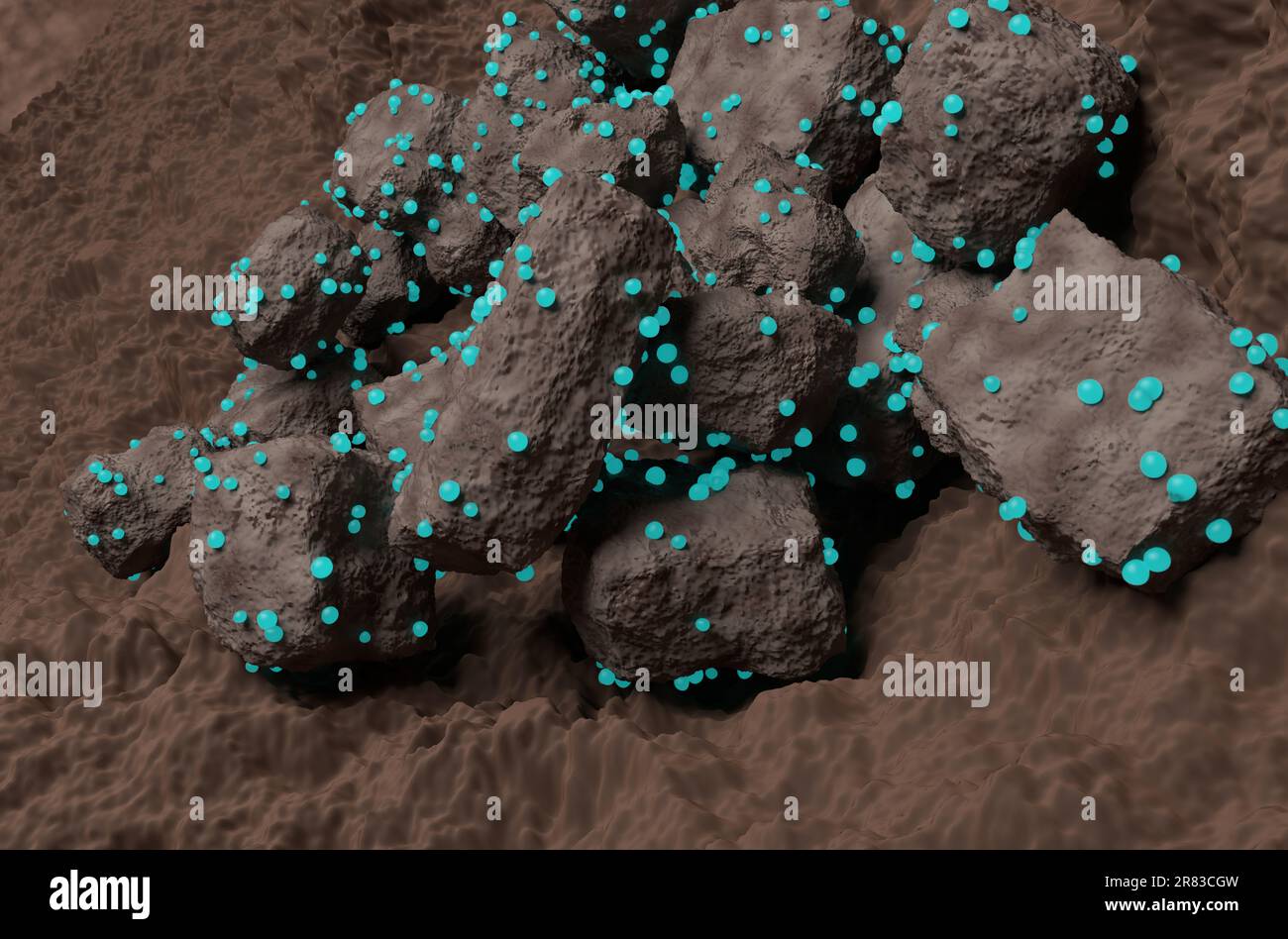 Rock captured the carbon dioxide gas bubbles - closeup view 3d illustration Stock Photohttps://www.alamy.com/image-license-details/?v=1https://www.alamy.com/rock-captured-the-carbon-dioxide-gas-bubbles-closeup-view-3d-illustration-image555724761.html
Rock captured the carbon dioxide gas bubbles - closeup view 3d illustration Stock Photohttps://www.alamy.com/image-license-details/?v=1https://www.alamy.com/rock-captured-the-carbon-dioxide-gas-bubbles-closeup-view-3d-illustration-image555724761.htmlRF2R83CGW–Rock captured the carbon dioxide gas bubbles - closeup view 3d illustration
 A government-installed sensor monitors levels of pollution in one of the ger districts of the capital, January 16, 2019. At the beginning of last year Stock Photohttps://www.alamy.com/image-license-details/?v=1https://www.alamy.com/a-government-installed-sensor-monitors-levels-of-pollution-in-one-of-the-ger-districts-of-the-capital-january-16-2019-at-the-beginning-of-last-year-image328459715.html
A government-installed sensor monitors levels of pollution in one of the ger districts of the capital, January 16, 2019. At the beginning of last year Stock Photohttps://www.alamy.com/image-license-details/?v=1https://www.alamy.com/a-government-installed-sensor-monitors-levels-of-pollution-in-one-of-the-ger-districts-of-the-capital-january-16-2019-at-the-beginning-of-last-year-image328459715.htmlRF2A2AHM3–A government-installed sensor monitors levels of pollution in one of the ger districts of the capital, January 16, 2019. At the beginning of last year
 Greenhouse Effect: The trapping of heat by certain gases, contributing to global warming. Stock Photohttps://www.alamy.com/image-license-details/?v=1https://www.alamy.com/greenhouse-effect-the-trapping-of-heat-by-certain-gases-contributing-to-global-warming-image595349110.html
Greenhouse Effect: The trapping of heat by certain gases, contributing to global warming. Stock Photohttps://www.alamy.com/image-license-details/?v=1https://www.alamy.com/greenhouse-effect-the-trapping-of-heat-by-certain-gases-contributing-to-global-warming-image595349110.htmlRF2WGGDT6–Greenhouse Effect: The trapping of heat by certain gases, contributing to global warming.
 Global warming, climate change, human-induced, emissions, greenhouse gases, soil erosion, large-scale, weather, shifts, gradual heating, earth surface Stock Photohttps://www.alamy.com/image-license-details/?v=1https://www.alamy.com/global-warming-climate-change-human-induced-emissions-greenhouse-gases-soil-erosion-large-scale-weather-shifts-gradual-heating-earth-surface-image433174290.html
Global warming, climate change, human-induced, emissions, greenhouse gases, soil erosion, large-scale, weather, shifts, gradual heating, earth surface Stock Photohttps://www.alamy.com/image-license-details/?v=1https://www.alamy.com/global-warming-climate-change-human-induced-emissions-greenhouse-gases-soil-erosion-large-scale-weather-shifts-gradual-heating-earth-surface-image433174290.htmlRF2G4MP6A–Global warming, climate change, human-induced, emissions, greenhouse gases, soil erosion, large-scale, weather, shifts, gradual heating, earth surface
 . Agri-news. Agriculture. ./.fey/ C2.. Reducing greenhouse gas emissions: saving more than the environment" By reducing greenhouse gas emissions the livestock, cropping and agri-food processing industries will address concerns for the environment regarding climate change and can reduce their own input costs. Most greenhouse gases occur naturally. The major greenhouse gases in the atmosphere include water vapour, carhon dioxide, methane, halocarhons and nitrous oxide. Greenhouse gases control the earth's climate by trapping heat in the earth's atmosphere and keeping the planet warm enough Stock Photohttps://www.alamy.com/image-license-details/?v=1https://www.alamy.com/agri-news-agriculture-fey-c2-reducing-greenhouse-gas-emissions-saving-more-than-the-environmentquot-by-reducing-greenhouse-gas-emissions-the-livestock-cropping-and-agri-food-processing-industries-will-address-concerns-for-the-environment-regarding-climate-change-and-can-reduce-their-own-input-costs-most-greenhouse-gases-occur-naturally-the-major-greenhouse-gases-in-the-atmosphere-include-water-vapour-carhon-dioxide-methane-halocarhons-and-nitrous-oxide-greenhouse-gases-control-the-earths-climate-by-trapping-heat-in-the-earths-atmosphere-and-keeping-the-planet-warm-enough-image237851528.html
. Agri-news. Agriculture. ./.fey/ C2.. Reducing greenhouse gas emissions: saving more than the environment" By reducing greenhouse gas emissions the livestock, cropping and agri-food processing industries will address concerns for the environment regarding climate change and can reduce their own input costs. Most greenhouse gases occur naturally. The major greenhouse gases in the atmosphere include water vapour, carhon dioxide, methane, halocarhons and nitrous oxide. Greenhouse gases control the earth's climate by trapping heat in the earth's atmosphere and keeping the planet warm enough Stock Photohttps://www.alamy.com/image-license-details/?v=1https://www.alamy.com/agri-news-agriculture-fey-c2-reducing-greenhouse-gas-emissions-saving-more-than-the-environmentquot-by-reducing-greenhouse-gas-emissions-the-livestock-cropping-and-agri-food-processing-industries-will-address-concerns-for-the-environment-regarding-climate-change-and-can-reduce-their-own-input-costs-most-greenhouse-gases-occur-naturally-the-major-greenhouse-gases-in-the-atmosphere-include-water-vapour-carhon-dioxide-methane-halocarhons-and-nitrous-oxide-greenhouse-gases-control-the-earths-climate-by-trapping-heat-in-the-earths-atmosphere-and-keeping-the-planet-warm-enough-image237851528.htmlRMRPY21C–. Agri-news. Agriculture. ./.fey/ C2.. Reducing greenhouse gas emissions: saving more than the environment" By reducing greenhouse gas emissions the livestock, cropping and agri-food processing industries will address concerns for the environment regarding climate change and can reduce their own input costs. Most greenhouse gases occur naturally. The major greenhouse gases in the atmosphere include water vapour, carhon dioxide, methane, halocarhons and nitrous oxide. Greenhouse gases control the earth's climate by trapping heat in the earth's atmosphere and keeping the planet warm enough
 Mar 10, 2008 - Minneapolis, Minnesota, USA - Thirty-five mayors in Minnesota and hundreds more nationwide have pledged to stem the flow of heat-trapping gases from their cities into the warming atmosphere. This Metro Transit bus is a greener bus which is Hybrid electric. (Credit Image: © Richard Sen Stock Photohttps://www.alamy.com/image-license-details/?v=1https://www.alamy.com/stock-photo-mar-10-2008-minneapolis-minnesota-usa-thirty-five-mayors-in-minnesota-42474392.html
Mar 10, 2008 - Minneapolis, Minnesota, USA - Thirty-five mayors in Minnesota and hundreds more nationwide have pledged to stem the flow of heat-trapping gases from their cities into the warming atmosphere. This Metro Transit bus is a greener bus which is Hybrid electric. (Credit Image: © Richard Sen Stock Photohttps://www.alamy.com/image-license-details/?v=1https://www.alamy.com/stock-photo-mar-10-2008-minneapolis-minnesota-usa-thirty-five-mayors-in-minnesota-42474392.htmlRMCD2TEG–Mar 10, 2008 - Minneapolis, Minnesota, USA - Thirty-five mayors in Minnesota and hundreds more nationwide have pledged to stem the flow of heat-trapping gases from their cities into the warming atmosphere. This Metro Transit bus is a greener bus which is Hybrid electric. (Credit Image: © Richard Sen
 The Canadian Sask Power Plant Boundary Dam claims to be the worlds first coal power plant with viable carbon capture and storage incorporated. Stock Photohttps://www.alamy.com/image-license-details/?v=1https://www.alamy.com/the-canadian-sask-power-plant-boundary-dam-claims-to-be-the-worlds-first-coal-power-plant-with-viable-carbon-capture-and-storage-incorporated-image328487175.html
The Canadian Sask Power Plant Boundary Dam claims to be the worlds first coal power plant with viable carbon capture and storage incorporated. Stock Photohttps://www.alamy.com/image-license-details/?v=1https://www.alamy.com/the-canadian-sask-power-plant-boundary-dam-claims-to-be-the-worlds-first-coal-power-plant-with-viable-carbon-capture-and-storage-incorporated-image328487175.htmlRM2A2BTMR–The Canadian Sask Power Plant Boundary Dam claims to be the worlds first coal power plant with viable carbon capture and storage incorporated.
 Activists stage a demonstration near the Arc de Triomphe at the Avenue de la Grande Armee boulevard in Paris, France, on December 12, 2015. A proposed 195-nation accord to curb emissions of the heat-trapping gases that threaten to wreak havoc on Earth's climate system is to be presented at the United Nations conference on climate change COP21 in Le Bourget, on the outskirts of Paris. Photo by Somer/ABACAPRESS.COM Stock Photohttps://www.alamy.com/image-license-details/?v=1https://www.alamy.com/activists-stage-a-demonstration-near-the-arc-de-triomphe-at-the-avenue-de-la-grande-armee-boulevard-in-paris-france-on-december-12-2015-a-proposed-195-nation-accord-to-curb-emissions-of-the-heat-trapping-gases-that-threaten-to-wreak-havoc-on-earths-climate-system-is-to-be-presented-at-the-united-nations-conference-on-climate-change-cop21-in-le-bourget-on-the-outskirts-of-paris-photo-by-somerabacapresscom-image393008960.html
Activists stage a demonstration near the Arc de Triomphe at the Avenue de la Grande Armee boulevard in Paris, France, on December 12, 2015. A proposed 195-nation accord to curb emissions of the heat-trapping gases that threaten to wreak havoc on Earth's climate system is to be presented at the United Nations conference on climate change COP21 in Le Bourget, on the outskirts of Paris. Photo by Somer/ABACAPRESS.COM Stock Photohttps://www.alamy.com/image-license-details/?v=1https://www.alamy.com/activists-stage-a-demonstration-near-the-arc-de-triomphe-at-the-avenue-de-la-grande-armee-boulevard-in-paris-france-on-december-12-2015-a-proposed-195-nation-accord-to-curb-emissions-of-the-heat-trapping-gases-that-threaten-to-wreak-havoc-on-earths-climate-system-is-to-be-presented-at-the-united-nations-conference-on-climate-change-cop21-in-le-bourget-on-the-outskirts-of-paris-photo-by-somerabacapresscom-image393008960.htmlRM2DRB2X8–Activists stage a demonstration near the Arc de Triomphe at the Avenue de la Grande Armee boulevard in Paris, France, on December 12, 2015. A proposed 195-nation accord to curb emissions of the heat-trapping gases that threaten to wreak havoc on Earth's climate system is to be presented at the United Nations conference on climate change COP21 in Le Bourget, on the outskirts of Paris. Photo by Somer/ABACAPRESS.COM
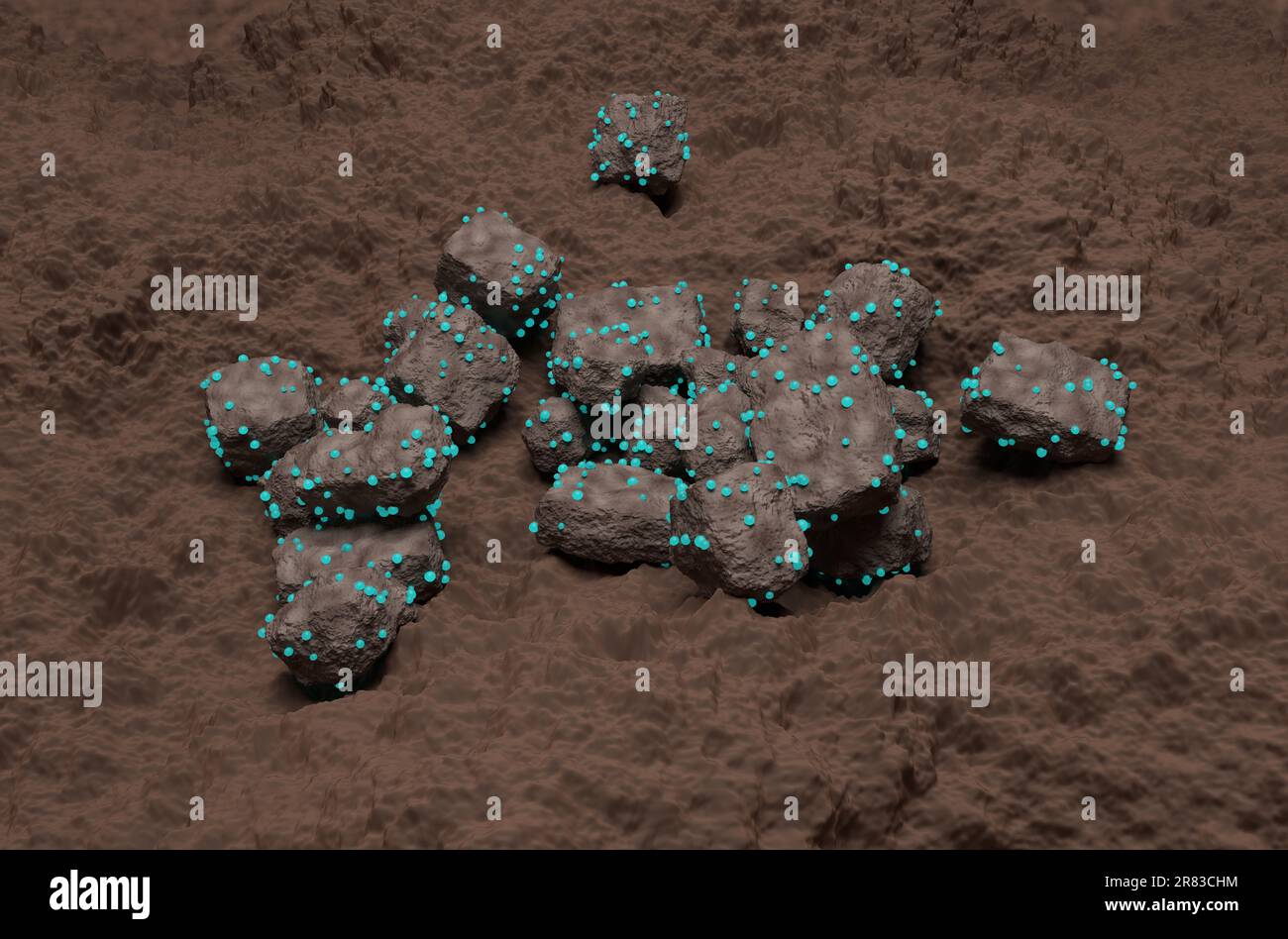 Rock captured the carbon dioxide gas bubbles - isometric view 3d illustration Stock Photohttps://www.alamy.com/image-license-details/?v=1https://www.alamy.com/rock-captured-the-carbon-dioxide-gas-bubbles-isometric-view-3d-illustration-image555724784.html
Rock captured the carbon dioxide gas bubbles - isometric view 3d illustration Stock Photohttps://www.alamy.com/image-license-details/?v=1https://www.alamy.com/rock-captured-the-carbon-dioxide-gas-bubbles-isometric-view-3d-illustration-image555724784.htmlRF2R83CHM–Rock captured the carbon dioxide gas bubbles - isometric view 3d illustration
 Global warming, climate change, human-induced, emissions, greenhouse gases, soil erosion, large-scale, weather, shifts, gradual heating, earth surface Stock Photohttps://www.alamy.com/image-license-details/?v=1https://www.alamy.com/global-warming-climate-change-human-induced-emissions-greenhouse-gases-soil-erosion-large-scale-weather-shifts-gradual-heating-earth-surface-image433174257.html
Global warming, climate change, human-induced, emissions, greenhouse gases, soil erosion, large-scale, weather, shifts, gradual heating, earth surface Stock Photohttps://www.alamy.com/image-license-details/?v=1https://www.alamy.com/global-warming-climate-change-human-induced-emissions-greenhouse-gases-soil-erosion-large-scale-weather-shifts-gradual-heating-earth-surface-image433174257.htmlRF2G4MP55–Global warming, climate change, human-induced, emissions, greenhouse gases, soil erosion, large-scale, weather, shifts, gradual heating, earth surface
 . The Changing Illinois environment : critical trends : summary report of the Critical Trends Assessment Project. Man; Pollution; Environmental protection; Ecology; Environmental impact analysis. Atmosphere â 15 Emissions of greenhouse gases are sometimes measured in "COi equivalents" to adjust for their different heat-trapping potentials. Adjusted emissions of the three major green- houses gases (methane, COi, and NiO) from Illinois sources in 1990 were some 260 mil- lion tons, down 18% since 1970. (Figure 2-8) The decline has several causes, from increased use of nuclear energy to Stock Photohttps://www.alamy.com/image-license-details/?v=1https://www.alamy.com/the-changing-illinois-environment-critical-trends-summary-report-of-the-critical-trends-assessment-project-man-pollution-environmental-protection-ecology-environmental-impact-analysis-atmosphere-15-emissions-of-greenhouse-gases-are-sometimes-measured-in-quotcoi-equivalentsquot-to-adjust-for-their-different-heat-trapping-potentials-adjusted-emissions-of-the-three-major-green-houses-gases-methane-coi-and-nio-from-illinois-sources-in-1990-were-some-260-mil-lion-tons-down-18-since-1970-figure-2-8-the-decline-has-several-causes-from-increased-use-of-nuclear-energy-to-image235093492.html
. The Changing Illinois environment : critical trends : summary report of the Critical Trends Assessment Project. Man; Pollution; Environmental protection; Ecology; Environmental impact analysis. Atmosphere â 15 Emissions of greenhouse gases are sometimes measured in "COi equivalents" to adjust for their different heat-trapping potentials. Adjusted emissions of the three major green- houses gases (methane, COi, and NiO) from Illinois sources in 1990 were some 260 mil- lion tons, down 18% since 1970. (Figure 2-8) The decline has several causes, from increased use of nuclear energy to Stock Photohttps://www.alamy.com/image-license-details/?v=1https://www.alamy.com/the-changing-illinois-environment-critical-trends-summary-report-of-the-critical-trends-assessment-project-man-pollution-environmental-protection-ecology-environmental-impact-analysis-atmosphere-15-emissions-of-greenhouse-gases-are-sometimes-measured-in-quotcoi-equivalentsquot-to-adjust-for-their-different-heat-trapping-potentials-adjusted-emissions-of-the-three-major-green-houses-gases-methane-coi-and-nio-from-illinois-sources-in-1990-were-some-260-mil-lion-tons-down-18-since-1970-figure-2-8-the-decline-has-several-causes-from-increased-use-of-nuclear-energy-to-image235093492.htmlRMRJDC44–. The Changing Illinois environment : critical trends : summary report of the Critical Trends Assessment Project. Man; Pollution; Environmental protection; Ecology; Environmental impact analysis. Atmosphere â 15 Emissions of greenhouse gases are sometimes measured in "COi equivalents" to adjust for their different heat-trapping potentials. Adjusted emissions of the three major green- houses gases (methane, COi, and NiO) from Illinois sources in 1990 were some 260 mil- lion tons, down 18% since 1970. (Figure 2-8) The decline has several causes, from increased use of nuclear energy to
 Mar 10, 2008 - Minneapolis, Minnesota, USA - Thirty-five mayors in Minnesota and hundreds more nationwide have pledged to stem the flow of heat-trapping gases from their cities into the fire station No. 6 has 30 165 watt photovoltaic cells on the roof of the station which produces 5 KW of electrical Stock Photohttps://www.alamy.com/image-license-details/?v=1https://www.alamy.com/stock-photo-mar-10-2008-minneapolis-minnesota-usa-thirty-five-mayors-in-minnesota-42474393.html
Mar 10, 2008 - Minneapolis, Minnesota, USA - Thirty-five mayors in Minnesota and hundreds more nationwide have pledged to stem the flow of heat-trapping gases from their cities into the fire station No. 6 has 30 165 watt photovoltaic cells on the roof of the station which produces 5 KW of electrical Stock Photohttps://www.alamy.com/image-license-details/?v=1https://www.alamy.com/stock-photo-mar-10-2008-minneapolis-minnesota-usa-thirty-five-mayors-in-minnesota-42474393.htmlRMCD2TEH–Mar 10, 2008 - Minneapolis, Minnesota, USA - Thirty-five mayors in Minnesota and hundreds more nationwide have pledged to stem the flow of heat-trapping gases from their cities into the fire station No. 6 has 30 165 watt photovoltaic cells on the roof of the station which produces 5 KW of electrical
 The Canadian Sask Power Plant Boundary Dam claims to be the worlds first coal power plant with viable carbon capture and storage incorporated. Stock Photohttps://www.alamy.com/image-license-details/?v=1https://www.alamy.com/the-canadian-sask-power-plant-boundary-dam-claims-to-be-the-worlds-first-coal-power-plant-with-viable-carbon-capture-and-storage-incorporated-image328487176.html
The Canadian Sask Power Plant Boundary Dam claims to be the worlds first coal power plant with viable carbon capture and storage incorporated. Stock Photohttps://www.alamy.com/image-license-details/?v=1https://www.alamy.com/the-canadian-sask-power-plant-boundary-dam-claims-to-be-the-worlds-first-coal-power-plant-with-viable-carbon-capture-and-storage-incorporated-image328487176.htmlRM2A2BTMT–The Canadian Sask Power Plant Boundary Dam claims to be the worlds first coal power plant with viable carbon capture and storage incorporated.
 People wearing polar bear costumes are seen while activists stage a demonstration near the Eiffel Tower in Paris, France, on December 12, 2015. A proposed 195-nation accord to curb emissions of the heat-trapping gases that threaten to wreak havoc on Earth's climate system is to be presented at the United Nations conference on climate change COP21 in Le Bourget, on the outskirts of Paris. Photo by Alain Apaydin/ABACAPRESS.COM Stock Photohttps://www.alamy.com/image-license-details/?v=1https://www.alamy.com/people-wearing-polar-bear-costumes-are-seen-while-activists-stage-a-demonstration-near-the-eiffel-tower-in-paris-france-on-december-12-2015-a-proposed-195-nation-accord-to-curb-emissions-of-the-heat-trapping-gases-that-threaten-to-wreak-havoc-on-earths-climate-system-is-to-be-presented-at-the-united-nations-conference-on-climate-change-cop21-in-le-bourget-on-the-outskirts-of-paris-photo-by-alain-apaydinabacapresscom-image393009026.html
People wearing polar bear costumes are seen while activists stage a demonstration near the Eiffel Tower in Paris, France, on December 12, 2015. A proposed 195-nation accord to curb emissions of the heat-trapping gases that threaten to wreak havoc on Earth's climate system is to be presented at the United Nations conference on climate change COP21 in Le Bourget, on the outskirts of Paris. Photo by Alain Apaydin/ABACAPRESS.COM Stock Photohttps://www.alamy.com/image-license-details/?v=1https://www.alamy.com/people-wearing-polar-bear-costumes-are-seen-while-activists-stage-a-demonstration-near-the-eiffel-tower-in-paris-france-on-december-12-2015-a-proposed-195-nation-accord-to-curb-emissions-of-the-heat-trapping-gases-that-threaten-to-wreak-havoc-on-earths-climate-system-is-to-be-presented-at-the-united-nations-conference-on-climate-change-cop21-in-le-bourget-on-the-outskirts-of-paris-photo-by-alain-apaydinabacapresscom-image393009026.htmlRM2DRB30J–People wearing polar bear costumes are seen while activists stage a demonstration near the Eiffel Tower in Paris, France, on December 12, 2015. A proposed 195-nation accord to curb emissions of the heat-trapping gases that threaten to wreak havoc on Earth's climate system is to be presented at the United Nations conference on climate change COP21 in Le Bourget, on the outskirts of Paris. Photo by Alain Apaydin/ABACAPRESS.COM
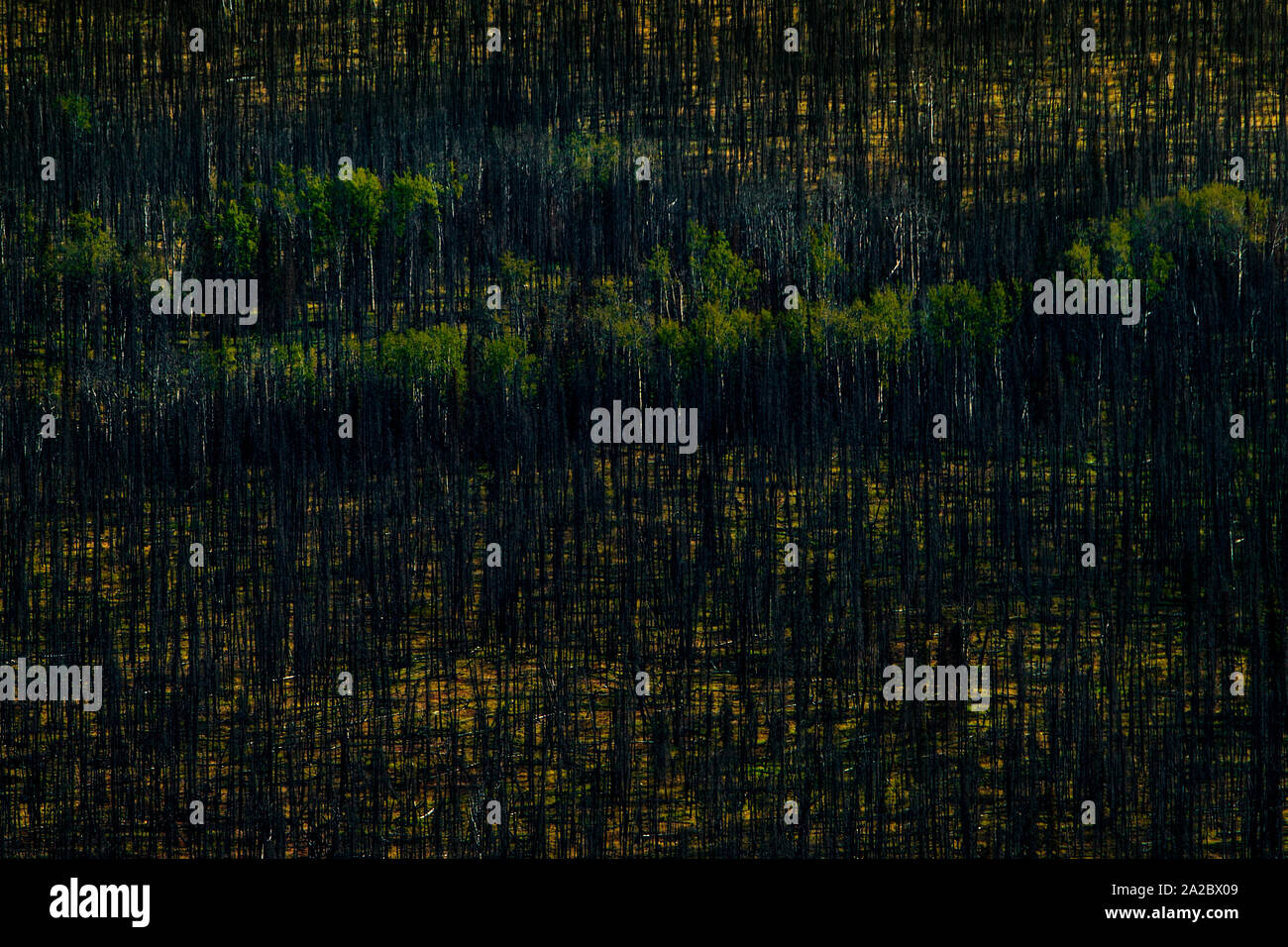 A patch of damaged forest near Anchorage in Alaska. The borealis forest – typically pine, birch and larch - make up about thirty percent of all forest in the world. Less efficient than rain forests, it’s still a vital part of the carbon sink. The mean temperature in the arctic areas are already 1.5c warmer than normal. Higher levels of CO2 accelerate growth of the forest. However; as growth is accellerated, the lifespan of the trees is shortened. The net result is a CO2 saturated forest that turn from being a carbon sink to emitter. Stock Photohttps://www.alamy.com/image-license-details/?v=1https://www.alamy.com/a-patch-of-damaged-forest-near-anchorage-in-alaska-the-borealis-forest-typically-pine-birch-and-larch-make-up-about-thirty-percent-of-all-forest-in-the-world-less-efficient-than-rain-forests-its-still-a-vital-part-of-the-carbon-sink-the-mean-temperature-in-the-arctic-areas-are-already-15c-warmer-than-normal-higher-levels-of-co2-accelerate-growth-of-the-forest-however-as-growth-is-accellerated-the-lifespan-of-the-trees-is-shortened-the-net-result-is-a-co2-saturated-forest-that-turn-from-being-a-carbon-sink-to-emitter-image328488169.html
A patch of damaged forest near Anchorage in Alaska. The borealis forest – typically pine, birch and larch - make up about thirty percent of all forest in the world. Less efficient than rain forests, it’s still a vital part of the carbon sink. The mean temperature in the arctic areas are already 1.5c warmer than normal. Higher levels of CO2 accelerate growth of the forest. However; as growth is accellerated, the lifespan of the trees is shortened. The net result is a CO2 saturated forest that turn from being a carbon sink to emitter. Stock Photohttps://www.alamy.com/image-license-details/?v=1https://www.alamy.com/a-patch-of-damaged-forest-near-anchorage-in-alaska-the-borealis-forest-typically-pine-birch-and-larch-make-up-about-thirty-percent-of-all-forest-in-the-world-less-efficient-than-rain-forests-its-still-a-vital-part-of-the-carbon-sink-the-mean-temperature-in-the-arctic-areas-are-already-15c-warmer-than-normal-higher-levels-of-co2-accelerate-growth-of-the-forest-however-as-growth-is-accellerated-the-lifespan-of-the-trees-is-shortened-the-net-result-is-a-co2-saturated-forest-that-turn-from-being-a-carbon-sink-to-emitter-image328488169.htmlRM2A2BX09–A patch of damaged forest near Anchorage in Alaska. The borealis forest – typically pine, birch and larch - make up about thirty percent of all forest in the world. Less efficient than rain forests, it’s still a vital part of the carbon sink. The mean temperature in the arctic areas are already 1.5c warmer than normal. Higher levels of CO2 accelerate growth of the forest. However; as growth is accellerated, the lifespan of the trees is shortened. The net result is a CO2 saturated forest that turn from being a carbon sink to emitter.
 Global warming, climate change, human-induced, emissions, greenhouse gases, soil erosion, large-scale, weather, shifts, gradual heating, earth surface Stock Photohttps://www.alamy.com/image-license-details/?v=1https://www.alamy.com/global-warming-climate-change-human-induced-emissions-greenhouse-gases-soil-erosion-large-scale-weather-shifts-gradual-heating-earth-surface-image433174274.html
Global warming, climate change, human-induced, emissions, greenhouse gases, soil erosion, large-scale, weather, shifts, gradual heating, earth surface Stock Photohttps://www.alamy.com/image-license-details/?v=1https://www.alamy.com/global-warming-climate-change-human-induced-emissions-greenhouse-gases-soil-erosion-large-scale-weather-shifts-gradual-heating-earth-surface-image433174274.htmlRF2G4MP5P–Global warming, climate change, human-induced, emissions, greenhouse gases, soil erosion, large-scale, weather, shifts, gradual heating, earth surface
 Activists stage a demonstration near the Arc de Triomphe at the Avenue de la Grande Armee boulevard in Paris, France, on December 12, 2015. A proposed 195-nation accord to curb emissions of the heat-trapping gases that threaten to wreak havoc on Earth's climate system is to be presented at the United Nations conference on climate change COP21 in Le Bourget, on the outskirts of Paris. Photo by Somer/ABACAPRESS.COM Stock Photohttps://www.alamy.com/image-license-details/?v=1https://www.alamy.com/activists-stage-a-demonstration-near-the-arc-de-triomphe-at-the-avenue-de-la-grande-armee-boulevard-in-paris-france-on-december-12-2015-a-proposed-195-nation-accord-to-curb-emissions-of-the-heat-trapping-gases-that-threaten-to-wreak-havoc-on-earths-climate-system-is-to-be-presented-at-the-united-nations-conference-on-climate-change-cop21-in-le-bourget-on-the-outskirts-of-paris-photo-by-somerabacapresscom-image393009028.html
Activists stage a demonstration near the Arc de Triomphe at the Avenue de la Grande Armee boulevard in Paris, France, on December 12, 2015. A proposed 195-nation accord to curb emissions of the heat-trapping gases that threaten to wreak havoc on Earth's climate system is to be presented at the United Nations conference on climate change COP21 in Le Bourget, on the outskirts of Paris. Photo by Somer/ABACAPRESS.COM Stock Photohttps://www.alamy.com/image-license-details/?v=1https://www.alamy.com/activists-stage-a-demonstration-near-the-arc-de-triomphe-at-the-avenue-de-la-grande-armee-boulevard-in-paris-france-on-december-12-2015-a-proposed-195-nation-accord-to-curb-emissions-of-the-heat-trapping-gases-that-threaten-to-wreak-havoc-on-earths-climate-system-is-to-be-presented-at-the-united-nations-conference-on-climate-change-cop21-in-le-bourget-on-the-outskirts-of-paris-photo-by-somerabacapresscom-image393009028.htmlRM2DRB30M–Activists stage a demonstration near the Arc de Triomphe at the Avenue de la Grande Armee boulevard in Paris, France, on December 12, 2015. A proposed 195-nation accord to curb emissions of the heat-trapping gases that threaten to wreak havoc on Earth's climate system is to be presented at the United Nations conference on climate change COP21 in Le Bourget, on the outskirts of Paris. Photo by Somer/ABACAPRESS.COM
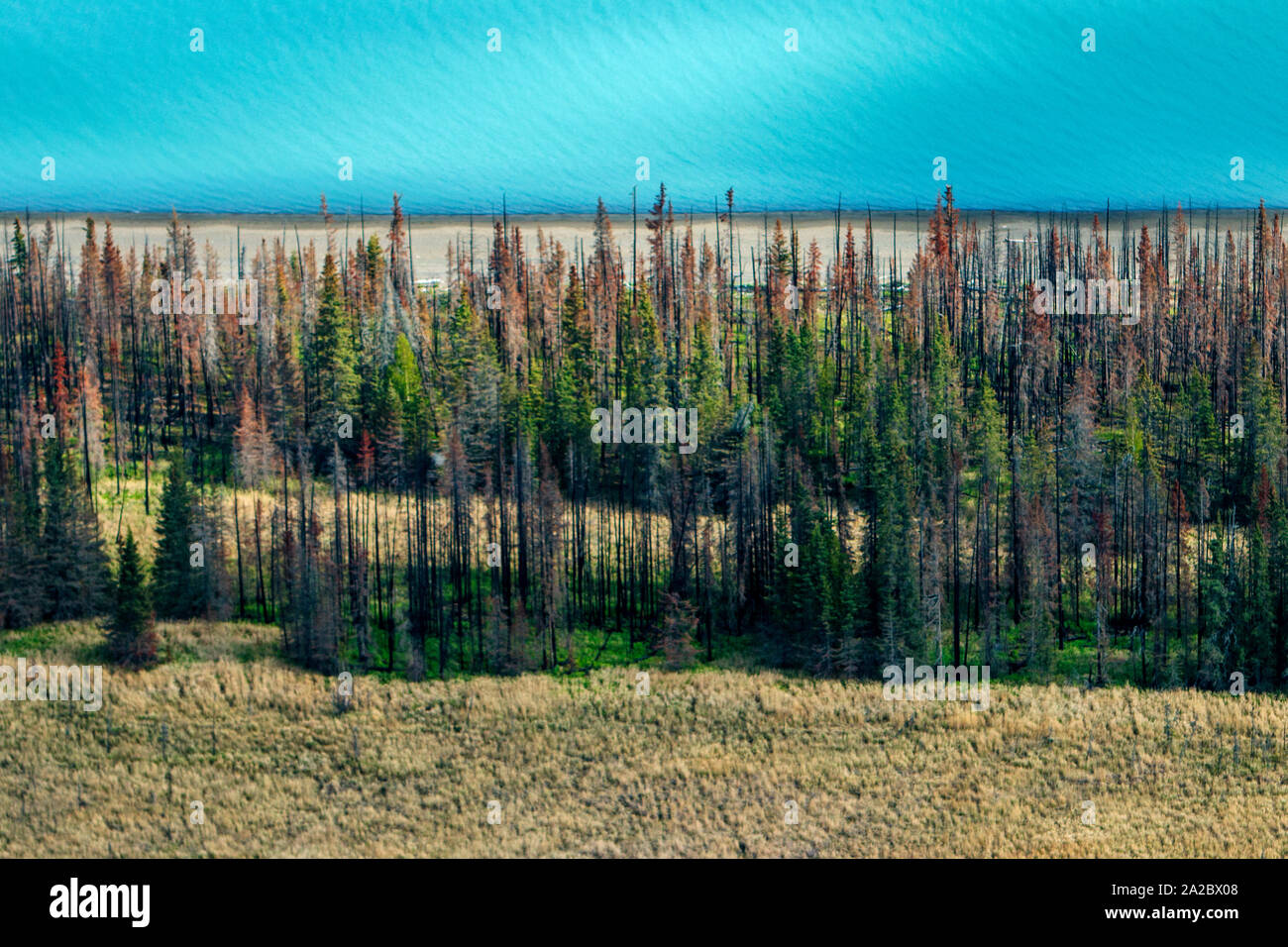 A patch of damaged forest near Anchorage in Alaska. The borealis forest – typically pine, birch and larch - make up about thirty percent of all forest in the world. Less efficient than rain forests, it’s still a vital part of the carbon sink. The mean temperature in the arctic areas are already 1.5c warmer than normal. Higher levels of CO2 accelerate growth of the forest. However; as growth is accellerated, the lifespan of the trees is shortened. The net result is a CO2 saturated forest that turn from being a carbon sink to emitter. Stock Photohttps://www.alamy.com/image-license-details/?v=1https://www.alamy.com/a-patch-of-damaged-forest-near-anchorage-in-alaska-the-borealis-forest-typically-pine-birch-and-larch-make-up-about-thirty-percent-of-all-forest-in-the-world-less-efficient-than-rain-forests-its-still-a-vital-part-of-the-carbon-sink-the-mean-temperature-in-the-arctic-areas-are-already-15c-warmer-than-normal-higher-levels-of-co2-accelerate-growth-of-the-forest-however-as-growth-is-accellerated-the-lifespan-of-the-trees-is-shortened-the-net-result-is-a-co2-saturated-forest-that-turn-from-being-a-carbon-sink-to-emitter-image328488168.html
A patch of damaged forest near Anchorage in Alaska. The borealis forest – typically pine, birch and larch - make up about thirty percent of all forest in the world. Less efficient than rain forests, it’s still a vital part of the carbon sink. The mean temperature in the arctic areas are already 1.5c warmer than normal. Higher levels of CO2 accelerate growth of the forest. However; as growth is accellerated, the lifespan of the trees is shortened. The net result is a CO2 saturated forest that turn from being a carbon sink to emitter. Stock Photohttps://www.alamy.com/image-license-details/?v=1https://www.alamy.com/a-patch-of-damaged-forest-near-anchorage-in-alaska-the-borealis-forest-typically-pine-birch-and-larch-make-up-about-thirty-percent-of-all-forest-in-the-world-less-efficient-than-rain-forests-its-still-a-vital-part-of-the-carbon-sink-the-mean-temperature-in-the-arctic-areas-are-already-15c-warmer-than-normal-higher-levels-of-co2-accelerate-growth-of-the-forest-however-as-growth-is-accellerated-the-lifespan-of-the-trees-is-shortened-the-net-result-is-a-co2-saturated-forest-that-turn-from-being-a-carbon-sink-to-emitter-image328488168.htmlRM2A2BX08–A patch of damaged forest near Anchorage in Alaska. The borealis forest – typically pine, birch and larch - make up about thirty percent of all forest in the world. Less efficient than rain forests, it’s still a vital part of the carbon sink. The mean temperature in the arctic areas are already 1.5c warmer than normal. Higher levels of CO2 accelerate growth of the forest. However; as growth is accellerated, the lifespan of the trees is shortened. The net result is a CO2 saturated forest that turn from being a carbon sink to emitter.
 Global warming, climate change, human-induced, emissions, greenhouse gases, soil erosion, large-scale, weather, shifts, gradual heating, earth surface Stock Photohttps://www.alamy.com/image-license-details/?v=1https://www.alamy.com/global-warming-climate-change-human-induced-emissions-greenhouse-gases-soil-erosion-large-scale-weather-shifts-gradual-heating-earth-surface-image433174343.html
Global warming, climate change, human-induced, emissions, greenhouse gases, soil erosion, large-scale, weather, shifts, gradual heating, earth surface Stock Photohttps://www.alamy.com/image-license-details/?v=1https://www.alamy.com/global-warming-climate-change-human-induced-emissions-greenhouse-gases-soil-erosion-large-scale-weather-shifts-gradual-heating-earth-surface-image433174343.htmlRF2G4MP87–Global warming, climate change, human-induced, emissions, greenhouse gases, soil erosion, large-scale, weather, shifts, gradual heating, earth surface
 People wearing polar bear costumes are seen while activists stage a demonstration near the Eiffel Tower in Paris, France, on December 12, 2015. A proposed 195-nation accord to curb emissions of the heat-trapping gases that threaten to wreak havoc on Earth's climate system is to be presented at the United Nations conference on climate change COP21 in Le Bourget, on the outskirts of Paris. Photo by Alain Apaydin/ABACAPRESS.COM Stock Photohttps://www.alamy.com/image-license-details/?v=1https://www.alamy.com/people-wearing-polar-bear-costumes-are-seen-while-activists-stage-a-demonstration-near-the-eiffel-tower-in-paris-france-on-december-12-2015-a-proposed-195-nation-accord-to-curb-emissions-of-the-heat-trapping-gases-that-threaten-to-wreak-havoc-on-earths-climate-system-is-to-be-presented-at-the-united-nations-conference-on-climate-change-cop21-in-le-bourget-on-the-outskirts-of-paris-photo-by-alain-apaydinabacapresscom-image393009014.html
People wearing polar bear costumes are seen while activists stage a demonstration near the Eiffel Tower in Paris, France, on December 12, 2015. A proposed 195-nation accord to curb emissions of the heat-trapping gases that threaten to wreak havoc on Earth's climate system is to be presented at the United Nations conference on climate change COP21 in Le Bourget, on the outskirts of Paris. Photo by Alain Apaydin/ABACAPRESS.COM Stock Photohttps://www.alamy.com/image-license-details/?v=1https://www.alamy.com/people-wearing-polar-bear-costumes-are-seen-while-activists-stage-a-demonstration-near-the-eiffel-tower-in-paris-france-on-december-12-2015-a-proposed-195-nation-accord-to-curb-emissions-of-the-heat-trapping-gases-that-threaten-to-wreak-havoc-on-earths-climate-system-is-to-be-presented-at-the-united-nations-conference-on-climate-change-cop21-in-le-bourget-on-the-outskirts-of-paris-photo-by-alain-apaydinabacapresscom-image393009014.htmlRM2DRB306–People wearing polar bear costumes are seen while activists stage a demonstration near the Eiffel Tower in Paris, France, on December 12, 2015. A proposed 195-nation accord to curb emissions of the heat-trapping gases that threaten to wreak havoc on Earth's climate system is to be presented at the United Nations conference on climate change COP21 in Le Bourget, on the outskirts of Paris. Photo by Alain Apaydin/ABACAPRESS.COM
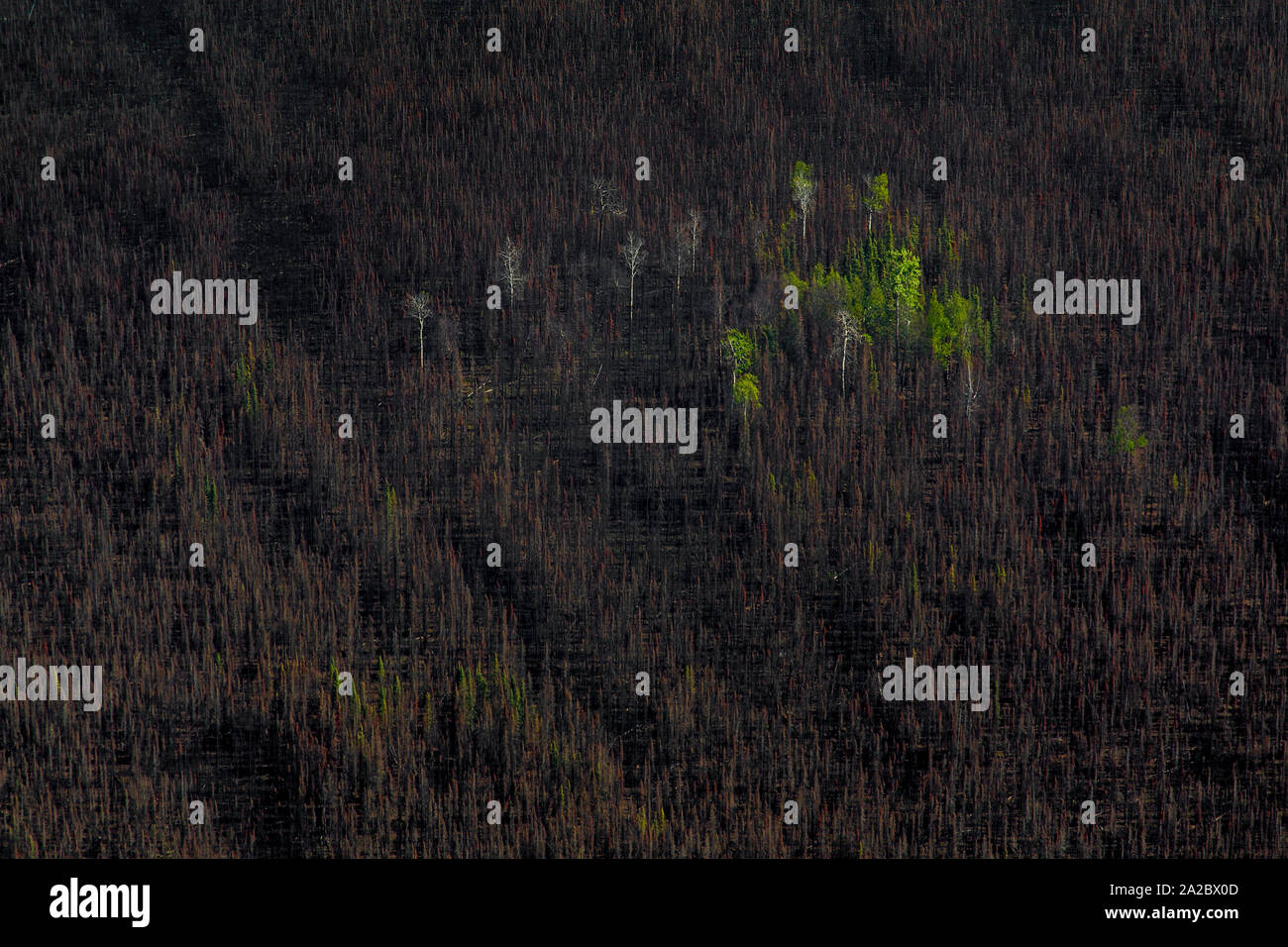 A patch of damaged forest near Anchorage in Alaska. The borealis forest – typically pine, birch and larch - make up about thirty percent of all forest in the world. Less efficient than rain forests, it’s still a vital part of the carbon sink. The mean temperature in the arctic areas are already 1.5c warmer than normal. Higher levels of CO2 accelerate growth of the forest. However; as growth is accellerated, the lifespan of the trees is shortened. The net result is a CO2 saturated forest that turn from being a carbon sink to emitter. Stock Photohttps://www.alamy.com/image-license-details/?v=1https://www.alamy.com/a-patch-of-damaged-forest-near-anchorage-in-alaska-the-borealis-forest-typically-pine-birch-and-larch-make-up-about-thirty-percent-of-all-forest-in-the-world-less-efficient-than-rain-forests-its-still-a-vital-part-of-the-carbon-sink-the-mean-temperature-in-the-arctic-areas-are-already-15c-warmer-than-normal-higher-levels-of-co2-accelerate-growth-of-the-forest-however-as-growth-is-accellerated-the-lifespan-of-the-trees-is-shortened-the-net-result-is-a-co2-saturated-forest-that-turn-from-being-a-carbon-sink-to-emitter-image328488173.html
A patch of damaged forest near Anchorage in Alaska. The borealis forest – typically pine, birch and larch - make up about thirty percent of all forest in the world. Less efficient than rain forests, it’s still a vital part of the carbon sink. The mean temperature in the arctic areas are already 1.5c warmer than normal. Higher levels of CO2 accelerate growth of the forest. However; as growth is accellerated, the lifespan of the trees is shortened. The net result is a CO2 saturated forest that turn from being a carbon sink to emitter. Stock Photohttps://www.alamy.com/image-license-details/?v=1https://www.alamy.com/a-patch-of-damaged-forest-near-anchorage-in-alaska-the-borealis-forest-typically-pine-birch-and-larch-make-up-about-thirty-percent-of-all-forest-in-the-world-less-efficient-than-rain-forests-its-still-a-vital-part-of-the-carbon-sink-the-mean-temperature-in-the-arctic-areas-are-already-15c-warmer-than-normal-higher-levels-of-co2-accelerate-growth-of-the-forest-however-as-growth-is-accellerated-the-lifespan-of-the-trees-is-shortened-the-net-result-is-a-co2-saturated-forest-that-turn-from-being-a-carbon-sink-to-emitter-image328488173.htmlRM2A2BX0D–A patch of damaged forest near Anchorage in Alaska. The borealis forest – typically pine, birch and larch - make up about thirty percent of all forest in the world. Less efficient than rain forests, it’s still a vital part of the carbon sink. The mean temperature in the arctic areas are already 1.5c warmer than normal. Higher levels of CO2 accelerate growth of the forest. However; as growth is accellerated, the lifespan of the trees is shortened. The net result is a CO2 saturated forest that turn from being a carbon sink to emitter.
 Global warming, climate change, human-induced, emissions, greenhouse gases, soil erosion, large-scale, weather, shifts, gradual heating, earth surface Stock Photohttps://www.alamy.com/image-license-details/?v=1https://www.alamy.com/global-warming-climate-change-human-induced-emissions-greenhouse-gases-soil-erosion-large-scale-weather-shifts-gradual-heating-earth-surface-image433174210.html
Global warming, climate change, human-induced, emissions, greenhouse gases, soil erosion, large-scale, weather, shifts, gradual heating, earth surface Stock Photohttps://www.alamy.com/image-license-details/?v=1https://www.alamy.com/global-warming-climate-change-human-induced-emissions-greenhouse-gases-soil-erosion-large-scale-weather-shifts-gradual-heating-earth-surface-image433174210.htmlRF2G4MP3E–Global warming, climate change, human-induced, emissions, greenhouse gases, soil erosion, large-scale, weather, shifts, gradual heating, earth surface
 People wearing polar bear costumes are seen while activists stage a demonstration near the Eiffel Tower in Paris, France, on December 12, 2015. A proposed 195-nation accord to curb emissions of the heat-trapping gases that threaten to wreak havoc on Earth's climate system is to be presented at the United Nations conference on climate change COP21 in Le Bourget, on the outskirts of Paris. Photo by Alain Apaydin/ABACAPRESS.COM Stock Photohttps://www.alamy.com/image-license-details/?v=1https://www.alamy.com/people-wearing-polar-bear-costumes-are-seen-while-activists-stage-a-demonstration-near-the-eiffel-tower-in-paris-france-on-december-12-2015-a-proposed-195-nation-accord-to-curb-emissions-of-the-heat-trapping-gases-that-threaten-to-wreak-havoc-on-earths-climate-system-is-to-be-presented-at-the-united-nations-conference-on-climate-change-cop21-in-le-bourget-on-the-outskirts-of-paris-photo-by-alain-apaydinabacapresscom-image393009029.html
People wearing polar bear costumes are seen while activists stage a demonstration near the Eiffel Tower in Paris, France, on December 12, 2015. A proposed 195-nation accord to curb emissions of the heat-trapping gases that threaten to wreak havoc on Earth's climate system is to be presented at the United Nations conference on climate change COP21 in Le Bourget, on the outskirts of Paris. Photo by Alain Apaydin/ABACAPRESS.COM Stock Photohttps://www.alamy.com/image-license-details/?v=1https://www.alamy.com/people-wearing-polar-bear-costumes-are-seen-while-activists-stage-a-demonstration-near-the-eiffel-tower-in-paris-france-on-december-12-2015-a-proposed-195-nation-accord-to-curb-emissions-of-the-heat-trapping-gases-that-threaten-to-wreak-havoc-on-earths-climate-system-is-to-be-presented-at-the-united-nations-conference-on-climate-change-cop21-in-le-bourget-on-the-outskirts-of-paris-photo-by-alain-apaydinabacapresscom-image393009029.htmlRM2DRB30N–People wearing polar bear costumes are seen while activists stage a demonstration near the Eiffel Tower in Paris, France, on December 12, 2015. A proposed 195-nation accord to curb emissions of the heat-trapping gases that threaten to wreak havoc on Earth's climate system is to be presented at the United Nations conference on climate change COP21 in Le Bourget, on the outskirts of Paris. Photo by Alain Apaydin/ABACAPRESS.COM
 A patch of damaged forest near Anchorage in Alaska. The borealis forest – typically pine, birch and larch - make up about thirty percent of all forest in the world. Less efficient than rain forests, it’s still a vital part of the carbon sink. The mean temperature in the arctic areas are already 1.5c warmer than normal. Higher levels of CO2 accelerate growth of the forest. However; as growth is accellerated, the lifespan of the trees is shortened. The net result is a CO2 saturated forest that turn from being a carbon sink to emitter. Stock Photohttps://www.alamy.com/image-license-details/?v=1https://www.alamy.com/a-patch-of-damaged-forest-near-anchorage-in-alaska-the-borealis-forest-typically-pine-birch-and-larch-make-up-about-thirty-percent-of-all-forest-in-the-world-less-efficient-than-rain-forests-its-still-a-vital-part-of-the-carbon-sink-the-mean-temperature-in-the-arctic-areas-are-already-15c-warmer-than-normal-higher-levels-of-co2-accelerate-growth-of-the-forest-however-as-growth-is-accellerated-the-lifespan-of-the-trees-is-shortened-the-net-result-is-a-co2-saturated-forest-that-turn-from-being-a-carbon-sink-to-emitter-image328488170.html
A patch of damaged forest near Anchorage in Alaska. The borealis forest – typically pine, birch and larch - make up about thirty percent of all forest in the world. Less efficient than rain forests, it’s still a vital part of the carbon sink. The mean temperature in the arctic areas are already 1.5c warmer than normal. Higher levels of CO2 accelerate growth of the forest. However; as growth is accellerated, the lifespan of the trees is shortened. The net result is a CO2 saturated forest that turn from being a carbon sink to emitter. Stock Photohttps://www.alamy.com/image-license-details/?v=1https://www.alamy.com/a-patch-of-damaged-forest-near-anchorage-in-alaska-the-borealis-forest-typically-pine-birch-and-larch-make-up-about-thirty-percent-of-all-forest-in-the-world-less-efficient-than-rain-forests-its-still-a-vital-part-of-the-carbon-sink-the-mean-temperature-in-the-arctic-areas-are-already-15c-warmer-than-normal-higher-levels-of-co2-accelerate-growth-of-the-forest-however-as-growth-is-accellerated-the-lifespan-of-the-trees-is-shortened-the-net-result-is-a-co2-saturated-forest-that-turn-from-being-a-carbon-sink-to-emitter-image328488170.htmlRM2A2BX0A–A patch of damaged forest near Anchorage in Alaska. The borealis forest – typically pine, birch and larch - make up about thirty percent of all forest in the world. Less efficient than rain forests, it’s still a vital part of the carbon sink. The mean temperature in the arctic areas are already 1.5c warmer than normal. Higher levels of CO2 accelerate growth of the forest. However; as growth is accellerated, the lifespan of the trees is shortened. The net result is a CO2 saturated forest that turn from being a carbon sink to emitter.
 A freight train transporting oil from the Bakken field near Williston in North Dakota. The area is part of the Bakken oil field, where fracking technology has made it profitable as long as the oil price stays above USD 46 per barrel. Stock Photohttps://www.alamy.com/image-license-details/?v=1https://www.alamy.com/a-freight-train-transporting-oil-from-the-bakken-field-near-williston-in-north-dakota-the-area-is-part-of-the-bakken-oil-field-where-fracking-technology-has-made-it-profitable-as-long-as-the-oil-price-stays-above-usd-46-per-barrel-image348476776.html
A freight train transporting oil from the Bakken field near Williston in North Dakota. The area is part of the Bakken oil field, where fracking technology has made it profitable as long as the oil price stays above USD 46 per barrel. Stock Photohttps://www.alamy.com/image-license-details/?v=1https://www.alamy.com/a-freight-train-transporting-oil-from-the-bakken-field-near-williston-in-north-dakota-the-area-is-part-of-the-bakken-oil-field-where-fracking-technology-has-made-it-profitable-as-long-as-the-oil-price-stays-above-usd-46-per-barrel-image348476776.htmlRM2B6XDK4–A freight train transporting oil from the Bakken field near Williston in North Dakota. The area is part of the Bakken oil field, where fracking technology has made it profitable as long as the oil price stays above USD 46 per barrel.
 A pumpjack on an oil well outside Williston in North Dakota. The area is part of the Bakken oil field, where fracking technology has made it profitable as long as the oil price stays above USD 46 per barrel. Stock Photohttps://www.alamy.com/image-license-details/?v=1https://www.alamy.com/a-pumpjack-on-an-oil-well-outside-williston-in-north-dakota-the-area-is-part-of-the-bakken-oil-field-where-fracking-technology-has-made-it-profitable-as-long-as-the-oil-price-stays-above-usd-46-per-barrel-image348477213.html
A pumpjack on an oil well outside Williston in North Dakota. The area is part of the Bakken oil field, where fracking technology has made it profitable as long as the oil price stays above USD 46 per barrel. Stock Photohttps://www.alamy.com/image-license-details/?v=1https://www.alamy.com/a-pumpjack-on-an-oil-well-outside-williston-in-north-dakota-the-area-is-part-of-the-bakken-oil-field-where-fracking-technology-has-made-it-profitable-as-long-as-the-oil-price-stays-above-usd-46-per-barrel-image348477213.htmlRM2B6XE6N–A pumpjack on an oil well outside Williston in North Dakota. The area is part of the Bakken oil field, where fracking technology has made it profitable as long as the oil price stays above USD 46 per barrel.
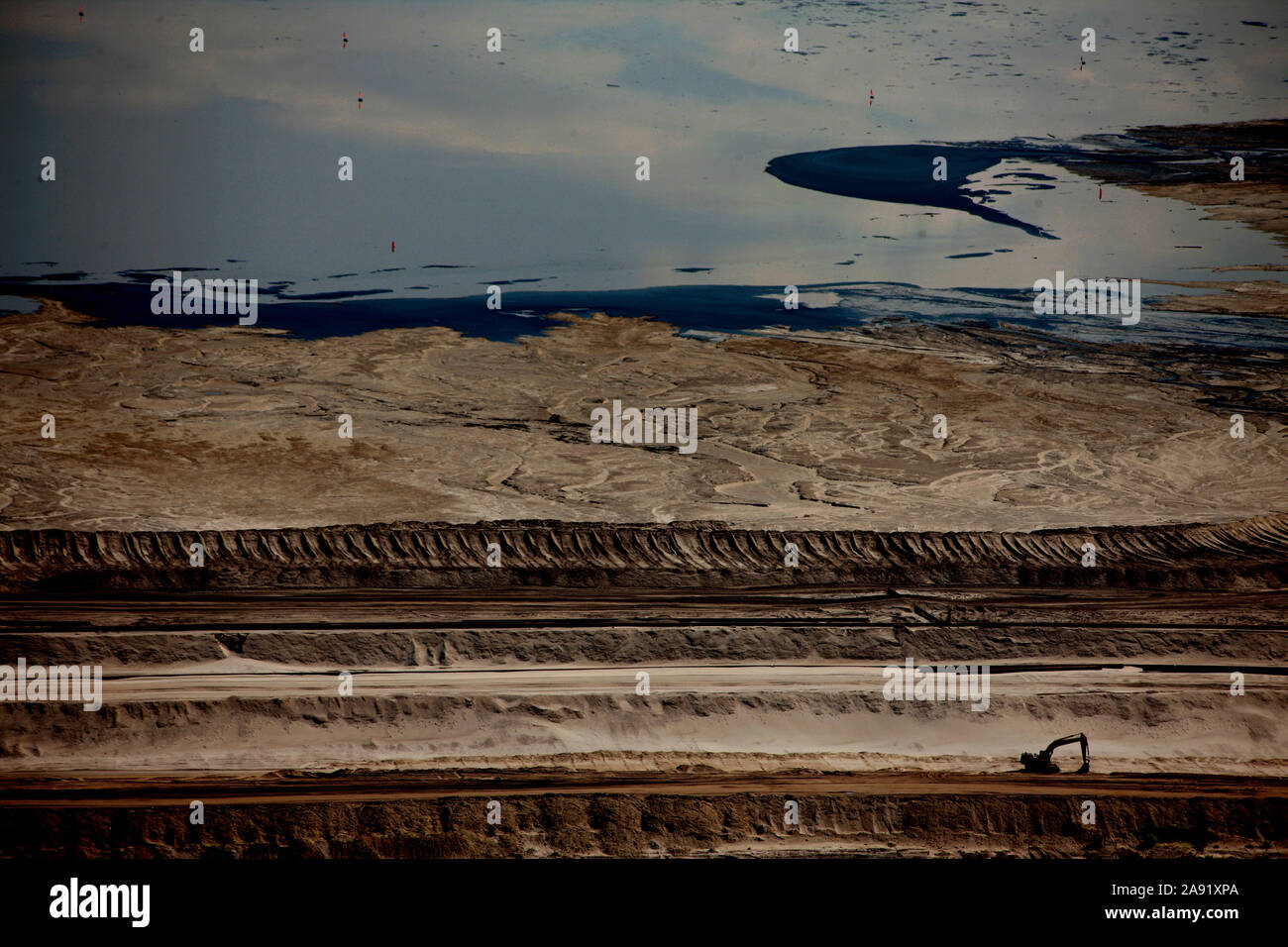 Bulldozers and earth movers are spreading the toxic waste in one of the enormous tailings ponds in Fort McMurray in Alberta, Canada. The ponds are among the largest man made structures in the world, spanning more than 175 square kilometres. They pose an added challenge to the oil sands production: even after ended production, it can take up to 30 years for the silt in the ponds to dry up. The contaminated water is toxic to any living creatures. The Athabasca oil sands deposit is among the largest in the world. The bitumen, also commonly named tar (hence tar sands), contains lots of hydrocarbo Stock Photohttps://www.alamy.com/image-license-details/?v=1https://www.alamy.com/bulldozers-and-earth-movers-are-spreading-the-toxic-waste-in-one-of-the-enormous-tailings-ponds-in-fort-mcmurray-in-alberta-canada-the-ponds-are-among-the-largest-man-made-structures-in-the-world-spanning-more-than-175-square-kilometres-they-pose-an-added-challenge-to-the-oil-sands-production-even-after-ended-production-it-can-take-up-to-30-years-for-the-silt-in-the-ponds-to-dry-up-the-contaminated-water-is-toxic-to-any-living-creatures-the-athabasca-oil-sands-deposit-is-among-the-largest-in-the-world-the-bitumen-also-commonly-named-tar-hence-tar-sands-contains-lots-of-hydrocarbo-image332571858.html
Bulldozers and earth movers are spreading the toxic waste in one of the enormous tailings ponds in Fort McMurray in Alberta, Canada. The ponds are among the largest man made structures in the world, spanning more than 175 square kilometres. They pose an added challenge to the oil sands production: even after ended production, it can take up to 30 years for the silt in the ponds to dry up. The contaminated water is toxic to any living creatures. The Athabasca oil sands deposit is among the largest in the world. The bitumen, also commonly named tar (hence tar sands), contains lots of hydrocarbo Stock Photohttps://www.alamy.com/image-license-details/?v=1https://www.alamy.com/bulldozers-and-earth-movers-are-spreading-the-toxic-waste-in-one-of-the-enormous-tailings-ponds-in-fort-mcmurray-in-alberta-canada-the-ponds-are-among-the-largest-man-made-structures-in-the-world-spanning-more-than-175-square-kilometres-they-pose-an-added-challenge-to-the-oil-sands-production-even-after-ended-production-it-can-take-up-to-30-years-for-the-silt-in-the-ponds-to-dry-up-the-contaminated-water-is-toxic-to-any-living-creatures-the-athabasca-oil-sands-deposit-is-among-the-largest-in-the-world-the-bitumen-also-commonly-named-tar-hence-tar-sands-contains-lots-of-hydrocarbo-image332571858.htmlRM2A91XPA–Bulldozers and earth movers are spreading the toxic waste in one of the enormous tailings ponds in Fort McMurray in Alberta, Canada. The ponds are among the largest man made structures in the world, spanning more than 175 square kilometres. They pose an added challenge to the oil sands production: even after ended production, it can take up to 30 years for the silt in the ponds to dry up. The contaminated water is toxic to any living creatures. The Athabasca oil sands deposit is among the largest in the world. The bitumen, also commonly named tar (hence tar sands), contains lots of hydrocarbo
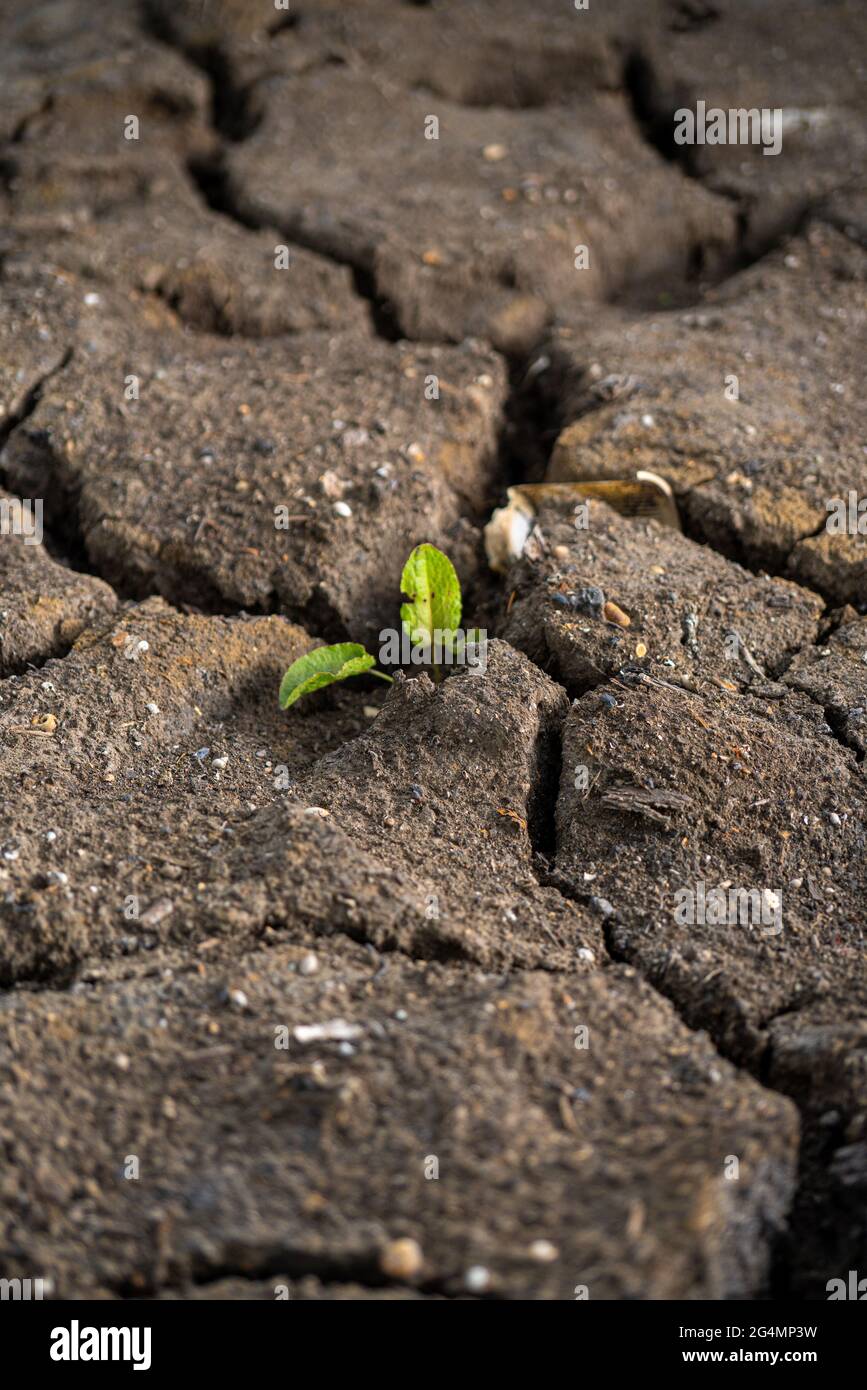 Global warming, climate change, human-induced, emissions, greenhouse gases, soil erosion, large-scale, weather, shifts, gradual heating, earth surface Stock Photohttps://www.alamy.com/image-license-details/?v=1https://www.alamy.com/global-warming-climate-change-human-induced-emissions-greenhouse-gases-soil-erosion-large-scale-weather-shifts-gradual-heating-earth-surface-image433174221.html
Global warming, climate change, human-induced, emissions, greenhouse gases, soil erosion, large-scale, weather, shifts, gradual heating, earth surface Stock Photohttps://www.alamy.com/image-license-details/?v=1https://www.alamy.com/global-warming-climate-change-human-induced-emissions-greenhouse-gases-soil-erosion-large-scale-weather-shifts-gradual-heating-earth-surface-image433174221.htmlRF2G4MP3W–Global warming, climate change, human-induced, emissions, greenhouse gases, soil erosion, large-scale, weather, shifts, gradual heating, earth surface
 Activists stage a demonstration near the Arc de Triomphe at the Avenue de la Grande Armee boulevard in Paris, France, on December 12, 2015. A proposed 195-nation accord to curb emissions of the heat-trapping gases that threaten to wreak havoc on Earth's climate system is to be presented at the United Nations conference on climate change COP21 in Le Bourget, on the outskirts of Paris. Photo by Somer/ABACAPRESS.COM Stock Photohttps://www.alamy.com/image-license-details/?v=1https://www.alamy.com/activists-stage-a-demonstration-near-the-arc-de-triomphe-at-the-avenue-de-la-grande-armee-boulevard-in-paris-france-on-december-12-2015-a-proposed-195-nation-accord-to-curb-emissions-of-the-heat-trapping-gases-that-threaten-to-wreak-havoc-on-earths-climate-system-is-to-be-presented-at-the-united-nations-conference-on-climate-change-cop21-in-le-bourget-on-the-outskirts-of-paris-photo-by-somerabacapresscom-image393008988.html
Activists stage a demonstration near the Arc de Triomphe at the Avenue de la Grande Armee boulevard in Paris, France, on December 12, 2015. A proposed 195-nation accord to curb emissions of the heat-trapping gases that threaten to wreak havoc on Earth's climate system is to be presented at the United Nations conference on climate change COP21 in Le Bourget, on the outskirts of Paris. Photo by Somer/ABACAPRESS.COM Stock Photohttps://www.alamy.com/image-license-details/?v=1https://www.alamy.com/activists-stage-a-demonstration-near-the-arc-de-triomphe-at-the-avenue-de-la-grande-armee-boulevard-in-paris-france-on-december-12-2015-a-proposed-195-nation-accord-to-curb-emissions-of-the-heat-trapping-gases-that-threaten-to-wreak-havoc-on-earths-climate-system-is-to-be-presented-at-the-united-nations-conference-on-climate-change-cop21-in-le-bourget-on-the-outskirts-of-paris-photo-by-somerabacapresscom-image393008988.htmlRM2DRB2Y8–Activists stage a demonstration near the Arc de Triomphe at the Avenue de la Grande Armee boulevard in Paris, France, on December 12, 2015. A proposed 195-nation accord to curb emissions of the heat-trapping gases that threaten to wreak havoc on Earth's climate system is to be presented at the United Nations conference on climate change COP21 in Le Bourget, on the outskirts of Paris. Photo by Somer/ABACAPRESS.COM
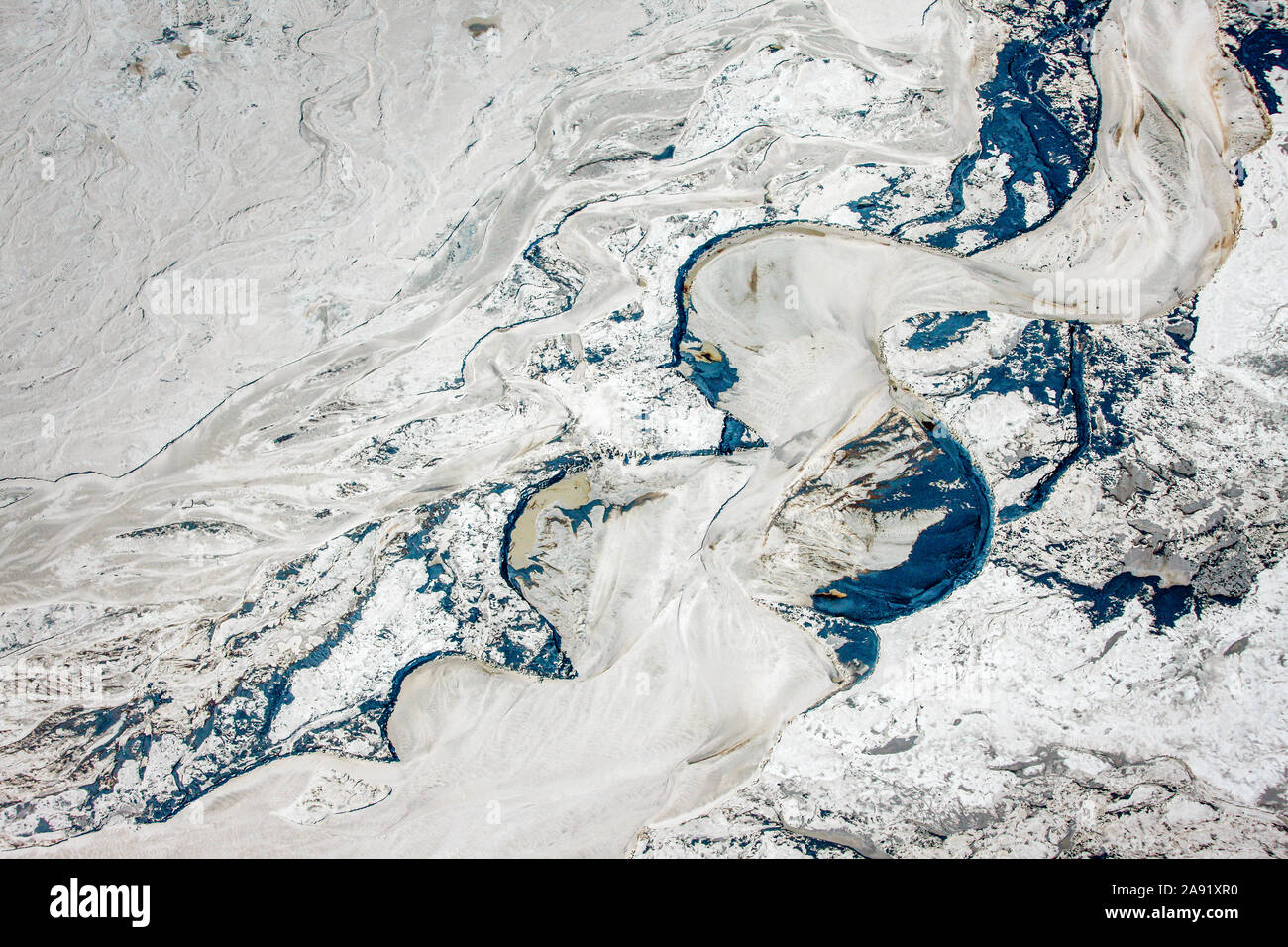 Detail from one of the enormous tailings ponds in Fort McMurray in Alberta, Canada. The ponds are among the largest man made structures in the world, spanning more than 175 square kilometres. They pose an added challenge to the oil sands production: even after ended production, it can take up to 30 years for the silt in the ponds to dry up. The contaminated water is toxic to any living creatures. The Athabasca oil sands deposit is among the largest in the world. The bitumen, also commonly named tar (hence tar sands), contains lots of hydrocarbons, but is notoriously hard to extract. For every Stock Photohttps://www.alamy.com/image-license-details/?v=1https://www.alamy.com/detail-from-one-of-the-enormous-tailings-ponds-in-fort-mcmurray-in-alberta-canada-the-ponds-are-among-the-largest-man-made-structures-in-the-world-spanning-more-than-175-square-kilometres-they-pose-an-added-challenge-to-the-oil-sands-production-even-after-ended-production-it-can-take-up-to-30-years-for-the-silt-in-the-ponds-to-dry-up-the-contaminated-water-is-toxic-to-any-living-creatures-the-athabasca-oil-sands-deposit-is-among-the-largest-in-the-world-the-bitumen-also-commonly-named-tar-hence-tar-sands-contains-lots-of-hydrocarbons-but-is-notoriously-hard-to-extract-for-every-image332571876.html
Detail from one of the enormous tailings ponds in Fort McMurray in Alberta, Canada. The ponds are among the largest man made structures in the world, spanning more than 175 square kilometres. They pose an added challenge to the oil sands production: even after ended production, it can take up to 30 years for the silt in the ponds to dry up. The contaminated water is toxic to any living creatures. The Athabasca oil sands deposit is among the largest in the world. The bitumen, also commonly named tar (hence tar sands), contains lots of hydrocarbons, but is notoriously hard to extract. For every Stock Photohttps://www.alamy.com/image-license-details/?v=1https://www.alamy.com/detail-from-one-of-the-enormous-tailings-ponds-in-fort-mcmurray-in-alberta-canada-the-ponds-are-among-the-largest-man-made-structures-in-the-world-spanning-more-than-175-square-kilometres-they-pose-an-added-challenge-to-the-oil-sands-production-even-after-ended-production-it-can-take-up-to-30-years-for-the-silt-in-the-ponds-to-dry-up-the-contaminated-water-is-toxic-to-any-living-creatures-the-athabasca-oil-sands-deposit-is-among-the-largest-in-the-world-the-bitumen-also-commonly-named-tar-hence-tar-sands-contains-lots-of-hydrocarbons-but-is-notoriously-hard-to-extract-for-every-image332571876.htmlRM2A91XR0–Detail from one of the enormous tailings ponds in Fort McMurray in Alberta, Canada. The ponds are among the largest man made structures in the world, spanning more than 175 square kilometres. They pose an added challenge to the oil sands production: even after ended production, it can take up to 30 years for the silt in the ponds to dry up. The contaminated water is toxic to any living creatures. The Athabasca oil sands deposit is among the largest in the world. The bitumen, also commonly named tar (hence tar sands), contains lots of hydrocarbons, but is notoriously hard to extract. For every
 People wearing polar bear costumes are seen while activists stage a demonstration near the Eiffel Tower in Paris, France, on December 12, 2015. A proposed 195-nation accord to curb emissions of the heat-trapping gases that threaten to wreak havoc on Earth's climate system is to be presented at the United Nations conference on climate change COP21 in Le Bourget, on the outskirts of Paris. Photo by Alain Apaydin/ABACAPRESS.COM Stock Photohttps://www.alamy.com/image-license-details/?v=1https://www.alamy.com/people-wearing-polar-bear-costumes-are-seen-while-activists-stage-a-demonstration-near-the-eiffel-tower-in-paris-france-on-december-12-2015-a-proposed-195-nation-accord-to-curb-emissions-of-the-heat-trapping-gases-that-threaten-to-wreak-havoc-on-earths-climate-system-is-to-be-presented-at-the-united-nations-conference-on-climate-change-cop21-in-le-bourget-on-the-outskirts-of-paris-photo-by-alain-apaydinabacapresscom-image393009017.html
People wearing polar bear costumes are seen while activists stage a demonstration near the Eiffel Tower in Paris, France, on December 12, 2015. A proposed 195-nation accord to curb emissions of the heat-trapping gases that threaten to wreak havoc on Earth's climate system is to be presented at the United Nations conference on climate change COP21 in Le Bourget, on the outskirts of Paris. Photo by Alain Apaydin/ABACAPRESS.COM Stock Photohttps://www.alamy.com/image-license-details/?v=1https://www.alamy.com/people-wearing-polar-bear-costumes-are-seen-while-activists-stage-a-demonstration-near-the-eiffel-tower-in-paris-france-on-december-12-2015-a-proposed-195-nation-accord-to-curb-emissions-of-the-heat-trapping-gases-that-threaten-to-wreak-havoc-on-earths-climate-system-is-to-be-presented-at-the-united-nations-conference-on-climate-change-cop21-in-le-bourget-on-the-outskirts-of-paris-photo-by-alain-apaydinabacapresscom-image393009017.htmlRM2DRB309–People wearing polar bear costumes are seen while activists stage a demonstration near the Eiffel Tower in Paris, France, on December 12, 2015. A proposed 195-nation accord to curb emissions of the heat-trapping gases that threaten to wreak havoc on Earth's climate system is to be presented at the United Nations conference on climate change COP21 in Le Bourget, on the outskirts of Paris. Photo by Alain Apaydin/ABACAPRESS.COM
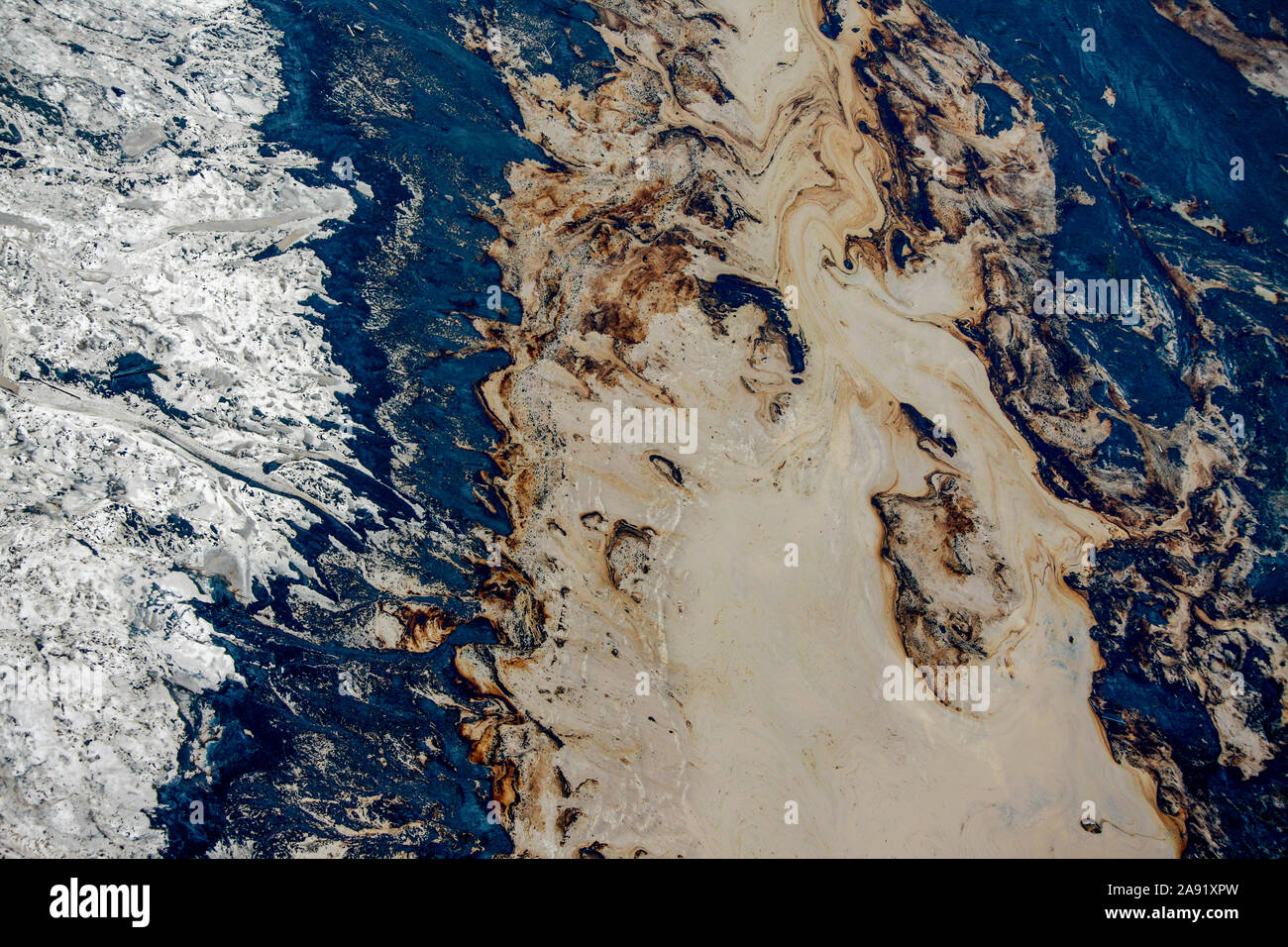 Detail from one of the enormous tailings ponds in Fort McMurray in Alberta, Canada. The ponds are among the largest man made structures in the world, spanning more than 175 square kilometres. They pose an added challenge to the oil sands production: even after ended production, it can take up to 30 years for the silt in the ponds to dry up. The contaminated water is toxic to any living creatures. The Athabasca oil sands deposit is among the largest in the world. The bitumen, also commonly named tar (hence tar sands), contains lots of hydrocarbons, but is notoriously hard to extract. For every Stock Photohttps://www.alamy.com/image-license-details/?v=1https://www.alamy.com/detail-from-one-of-the-enormous-tailings-ponds-in-fort-mcmurray-in-alberta-canada-the-ponds-are-among-the-largest-man-made-structures-in-the-world-spanning-more-than-175-square-kilometres-they-pose-an-added-challenge-to-the-oil-sands-production-even-after-ended-production-it-can-take-up-to-30-years-for-the-silt-in-the-ponds-to-dry-up-the-contaminated-water-is-toxic-to-any-living-creatures-the-athabasca-oil-sands-deposit-is-among-the-largest-in-the-world-the-bitumen-also-commonly-named-tar-hence-tar-sands-contains-lots-of-hydrocarbons-but-is-notoriously-hard-to-extract-for-every-image332571873.html
Detail from one of the enormous tailings ponds in Fort McMurray in Alberta, Canada. The ponds are among the largest man made structures in the world, spanning more than 175 square kilometres. They pose an added challenge to the oil sands production: even after ended production, it can take up to 30 years for the silt in the ponds to dry up. The contaminated water is toxic to any living creatures. The Athabasca oil sands deposit is among the largest in the world. The bitumen, also commonly named tar (hence tar sands), contains lots of hydrocarbons, but is notoriously hard to extract. For every Stock Photohttps://www.alamy.com/image-license-details/?v=1https://www.alamy.com/detail-from-one-of-the-enormous-tailings-ponds-in-fort-mcmurray-in-alberta-canada-the-ponds-are-among-the-largest-man-made-structures-in-the-world-spanning-more-than-175-square-kilometres-they-pose-an-added-challenge-to-the-oil-sands-production-even-after-ended-production-it-can-take-up-to-30-years-for-the-silt-in-the-ponds-to-dry-up-the-contaminated-water-is-toxic-to-any-living-creatures-the-athabasca-oil-sands-deposit-is-among-the-largest-in-the-world-the-bitumen-also-commonly-named-tar-hence-tar-sands-contains-lots-of-hydrocarbons-but-is-notoriously-hard-to-extract-for-every-image332571873.htmlRM2A91XPW–Detail from one of the enormous tailings ponds in Fort McMurray in Alberta, Canada. The ponds are among the largest man made structures in the world, spanning more than 175 square kilometres. They pose an added challenge to the oil sands production: even after ended production, it can take up to 30 years for the silt in the ponds to dry up. The contaminated water is toxic to any living creatures. The Athabasca oil sands deposit is among the largest in the world. The bitumen, also commonly named tar (hence tar sands), contains lots of hydrocarbons, but is notoriously hard to extract. For every
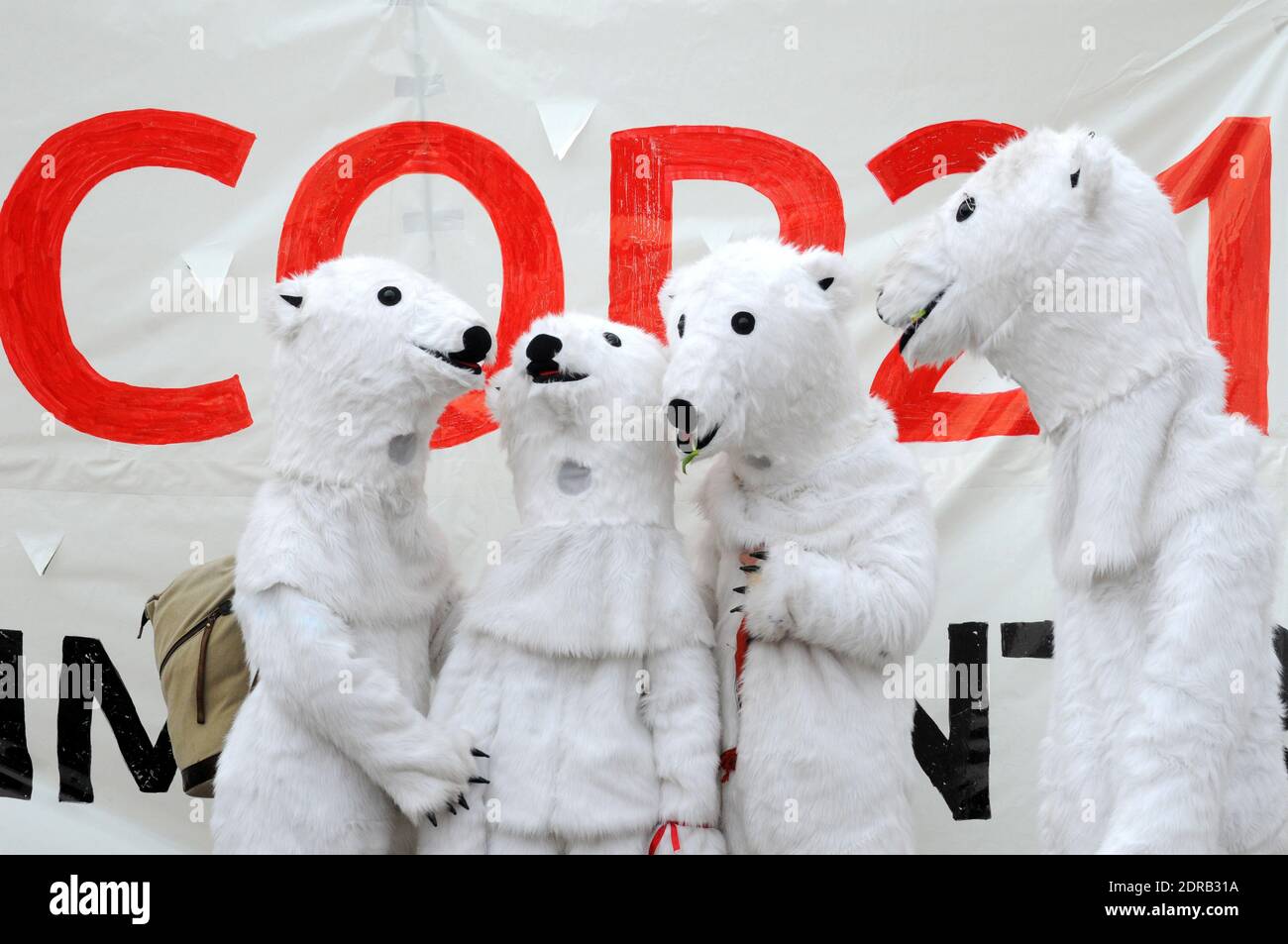 People wearing polar bear costumes are seen while activists stage a demonstration near the Eiffel Tower in Paris, France, on December 12, 2015. A proposed 195-nation accord to curb emissions of the heat-trapping gases that threaten to wreak havoc on Earth's climate system is to be presented at the United Nations conference on climate change COP21 in Le Bourget, on the outskirts of Paris. Photo by Alain Apaydin/ABACAPRESS.COM Stock Photohttps://www.alamy.com/image-license-details/?v=1https://www.alamy.com/people-wearing-polar-bear-costumes-are-seen-while-activists-stage-a-demonstration-near-the-eiffel-tower-in-paris-france-on-december-12-2015-a-proposed-195-nation-accord-to-curb-emissions-of-the-heat-trapping-gases-that-threaten-to-wreak-havoc-on-earths-climate-system-is-to-be-presented-at-the-united-nations-conference-on-climate-change-cop21-in-le-bourget-on-the-outskirts-of-paris-photo-by-alain-apaydinabacapresscom-image393009046.html
People wearing polar bear costumes are seen while activists stage a demonstration near the Eiffel Tower in Paris, France, on December 12, 2015. A proposed 195-nation accord to curb emissions of the heat-trapping gases that threaten to wreak havoc on Earth's climate system is to be presented at the United Nations conference on climate change COP21 in Le Bourget, on the outskirts of Paris. Photo by Alain Apaydin/ABACAPRESS.COM Stock Photohttps://www.alamy.com/image-license-details/?v=1https://www.alamy.com/people-wearing-polar-bear-costumes-are-seen-while-activists-stage-a-demonstration-near-the-eiffel-tower-in-paris-france-on-december-12-2015-a-proposed-195-nation-accord-to-curb-emissions-of-the-heat-trapping-gases-that-threaten-to-wreak-havoc-on-earths-climate-system-is-to-be-presented-at-the-united-nations-conference-on-climate-change-cop21-in-le-bourget-on-the-outskirts-of-paris-photo-by-alain-apaydinabacapresscom-image393009046.htmlRM2DRB31A–People wearing polar bear costumes are seen while activists stage a demonstration near the Eiffel Tower in Paris, France, on December 12, 2015. A proposed 195-nation accord to curb emissions of the heat-trapping gases that threaten to wreak havoc on Earth's climate system is to be presented at the United Nations conference on climate change COP21 in Le Bourget, on the outskirts of Paris. Photo by Alain Apaydin/ABACAPRESS.COM
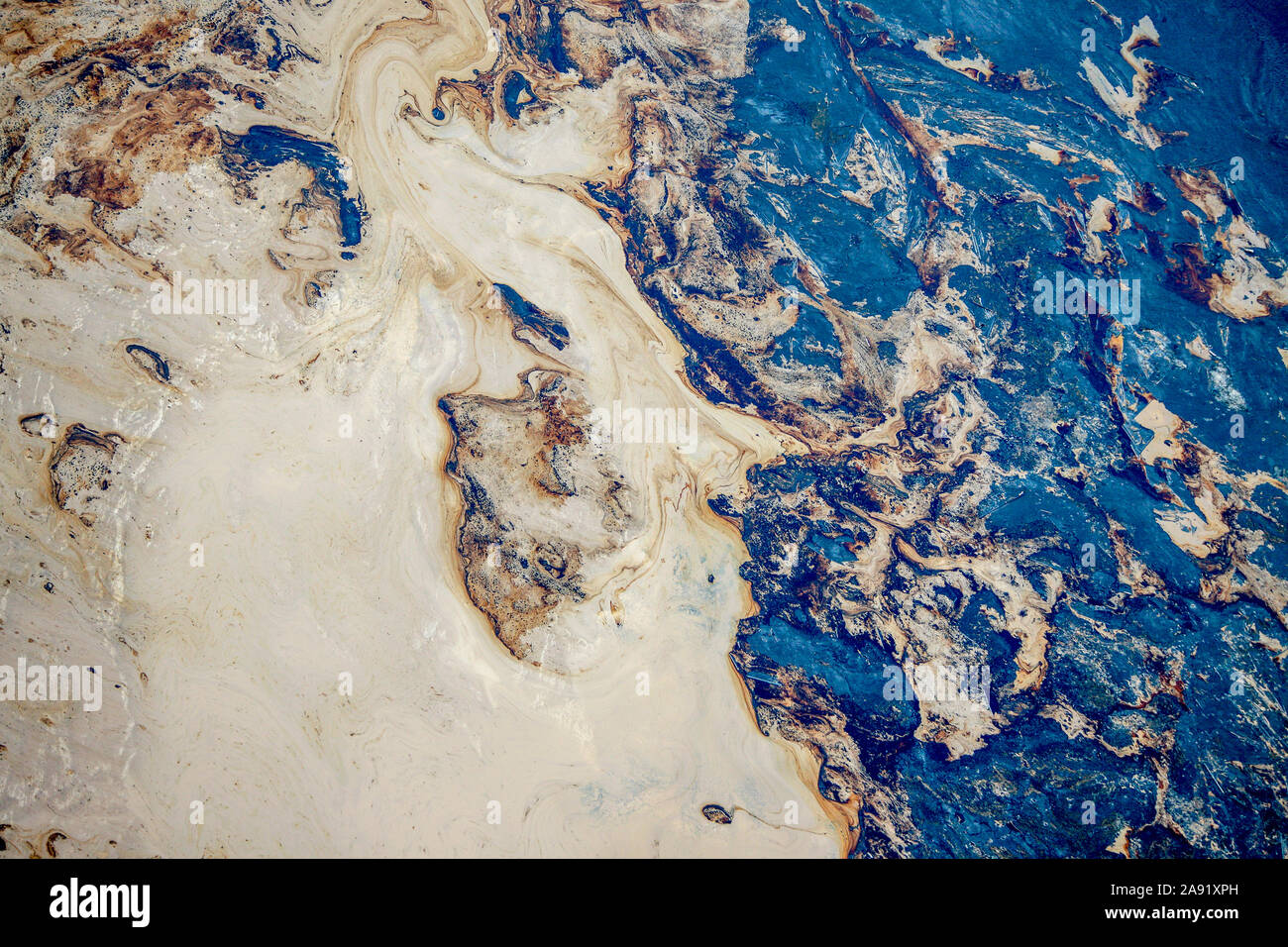 Detail from one of the enormous tailings ponds in Fort McMurray in Alberta, Canada. The ponds are among the largest man made structures in the world, spanning more than 175 square kilometres. They pose an added challenge to the oil sands production: even after ended production, it can take up to 30 years for the silt in the ponds to dry up. The contaminated water is toxic to any living creatures. The Athabasca oil sands deposit is among the largest in the world. The bitumen, also commonly named tar (hence tar sands), contains lots of hydrocarbons, but is notoriously hard to extract. For every Stock Photohttps://www.alamy.com/image-license-details/?v=1https://www.alamy.com/detail-from-one-of-the-enormous-tailings-ponds-in-fort-mcmurray-in-alberta-canada-the-ponds-are-among-the-largest-man-made-structures-in-the-world-spanning-more-than-175-square-kilometres-they-pose-an-added-challenge-to-the-oil-sands-production-even-after-ended-production-it-can-take-up-to-30-years-for-the-silt-in-the-ponds-to-dry-up-the-contaminated-water-is-toxic-to-any-living-creatures-the-athabasca-oil-sands-deposit-is-among-the-largest-in-the-world-the-bitumen-also-commonly-named-tar-hence-tar-sands-contains-lots-of-hydrocarbons-but-is-notoriously-hard-to-extract-for-every-image332571865.html
Detail from one of the enormous tailings ponds in Fort McMurray in Alberta, Canada. The ponds are among the largest man made structures in the world, spanning more than 175 square kilometres. They pose an added challenge to the oil sands production: even after ended production, it can take up to 30 years for the silt in the ponds to dry up. The contaminated water is toxic to any living creatures. The Athabasca oil sands deposit is among the largest in the world. The bitumen, also commonly named tar (hence tar sands), contains lots of hydrocarbons, but is notoriously hard to extract. For every Stock Photohttps://www.alamy.com/image-license-details/?v=1https://www.alamy.com/detail-from-one-of-the-enormous-tailings-ponds-in-fort-mcmurray-in-alberta-canada-the-ponds-are-among-the-largest-man-made-structures-in-the-world-spanning-more-than-175-square-kilometres-they-pose-an-added-challenge-to-the-oil-sands-production-even-after-ended-production-it-can-take-up-to-30-years-for-the-silt-in-the-ponds-to-dry-up-the-contaminated-water-is-toxic-to-any-living-creatures-the-athabasca-oil-sands-deposit-is-among-the-largest-in-the-world-the-bitumen-also-commonly-named-tar-hence-tar-sands-contains-lots-of-hydrocarbons-but-is-notoriously-hard-to-extract-for-every-image332571865.htmlRM2A91XPH–Detail from one of the enormous tailings ponds in Fort McMurray in Alberta, Canada. The ponds are among the largest man made structures in the world, spanning more than 175 square kilometres. They pose an added challenge to the oil sands production: even after ended production, it can take up to 30 years for the silt in the ponds to dry up. The contaminated water is toxic to any living creatures. The Athabasca oil sands deposit is among the largest in the world. The bitumen, also commonly named tar (hence tar sands), contains lots of hydrocarbons, but is notoriously hard to extract. For every
 Activists stage a demonstration near the Arc de Triomphe at the Avenue de la Grande Armee boulevard in Paris, France, on December 12, 2015. A proposed 195-nation accord to curb emissions of the heat-trapping gases that threaten to wreak havoc on Earth's climate system is to be presented at the United Nations conference on climate change COP21 in Le Bourget, on the outskirts of Paris. Photo by Somer/ABACAPRESS.COM Stock Photohttps://www.alamy.com/image-license-details/?v=1https://www.alamy.com/activists-stage-a-demonstration-near-the-arc-de-triomphe-at-the-avenue-de-la-grande-armee-boulevard-in-paris-france-on-december-12-2015-a-proposed-195-nation-accord-to-curb-emissions-of-the-heat-trapping-gases-that-threaten-to-wreak-havoc-on-earths-climate-system-is-to-be-presented-at-the-united-nations-conference-on-climate-change-cop21-in-le-bourget-on-the-outskirts-of-paris-photo-by-somerabacapresscom-image393009001.html
Activists stage a demonstration near the Arc de Triomphe at the Avenue de la Grande Armee boulevard in Paris, France, on December 12, 2015. A proposed 195-nation accord to curb emissions of the heat-trapping gases that threaten to wreak havoc on Earth's climate system is to be presented at the United Nations conference on climate change COP21 in Le Bourget, on the outskirts of Paris. Photo by Somer/ABACAPRESS.COM Stock Photohttps://www.alamy.com/image-license-details/?v=1https://www.alamy.com/activists-stage-a-demonstration-near-the-arc-de-triomphe-at-the-avenue-de-la-grande-armee-boulevard-in-paris-france-on-december-12-2015-a-proposed-195-nation-accord-to-curb-emissions-of-the-heat-trapping-gases-that-threaten-to-wreak-havoc-on-earths-climate-system-is-to-be-presented-at-the-united-nations-conference-on-climate-change-cop21-in-le-bourget-on-the-outskirts-of-paris-photo-by-somerabacapresscom-image393009001.htmlRM2DRB2YN–Activists stage a demonstration near the Arc de Triomphe at the Avenue de la Grande Armee boulevard in Paris, France, on December 12, 2015. A proposed 195-nation accord to curb emissions of the heat-trapping gases that threaten to wreak havoc on Earth's climate system is to be presented at the United Nations conference on climate change COP21 in Le Bourget, on the outskirts of Paris. Photo by Somer/ABACAPRESS.COM
 Pick up trucks pass trough one of the enormous tailings ponds in Fort McMurray in Alberta, Canada. The ponds are among the largest man made structures in the world, spanning more than 175 square kilometres. They pose an added challenge to the oil sands production: even after ended production, it can take up to 30 years for the silt in the ponds to dry up. The contaminated water is toxic to any living creatures. The Athabasca oil sands deposit is among the largest in the world. The bitumen, also commonly named tar (hence tar sands), contains lots of hydrocarbons, but is notoriously hard to ext Stock Photohttps://www.alamy.com/image-license-details/?v=1https://www.alamy.com/pick-up-trucks-pass-trough-one-of-the-enormous-tailings-ponds-in-fort-mcmurray-in-alberta-canada-the-ponds-are-among-the-largest-man-made-structures-in-the-world-spanning-more-than-175-square-kilometres-they-pose-an-added-challenge-to-the-oil-sands-production-even-after-ended-production-it-can-take-up-to-30-years-for-the-silt-in-the-ponds-to-dry-up-the-contaminated-water-is-toxic-to-any-living-creatures-the-athabasca-oil-sands-deposit-is-among-the-largest-in-the-world-the-bitumen-also-commonly-named-tar-hence-tar-sands-contains-lots-of-hydrocarbons-but-is-notoriously-hard-to-ext-image332571693.html
Pick up trucks pass trough one of the enormous tailings ponds in Fort McMurray in Alberta, Canada. The ponds are among the largest man made structures in the world, spanning more than 175 square kilometres. They pose an added challenge to the oil sands production: even after ended production, it can take up to 30 years for the silt in the ponds to dry up. The contaminated water is toxic to any living creatures. The Athabasca oil sands deposit is among the largest in the world. The bitumen, also commonly named tar (hence tar sands), contains lots of hydrocarbons, but is notoriously hard to ext Stock Photohttps://www.alamy.com/image-license-details/?v=1https://www.alamy.com/pick-up-trucks-pass-trough-one-of-the-enormous-tailings-ponds-in-fort-mcmurray-in-alberta-canada-the-ponds-are-among-the-largest-man-made-structures-in-the-world-spanning-more-than-175-square-kilometres-they-pose-an-added-challenge-to-the-oil-sands-production-even-after-ended-production-it-can-take-up-to-30-years-for-the-silt-in-the-ponds-to-dry-up-the-contaminated-water-is-toxic-to-any-living-creatures-the-athabasca-oil-sands-deposit-is-among-the-largest-in-the-world-the-bitumen-also-commonly-named-tar-hence-tar-sands-contains-lots-of-hydrocarbons-but-is-notoriously-hard-to-ext-image332571693.htmlRM2A91XGD–Pick up trucks pass trough one of the enormous tailings ponds in Fort McMurray in Alberta, Canada. The ponds are among the largest man made structures in the world, spanning more than 175 square kilometres. They pose an added challenge to the oil sands production: even after ended production, it can take up to 30 years for the silt in the ponds to dry up. The contaminated water is toxic to any living creatures. The Athabasca oil sands deposit is among the largest in the world. The bitumen, also commonly named tar (hence tar sands), contains lots of hydrocarbons, but is notoriously hard to ext
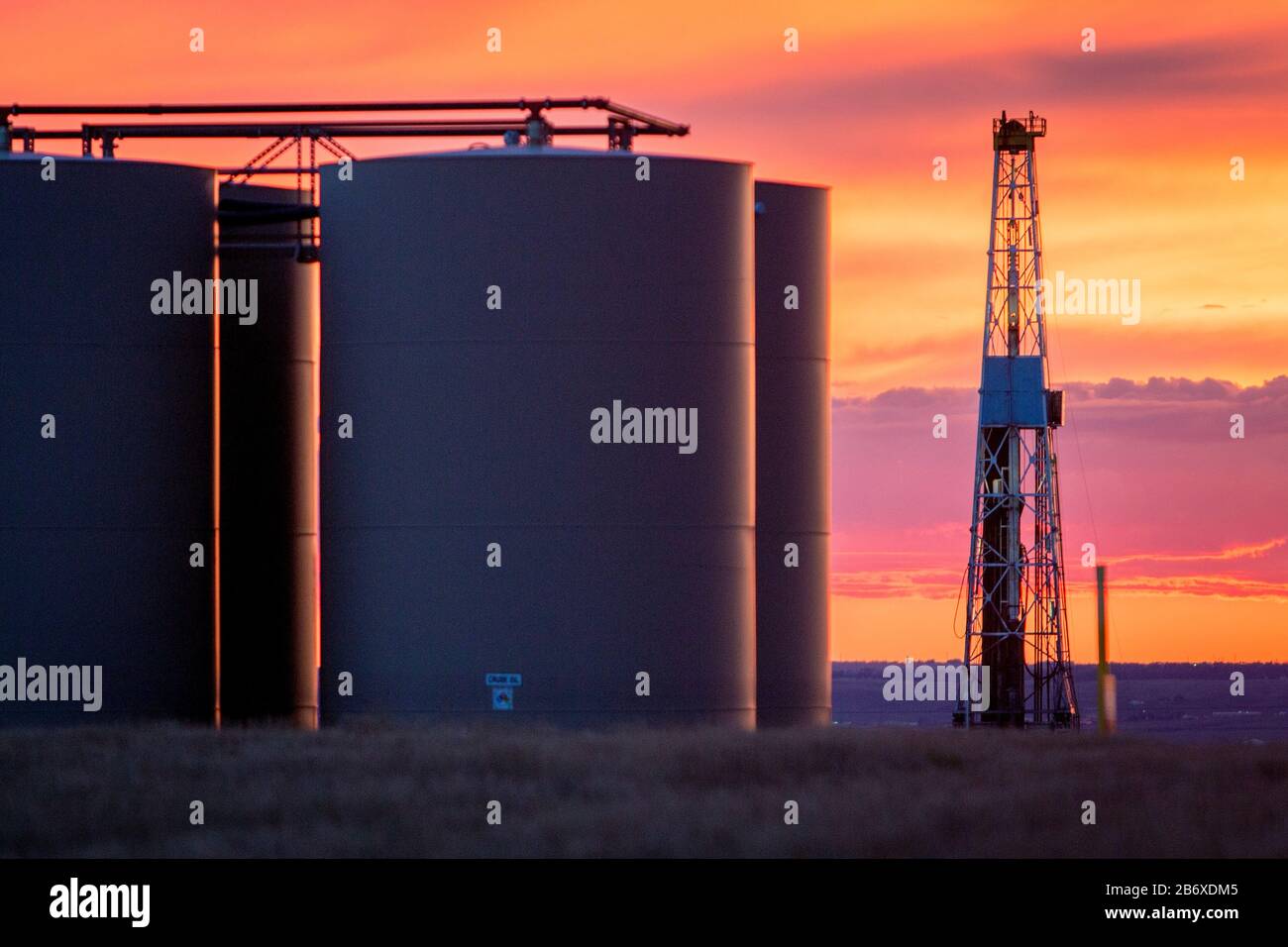 An oil rig and storage tanks outside Williston in North Dakota. The area is part of the Bakken oil field, where fracking technology has made it profitable as long as the oil price stays above USD 46 per barrel. Stock Photohttps://www.alamy.com/image-license-details/?v=1https://www.alamy.com/an-oil-rig-and-storage-tanks-outside-williston-in-north-dakota-the-area-is-part-of-the-bakken-oil-field-where-fracking-technology-has-made-it-profitable-as-long-as-the-oil-price-stays-above-usd-46-per-barrel-image348476805.html
An oil rig and storage tanks outside Williston in North Dakota. The area is part of the Bakken oil field, where fracking technology has made it profitable as long as the oil price stays above USD 46 per barrel. Stock Photohttps://www.alamy.com/image-license-details/?v=1https://www.alamy.com/an-oil-rig-and-storage-tanks-outside-williston-in-north-dakota-the-area-is-part-of-the-bakken-oil-field-where-fracking-technology-has-made-it-profitable-as-long-as-the-oil-price-stays-above-usd-46-per-barrel-image348476805.htmlRM2B6XDM5–An oil rig and storage tanks outside Williston in North Dakota. The area is part of the Bakken oil field, where fracking technology has made it profitable as long as the oil price stays above USD 46 per barrel.
 People wearing polar bear costumes are seen while activists stage a demonstration near the Eiffel Tower in Paris, France, on December 12, 2015. A proposed 195-nation accord to curb emissions of the heat-trapping gases that threaten to wreak havoc on Earth's climate system is to be presented at the United Nations conference on climate change COP21 in Le Bourget, on the outskirts of Paris. Photo by Alain Apaydin/ABACAPRESS.COM Stock Photohttps://www.alamy.com/image-license-details/?v=1https://www.alamy.com/people-wearing-polar-bear-costumes-are-seen-while-activists-stage-a-demonstration-near-the-eiffel-tower-in-paris-france-on-december-12-2015-a-proposed-195-nation-accord-to-curb-emissions-of-the-heat-trapping-gases-that-threaten-to-wreak-havoc-on-earths-climate-system-is-to-be-presented-at-the-united-nations-conference-on-climate-change-cop21-in-le-bourget-on-the-outskirts-of-paris-photo-by-alain-apaydinabacapresscom-image393009054.html
People wearing polar bear costumes are seen while activists stage a demonstration near the Eiffel Tower in Paris, France, on December 12, 2015. A proposed 195-nation accord to curb emissions of the heat-trapping gases that threaten to wreak havoc on Earth's climate system is to be presented at the United Nations conference on climate change COP21 in Le Bourget, on the outskirts of Paris. Photo by Alain Apaydin/ABACAPRESS.COM Stock Photohttps://www.alamy.com/image-license-details/?v=1https://www.alamy.com/people-wearing-polar-bear-costumes-are-seen-while-activists-stage-a-demonstration-near-the-eiffel-tower-in-paris-france-on-december-12-2015-a-proposed-195-nation-accord-to-curb-emissions-of-the-heat-trapping-gases-that-threaten-to-wreak-havoc-on-earths-climate-system-is-to-be-presented-at-the-united-nations-conference-on-climate-change-cop21-in-le-bourget-on-the-outskirts-of-paris-photo-by-alain-apaydinabacapresscom-image393009054.htmlRM2DRB31J–People wearing polar bear costumes are seen while activists stage a demonstration near the Eiffel Tower in Paris, France, on December 12, 2015. A proposed 195-nation accord to curb emissions of the heat-trapping gases that threaten to wreak havoc on Earth's climate system is to be presented at the United Nations conference on climate change COP21 in Le Bourget, on the outskirts of Paris. Photo by Alain Apaydin/ABACAPRESS.COM
 An old tiller sits in the foreground while the flames from the flaring of methane and gas from an oil well lights up in the background. The oil well is one of the many production wells right outside Williston in North Dakota. The area is part of the Bakken oil field, where fracking technology has made it profitable as long as the oil price stays above USD 46 per barrel. Stock Photohttps://www.alamy.com/image-license-details/?v=1https://www.alamy.com/an-old-tiller-sits-in-the-foreground-while-the-flames-from-the-flaring-of-methane-and-gas-from-an-oil-well-lights-up-in-the-background-the-oil-well-is-one-of-the-many-production-wells-right-outside-williston-in-north-dakota-the-area-is-part-of-the-bakken-oil-field-where-fracking-technology-has-made-it-profitable-as-long-as-the-oil-price-stays-above-usd-46-per-barrel-image348476789.html
An old tiller sits in the foreground while the flames from the flaring of methane and gas from an oil well lights up in the background. The oil well is one of the many production wells right outside Williston in North Dakota. The area is part of the Bakken oil field, where fracking technology has made it profitable as long as the oil price stays above USD 46 per barrel. Stock Photohttps://www.alamy.com/image-license-details/?v=1https://www.alamy.com/an-old-tiller-sits-in-the-foreground-while-the-flames-from-the-flaring-of-methane-and-gas-from-an-oil-well-lights-up-in-the-background-the-oil-well-is-one-of-the-many-production-wells-right-outside-williston-in-north-dakota-the-area-is-part-of-the-bakken-oil-field-where-fracking-technology-has-made-it-profitable-as-long-as-the-oil-price-stays-above-usd-46-per-barrel-image348476789.htmlRM2B6XDKH–An old tiller sits in the foreground while the flames from the flaring of methane and gas from an oil well lights up in the background. The oil well is one of the many production wells right outside Williston in North Dakota. The area is part of the Bakken oil field, where fracking technology has made it profitable as long as the oil price stays above USD 46 per barrel.
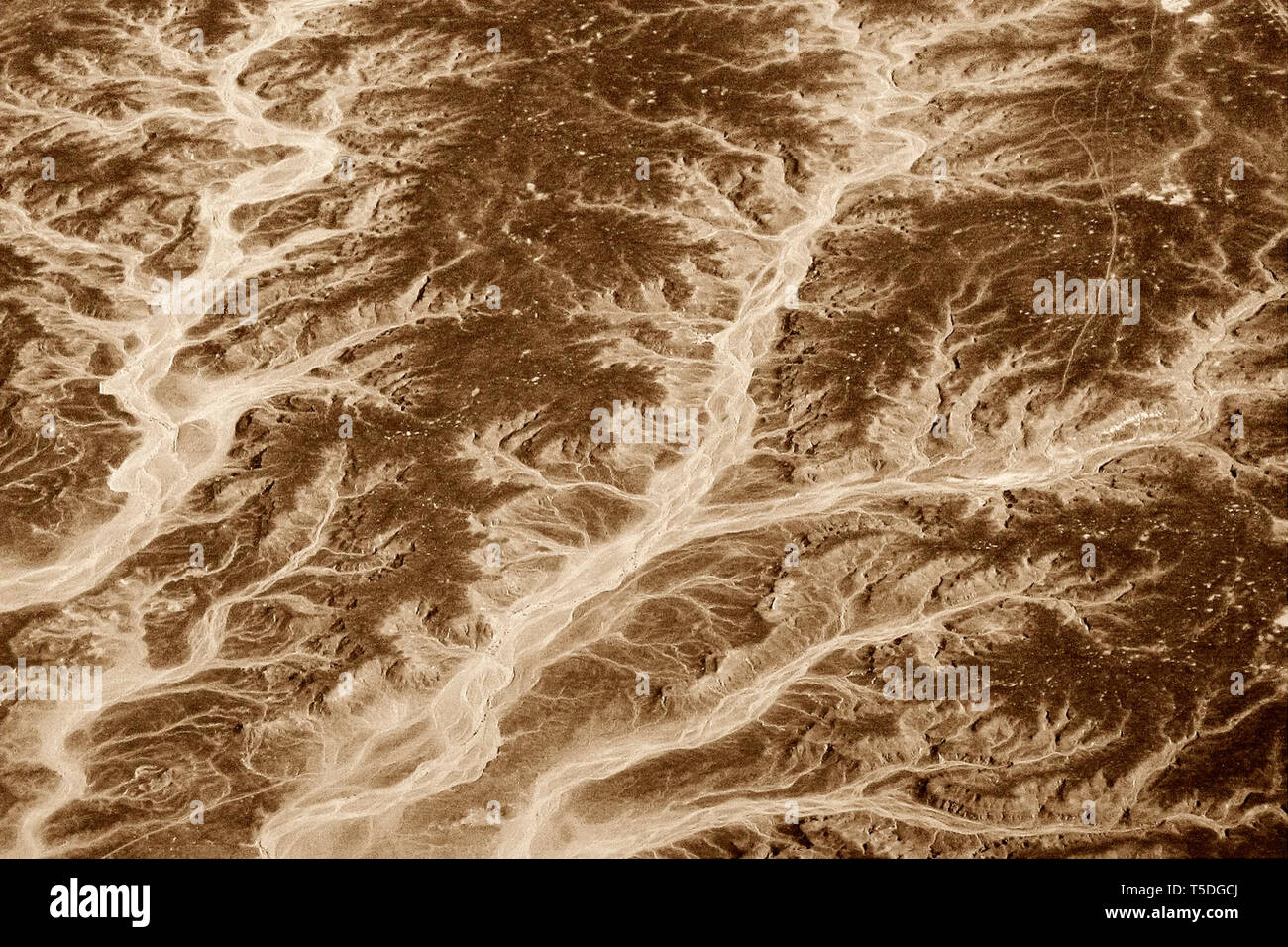 Photo by Orjan Ellingvag @ellingvag for @everydayclimatechange. Sahara expanding: The aerial picture from 2004 shows wadies, dried out riverbeds and animal tracks in a part of the Sahara Desert just north of Niamey in Niger in West Africa. According to a 2818 study by University of Maryland scientists, the Sahara desert has expanded by 10 percent over the last century. The study found that at least one third of the expansion is caused by human-caused climate change. The desert has always increased and decreased depending on the seasons, but the overall heating of the planet amplifies the expa Stock Photohttps://www.alamy.com/image-license-details/?v=1https://www.alamy.com/photo-by-orjan-ellingvag-@ellingvag-for-@everydayclimatechange-sahara-expanding-the-aerial-picture-from-2004-shows-wadies-dried-out-riverbeds-and-animal-tracks-in-a-part-of-the-sahara-desert-just-north-of-niamey-in-niger-in-west-africa-according-to-a-2818-study-by-university-of-maryland-scientists-the-sahara-desert-has-expanded-by-10-percent-over-the-last-century-the-study-found-that-at-least-one-third-of-the-expansion-is-caused-by-human-caused-climate-change-the-desert-has-always-increased-and-decreased-depending-on-the-seasons-but-the-overall-heating-of-the-planet-amplifies-the-expa-image244316706.html
Photo by Orjan Ellingvag @ellingvag for @everydayclimatechange. Sahara expanding: The aerial picture from 2004 shows wadies, dried out riverbeds and animal tracks in a part of the Sahara Desert just north of Niamey in Niger in West Africa. According to a 2818 study by University of Maryland scientists, the Sahara desert has expanded by 10 percent over the last century. The study found that at least one third of the expansion is caused by human-caused climate change. The desert has always increased and decreased depending on the seasons, but the overall heating of the planet amplifies the expa Stock Photohttps://www.alamy.com/image-license-details/?v=1https://www.alamy.com/photo-by-orjan-ellingvag-@ellingvag-for-@everydayclimatechange-sahara-expanding-the-aerial-picture-from-2004-shows-wadies-dried-out-riverbeds-and-animal-tracks-in-a-part-of-the-sahara-desert-just-north-of-niamey-in-niger-in-west-africa-according-to-a-2818-study-by-university-of-maryland-scientists-the-sahara-desert-has-expanded-by-10-percent-over-the-last-century-the-study-found-that-at-least-one-third-of-the-expansion-is-caused-by-human-caused-climate-change-the-desert-has-always-increased-and-decreased-depending-on-the-seasons-but-the-overall-heating-of-the-planet-amplifies-the-expa-image244316706.htmlRMT5DGCJ–Photo by Orjan Ellingvag @ellingvag for @everydayclimatechange. Sahara expanding: The aerial picture from 2004 shows wadies, dried out riverbeds and animal tracks in a part of the Sahara Desert just north of Niamey in Niger in West Africa. According to a 2818 study by University of Maryland scientists, the Sahara desert has expanded by 10 percent over the last century. The study found that at least one third of the expansion is caused by human-caused climate change. The desert has always increased and decreased depending on the seasons, but the overall heating of the planet amplifies the expa
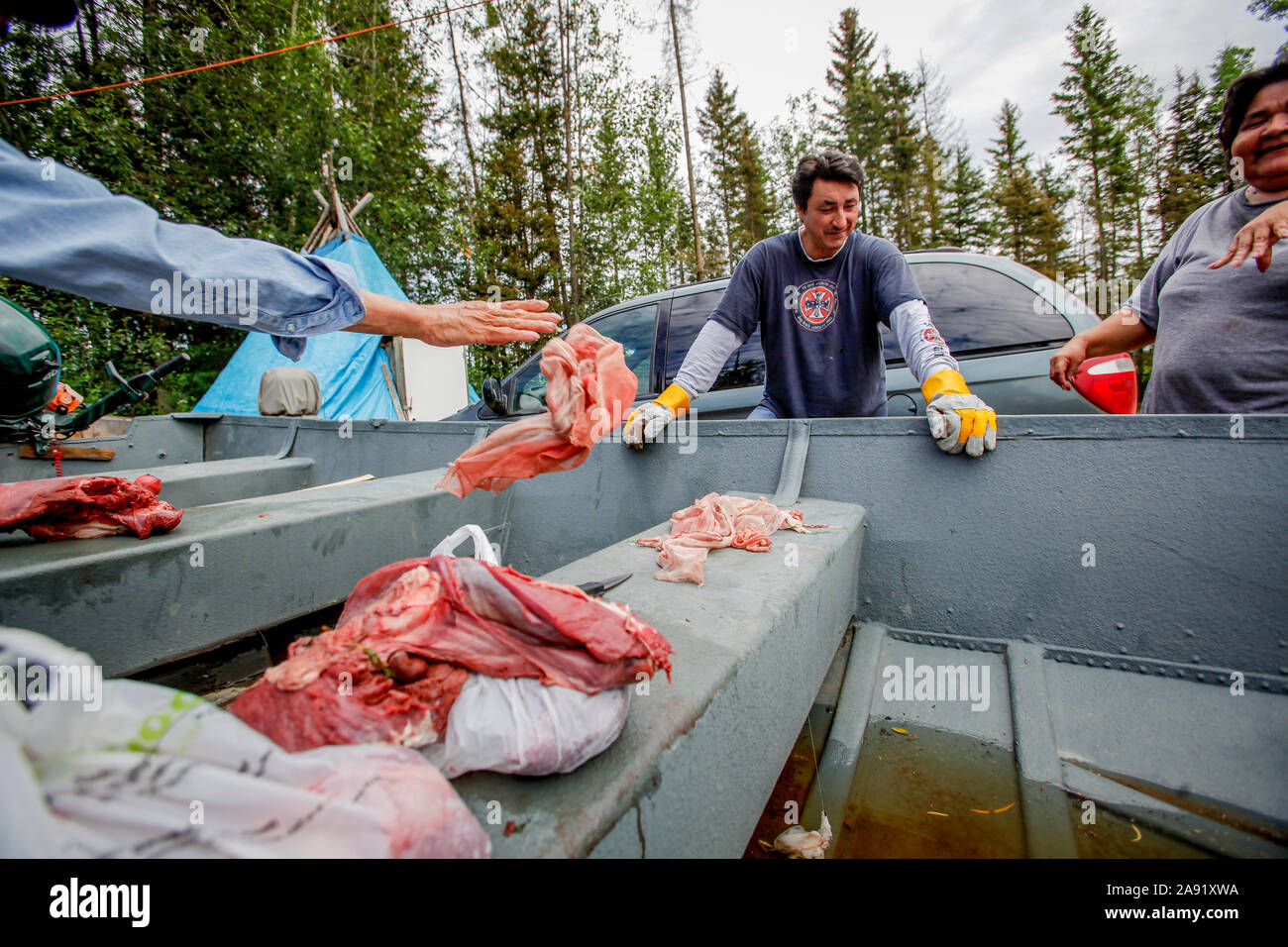 The Chipewyan band of First Nation that lives in Fort McKay are worried about the environmental impact of allowing the oil sand companies to operate in their neighborhood. Dennis LeCorde talks of twoheaded fish in the Athabasca River. His brother Howard LeCorde cuts meat from a freshly killed moose. Stock Photohttps://www.alamy.com/image-license-details/?v=1https://www.alamy.com/the-chipewyan-band-of-first-nation-that-lives-in-fort-mckay-are-worried-about-the-environmental-impact-of-allowing-the-oil-sand-companies-to-operate-in-their-neighborhood-dennis-lecorde-talks-of-twoheaded-fish-in-the-athabasca-river-his-brother-howard-lecorde-cuts-meat-from-a-freshly-killed-moose-image332571942.html
The Chipewyan band of First Nation that lives in Fort McKay are worried about the environmental impact of allowing the oil sand companies to operate in their neighborhood. Dennis LeCorde talks of twoheaded fish in the Athabasca River. His brother Howard LeCorde cuts meat from a freshly killed moose. Stock Photohttps://www.alamy.com/image-license-details/?v=1https://www.alamy.com/the-chipewyan-band-of-first-nation-that-lives-in-fort-mckay-are-worried-about-the-environmental-impact-of-allowing-the-oil-sand-companies-to-operate-in-their-neighborhood-dennis-lecorde-talks-of-twoheaded-fish-in-the-athabasca-river-his-brother-howard-lecorde-cuts-meat-from-a-freshly-killed-moose-image332571942.htmlRM2A91XWA–The Chipewyan band of First Nation that lives in Fort McKay are worried about the environmental impact of allowing the oil sand companies to operate in their neighborhood. Dennis LeCorde talks of twoheaded fish in the Athabasca River. His brother Howard LeCorde cuts meat from a freshly killed moose.
 Bitumen rich oil sand is picked up for processing at one of the oil sand mines in Fort McMurray in Alberta, Canada. The Athabasca oil sands deposit is among the largest in the world. The bitumen, also commonly named tar (hence tar sands), contains lots of hydrocarbons, but is notoriously hard to extract. For every 100 BTU of energy extracted, 70 BTU is lost in the process. In 2011 alone, the oil sands operations in Canada produced 55 million tons of ‘greenhouse gas emissions’. That’s eight percent of Canada’s total emissions. Stock Photohttps://www.alamy.com/image-license-details/?v=1https://www.alamy.com/bitumen-rich-oil-sand-is-picked-up-for-processing-at-one-of-the-oil-sand-mines-in-fort-mcmurray-in-alberta-canada-the-athabasca-oil-sands-deposit-is-among-the-largest-in-the-world-the-bitumen-also-commonly-named-tar-hence-tar-sands-contains-lots-of-hydrocarbons-but-is-notoriously-hard-to-extract-for-every-100-btu-of-energy-extracted-70-btu-is-lost-in-the-process-in-2011-alone-the-oil-sands-operations-in-canada-produced-55-million-tons-of-greenhouse-gas-emissions-thats-eight-percent-of-canadas-total-emissions-image332571772.html
Bitumen rich oil sand is picked up for processing at one of the oil sand mines in Fort McMurray in Alberta, Canada. The Athabasca oil sands deposit is among the largest in the world. The bitumen, also commonly named tar (hence tar sands), contains lots of hydrocarbons, but is notoriously hard to extract. For every 100 BTU of energy extracted, 70 BTU is lost in the process. In 2011 alone, the oil sands operations in Canada produced 55 million tons of ‘greenhouse gas emissions’. That’s eight percent of Canada’s total emissions. Stock Photohttps://www.alamy.com/image-license-details/?v=1https://www.alamy.com/bitumen-rich-oil-sand-is-picked-up-for-processing-at-one-of-the-oil-sand-mines-in-fort-mcmurray-in-alberta-canada-the-athabasca-oil-sands-deposit-is-among-the-largest-in-the-world-the-bitumen-also-commonly-named-tar-hence-tar-sands-contains-lots-of-hydrocarbons-but-is-notoriously-hard-to-extract-for-every-100-btu-of-energy-extracted-70-btu-is-lost-in-the-process-in-2011-alone-the-oil-sands-operations-in-canada-produced-55-million-tons-of-greenhouse-gas-emissions-thats-eight-percent-of-canadas-total-emissions-image332571772.htmlRM2A91XK8–Bitumen rich oil sand is picked up for processing at one of the oil sand mines in Fort McMurray in Alberta, Canada. The Athabasca oil sands deposit is among the largest in the world. The bitumen, also commonly named tar (hence tar sands), contains lots of hydrocarbons, but is notoriously hard to extract. For every 100 BTU of energy extracted, 70 BTU is lost in the process. In 2011 alone, the oil sands operations in Canada produced 55 million tons of ‘greenhouse gas emissions’. That’s eight percent of Canada’s total emissions.
 Activists stage a demonstration near the Arc de Triomphe at the Avenue de la Grande Armee boulevard in Paris, France, on December 12, 2015. A proposed 195-nation accord to curb emissions of the heat-trapping gases that threaten to wreak havoc on Earth's climate system is to be presented at the United Nations conference on climate change COP21 in Le Bourget, on the outskirts of Paris. Photo by Somer/ABACAPRESS.COM Stock Photohttps://www.alamy.com/image-license-details/?v=1https://www.alamy.com/activists-stage-a-demonstration-near-the-arc-de-triomphe-at-the-avenue-de-la-grande-armee-boulevard-in-paris-france-on-december-12-2015-a-proposed-195-nation-accord-to-curb-emissions-of-the-heat-trapping-gases-that-threaten-to-wreak-havoc-on-earths-climate-system-is-to-be-presented-at-the-united-nations-conference-on-climate-change-cop21-in-le-bourget-on-the-outskirts-of-paris-photo-by-somerabacapresscom-image393008944.html
Activists stage a demonstration near the Arc de Triomphe at the Avenue de la Grande Armee boulevard in Paris, France, on December 12, 2015. A proposed 195-nation accord to curb emissions of the heat-trapping gases that threaten to wreak havoc on Earth's climate system is to be presented at the United Nations conference on climate change COP21 in Le Bourget, on the outskirts of Paris. Photo by Somer/ABACAPRESS.COM Stock Photohttps://www.alamy.com/image-license-details/?v=1https://www.alamy.com/activists-stage-a-demonstration-near-the-arc-de-triomphe-at-the-avenue-de-la-grande-armee-boulevard-in-paris-france-on-december-12-2015-a-proposed-195-nation-accord-to-curb-emissions-of-the-heat-trapping-gases-that-threaten-to-wreak-havoc-on-earths-climate-system-is-to-be-presented-at-the-united-nations-conference-on-climate-change-cop21-in-le-bourget-on-the-outskirts-of-paris-photo-by-somerabacapresscom-image393008944.htmlRM2DRB2WM–Activists stage a demonstration near the Arc de Triomphe at the Avenue de la Grande Armee boulevard in Paris, France, on December 12, 2015. A proposed 195-nation accord to curb emissions of the heat-trapping gases that threaten to wreak havoc on Earth's climate system is to be presented at the United Nations conference on climate change COP21 in Le Bourget, on the outskirts of Paris. Photo by Somer/ABACAPRESS.COM
 Detail from one of the enormous tailings ponds in Fort McMurray in Alberta, Canada. The ponds are among the largest man made structures in the world, spanning more than 175 square kilometres. They pose an added challenge to the oil sands production: even after ended production, it can take up to 30 years for the silt in the ponds to dry up. The contaminated water is toxic to any living creatures. The Athabasca oil sands deposit is among the largest in the world. The bitumen, also commonly named tar (hence tar sands), contains lots of hydrocarbons, but is notoriously hard to extract. For every Stock Photohttps://www.alamy.com/image-license-details/?v=1https://www.alamy.com/detail-from-one-of-the-enormous-tailings-ponds-in-fort-mcmurray-in-alberta-canada-the-ponds-are-among-the-largest-man-made-structures-in-the-world-spanning-more-than-175-square-kilometres-they-pose-an-added-challenge-to-the-oil-sands-production-even-after-ended-production-it-can-take-up-to-30-years-for-the-silt-in-the-ponds-to-dry-up-the-contaminated-water-is-toxic-to-any-living-creatures-the-athabasca-oil-sands-deposit-is-among-the-largest-in-the-world-the-bitumen-also-commonly-named-tar-hence-tar-sands-contains-lots-of-hydrocarbons-but-is-notoriously-hard-to-extract-for-every-image332571777.html
Detail from one of the enormous tailings ponds in Fort McMurray in Alberta, Canada. The ponds are among the largest man made structures in the world, spanning more than 175 square kilometres. They pose an added challenge to the oil sands production: even after ended production, it can take up to 30 years for the silt in the ponds to dry up. The contaminated water is toxic to any living creatures. The Athabasca oil sands deposit is among the largest in the world. The bitumen, also commonly named tar (hence tar sands), contains lots of hydrocarbons, but is notoriously hard to extract. For every Stock Photohttps://www.alamy.com/image-license-details/?v=1https://www.alamy.com/detail-from-one-of-the-enormous-tailings-ponds-in-fort-mcmurray-in-alberta-canada-the-ponds-are-among-the-largest-man-made-structures-in-the-world-spanning-more-than-175-square-kilometres-they-pose-an-added-challenge-to-the-oil-sands-production-even-after-ended-production-it-can-take-up-to-30-years-for-the-silt-in-the-ponds-to-dry-up-the-contaminated-water-is-toxic-to-any-living-creatures-the-athabasca-oil-sands-deposit-is-among-the-largest-in-the-world-the-bitumen-also-commonly-named-tar-hence-tar-sands-contains-lots-of-hydrocarbons-but-is-notoriously-hard-to-extract-for-every-image332571777.htmlRM2A91XKD–Detail from one of the enormous tailings ponds in Fort McMurray in Alberta, Canada. The ponds are among the largest man made structures in the world, spanning more than 175 square kilometres. They pose an added challenge to the oil sands production: even after ended production, it can take up to 30 years for the silt in the ponds to dry up. The contaminated water is toxic to any living creatures. The Athabasca oil sands deposit is among the largest in the world. The bitumen, also commonly named tar (hence tar sands), contains lots of hydrocarbons, but is notoriously hard to extract. For every
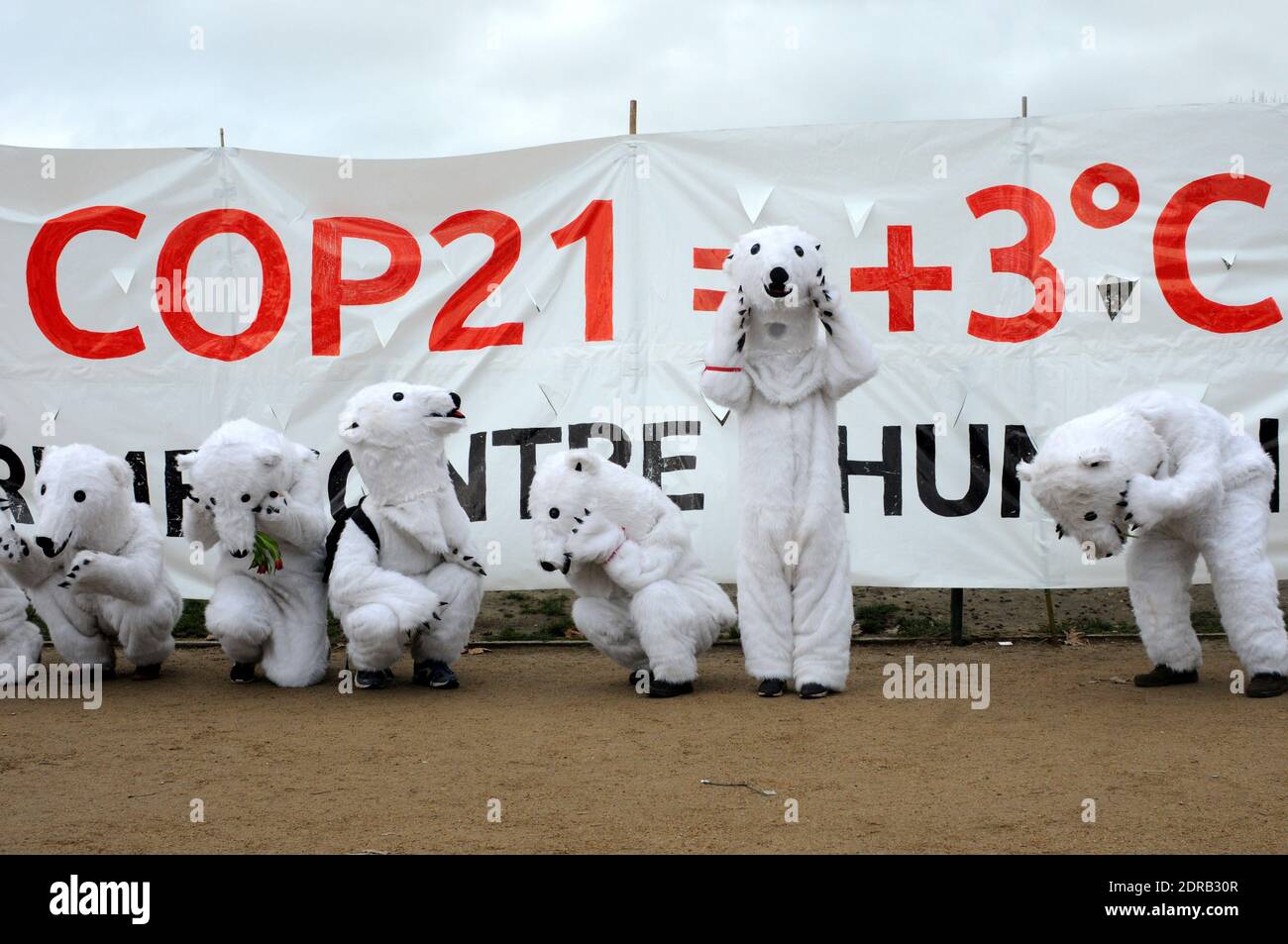 People wearing polar bear costumes are seen while activists stage a demonstration near the Eiffel Tower in Paris, France, on December 12, 2015. A proposed 195-nation accord to curb emissions of the heat-trapping gases that threaten to wreak havoc on Earth's climate system is to be presented at the United Nations conference on climate change COP21 in Le Bourget, on the outskirts of Paris. Photo by Alain Apaydin/ABACAPRESS.COM Stock Photohttps://www.alamy.com/image-license-details/?v=1https://www.alamy.com/people-wearing-polar-bear-costumes-are-seen-while-activists-stage-a-demonstration-near-the-eiffel-tower-in-paris-france-on-december-12-2015-a-proposed-195-nation-accord-to-curb-emissions-of-the-heat-trapping-gases-that-threaten-to-wreak-havoc-on-earths-climate-system-is-to-be-presented-at-the-united-nations-conference-on-climate-change-cop21-in-le-bourget-on-the-outskirts-of-paris-photo-by-alain-apaydinabacapresscom-image393009031.html
People wearing polar bear costumes are seen while activists stage a demonstration near the Eiffel Tower in Paris, France, on December 12, 2015. A proposed 195-nation accord to curb emissions of the heat-trapping gases that threaten to wreak havoc on Earth's climate system is to be presented at the United Nations conference on climate change COP21 in Le Bourget, on the outskirts of Paris. Photo by Alain Apaydin/ABACAPRESS.COM Stock Photohttps://www.alamy.com/image-license-details/?v=1https://www.alamy.com/people-wearing-polar-bear-costumes-are-seen-while-activists-stage-a-demonstration-near-the-eiffel-tower-in-paris-france-on-december-12-2015-a-proposed-195-nation-accord-to-curb-emissions-of-the-heat-trapping-gases-that-threaten-to-wreak-havoc-on-earths-climate-system-is-to-be-presented-at-the-united-nations-conference-on-climate-change-cop21-in-le-bourget-on-the-outskirts-of-paris-photo-by-alain-apaydinabacapresscom-image393009031.htmlRM2DRB30R–People wearing polar bear costumes are seen while activists stage a demonstration near the Eiffel Tower in Paris, France, on December 12, 2015. A proposed 195-nation accord to curb emissions of the heat-trapping gases that threaten to wreak havoc on Earth's climate system is to be presented at the United Nations conference on climate change COP21 in Le Bourget, on the outskirts of Paris. Photo by Alain Apaydin/ABACAPRESS.COM
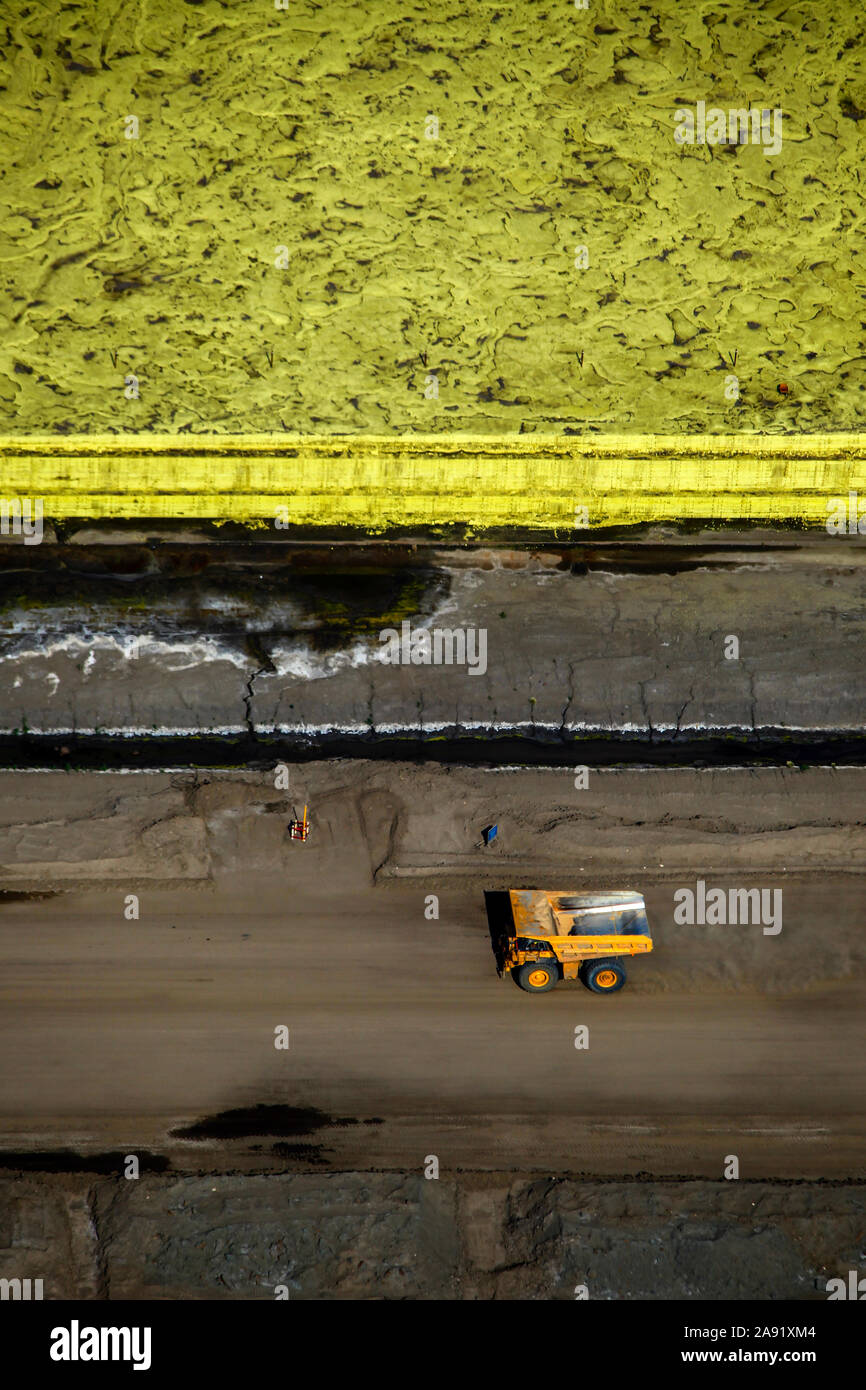 A dump truck races by a mountain of sulfur at one of the oil sand mines in Fort McMurray in Alberta, Canada. The sulfur is a byproduct from the refining of the bitumen and represents a huge problem of its own. As of 2006 there were 15 million tons of sulfur stockpiled at the mining sites, and the price tag for maintaining the toxic runoff is hefty. The Athabasca oil sands deposit is among the largest in the world. The bitumen, also commonly named tar (hence tar sands), contains lots of hydrocarbons, but is notoriously hard to extract. For every 100 BTU of energy extracted, 70 BTU is lost in Stock Photohttps://www.alamy.com/image-license-details/?v=1https://www.alamy.com/a-dump-truck-races-by-a-mountain-of-sulfur-at-one-of-the-oil-sand-mines-in-fort-mcmurray-in-alberta-canada-the-sulfur-is-a-byproduct-from-the-refining-of-the-bitumen-and-represents-a-huge-problem-of-its-own-as-of-2006-there-were-15-million-tons-of-sulfur-stockpiled-at-the-mining-sites-and-the-price-tag-for-maintaining-the-toxic-runoff-is-hefty-the-athabasca-oil-sands-deposit-is-among-the-largest-in-the-world-the-bitumen-also-commonly-named-tar-hence-tar-sands-contains-lots-of-hydrocarbons-but-is-notoriously-hard-to-extract-for-every-100-btu-of-energy-extracted-70-btu-is-lost-in-image332571796.html
A dump truck races by a mountain of sulfur at one of the oil sand mines in Fort McMurray in Alberta, Canada. The sulfur is a byproduct from the refining of the bitumen and represents a huge problem of its own. As of 2006 there were 15 million tons of sulfur stockpiled at the mining sites, and the price tag for maintaining the toxic runoff is hefty. The Athabasca oil sands deposit is among the largest in the world. The bitumen, also commonly named tar (hence tar sands), contains lots of hydrocarbons, but is notoriously hard to extract. For every 100 BTU of energy extracted, 70 BTU is lost in Stock Photohttps://www.alamy.com/image-license-details/?v=1https://www.alamy.com/a-dump-truck-races-by-a-mountain-of-sulfur-at-one-of-the-oil-sand-mines-in-fort-mcmurray-in-alberta-canada-the-sulfur-is-a-byproduct-from-the-refining-of-the-bitumen-and-represents-a-huge-problem-of-its-own-as-of-2006-there-were-15-million-tons-of-sulfur-stockpiled-at-the-mining-sites-and-the-price-tag-for-maintaining-the-toxic-runoff-is-hefty-the-athabasca-oil-sands-deposit-is-among-the-largest-in-the-world-the-bitumen-also-commonly-named-tar-hence-tar-sands-contains-lots-of-hydrocarbons-but-is-notoriously-hard-to-extract-for-every-100-btu-of-energy-extracted-70-btu-is-lost-in-image332571796.htmlRM2A91XM4–A dump truck races by a mountain of sulfur at one of the oil sand mines in Fort McMurray in Alberta, Canada. The sulfur is a byproduct from the refining of the bitumen and represents a huge problem of its own. As of 2006 there were 15 million tons of sulfur stockpiled at the mining sites, and the price tag for maintaining the toxic runoff is hefty. The Athabasca oil sands deposit is among the largest in the world. The bitumen, also commonly named tar (hence tar sands), contains lots of hydrocarbons, but is notoriously hard to extract. For every 100 BTU of energy extracted, 70 BTU is lost in
 Water pipes ready to be put in the ground outside Williston in North Dakota. The area is part of the Bakken oil field, where fracking technology has made it profitable as long as the oil price stays above USD 46 per barrel. The fracking procedure inject enormous amounts of water as part of the fracking process, and access to usable water has been a problem in the region. Stock Photohttps://www.alamy.com/image-license-details/?v=1https://www.alamy.com/water-pipes-ready-to-be-put-in-the-ground-outside-williston-in-north-dakota-the-area-is-part-of-the-bakken-oil-field-where-fracking-technology-has-made-it-profitable-as-long-as-the-oil-price-stays-above-usd-46-per-barrel-the-fracking-procedure-inject-enormous-amounts-of-water-as-part-of-the-fracking-process-and-access-to-usable-water-has-been-a-problem-in-the-region-image348476774.html
Water pipes ready to be put in the ground outside Williston in North Dakota. The area is part of the Bakken oil field, where fracking technology has made it profitable as long as the oil price stays above USD 46 per barrel. The fracking procedure inject enormous amounts of water as part of the fracking process, and access to usable water has been a problem in the region. Stock Photohttps://www.alamy.com/image-license-details/?v=1https://www.alamy.com/water-pipes-ready-to-be-put-in-the-ground-outside-williston-in-north-dakota-the-area-is-part-of-the-bakken-oil-field-where-fracking-technology-has-made-it-profitable-as-long-as-the-oil-price-stays-above-usd-46-per-barrel-the-fracking-procedure-inject-enormous-amounts-of-water-as-part-of-the-fracking-process-and-access-to-usable-water-has-been-a-problem-in-the-region-image348476774.htmlRM2B6XDK2–Water pipes ready to be put in the ground outside Williston in North Dakota. The area is part of the Bakken oil field, where fracking technology has made it profitable as long as the oil price stays above USD 46 per barrel. The fracking procedure inject enormous amounts of water as part of the fracking process, and access to usable water has been a problem in the region.
 People wearing polar bear costumes are seen while activists stage a demonstration near the Eiffel Tower in Paris, France, on December 12, 2015. A proposed 195-nation accord to curb emissions of the heat-trapping gases that threaten to wreak havoc on Earth's climate system is to be presented at the United Nations conference on climate change COP21 in Le Bourget, on the outskirts of Paris. Photo by Alain Apaydin/ABACAPRESS.COM Stock Photohttps://www.alamy.com/image-license-details/?v=1https://www.alamy.com/people-wearing-polar-bear-costumes-are-seen-while-activists-stage-a-demonstration-near-the-eiffel-tower-in-paris-france-on-december-12-2015-a-proposed-195-nation-accord-to-curb-emissions-of-the-heat-trapping-gases-that-threaten-to-wreak-havoc-on-earths-climate-system-is-to-be-presented-at-the-united-nations-conference-on-climate-change-cop21-in-le-bourget-on-the-outskirts-of-paris-photo-by-alain-apaydinabacapresscom-image393009016.html
People wearing polar bear costumes are seen while activists stage a demonstration near the Eiffel Tower in Paris, France, on December 12, 2015. A proposed 195-nation accord to curb emissions of the heat-trapping gases that threaten to wreak havoc on Earth's climate system is to be presented at the United Nations conference on climate change COP21 in Le Bourget, on the outskirts of Paris. Photo by Alain Apaydin/ABACAPRESS.COM Stock Photohttps://www.alamy.com/image-license-details/?v=1https://www.alamy.com/people-wearing-polar-bear-costumes-are-seen-while-activists-stage-a-demonstration-near-the-eiffel-tower-in-paris-france-on-december-12-2015-a-proposed-195-nation-accord-to-curb-emissions-of-the-heat-trapping-gases-that-threaten-to-wreak-havoc-on-earths-climate-system-is-to-be-presented-at-the-united-nations-conference-on-climate-change-cop21-in-le-bourget-on-the-outskirts-of-paris-photo-by-alain-apaydinabacapresscom-image393009016.htmlRM2DRB308–People wearing polar bear costumes are seen while activists stage a demonstration near the Eiffel Tower in Paris, France, on December 12, 2015. A proposed 195-nation accord to curb emissions of the heat-trapping gases that threaten to wreak havoc on Earth's climate system is to be presented at the United Nations conference on climate change COP21 in Le Bourget, on the outskirts of Paris. Photo by Alain Apaydin/ABACAPRESS.COM
 A freight train transporting oil from the Bakken field near Williston in North Dakota. The area is part of the Bakken oil field, where fracking technology has made it profitable as long as the oil price stays above USD 46 per barrel. Stock Photohttps://www.alamy.com/image-license-details/?v=1https://www.alamy.com/a-freight-train-transporting-oil-from-the-bakken-field-near-williston-in-north-dakota-the-area-is-part-of-the-bakken-oil-field-where-fracking-technology-has-made-it-profitable-as-long-as-the-oil-price-stays-above-usd-46-per-barrel-image433662907.html
A freight train transporting oil from the Bakken field near Williston in North Dakota. The area is part of the Bakken oil field, where fracking technology has made it profitable as long as the oil price stays above USD 46 per barrel. Stock Photohttps://www.alamy.com/image-license-details/?v=1https://www.alamy.com/a-freight-train-transporting-oil-from-the-bakken-field-near-williston-in-north-dakota-the-area-is-part-of-the-bakken-oil-field-where-fracking-technology-has-made-it-profitable-as-long-as-the-oil-price-stays-above-usd-46-per-barrel-image433662907.htmlRM2G5F1CY–A freight train transporting oil from the Bakken field near Williston in North Dakota. The area is part of the Bakken oil field, where fracking technology has made it profitable as long as the oil price stays above USD 46 per barrel.
 People wearing polar bear costumes are seen while activists stage a demonstration near the Eiffel Tower in Paris, France, on December 12, 2015. A proposed 195-nation accord to curb emissions of the heat-trapping gases that threaten to wreak havoc on Earth's climate system is to be presented at the United Nations conference on climate change COP21 in Le Bourget, on the outskirts of Paris. Photo by Alain Apaydin/ABACAPRESS.COM Stock Photohttps://www.alamy.com/image-license-details/?v=1https://www.alamy.com/people-wearing-polar-bear-costumes-are-seen-while-activists-stage-a-demonstration-near-the-eiffel-tower-in-paris-france-on-december-12-2015-a-proposed-195-nation-accord-to-curb-emissions-of-the-heat-trapping-gases-that-threaten-to-wreak-havoc-on-earths-climate-system-is-to-be-presented-at-the-united-nations-conference-on-climate-change-cop21-in-le-bourget-on-the-outskirts-of-paris-photo-by-alain-apaydinabacapresscom-image393009078.html
People wearing polar bear costumes are seen while activists stage a demonstration near the Eiffel Tower in Paris, France, on December 12, 2015. A proposed 195-nation accord to curb emissions of the heat-trapping gases that threaten to wreak havoc on Earth's climate system is to be presented at the United Nations conference on climate change COP21 in Le Bourget, on the outskirts of Paris. Photo by Alain Apaydin/ABACAPRESS.COM Stock Photohttps://www.alamy.com/image-license-details/?v=1https://www.alamy.com/people-wearing-polar-bear-costumes-are-seen-while-activists-stage-a-demonstration-near-the-eiffel-tower-in-paris-france-on-december-12-2015-a-proposed-195-nation-accord-to-curb-emissions-of-the-heat-trapping-gases-that-threaten-to-wreak-havoc-on-earths-climate-system-is-to-be-presented-at-the-united-nations-conference-on-climate-change-cop21-in-le-bourget-on-the-outskirts-of-paris-photo-by-alain-apaydinabacapresscom-image393009078.htmlRM2DRB32E–People wearing polar bear costumes are seen while activists stage a demonstration near the Eiffel Tower in Paris, France, on December 12, 2015. A proposed 195-nation accord to curb emissions of the heat-trapping gases that threaten to wreak havoc on Earth's climate system is to be presented at the United Nations conference on climate change COP21 in Le Bourget, on the outskirts of Paris. Photo by Alain Apaydin/ABACAPRESS.COM
 Two pumpjacks pumping oil from two oil wells outside Williston in North Dakota. The area is part of the Bakken oil field, where fracking technology has made it profitable as long as the oil price stays above USD 46 per barrel. Stock Photohttps://www.alamy.com/image-license-details/?v=1https://www.alamy.com/two-pumpjacks-pumping-oil-from-two-oil-wells-outside-williston-in-north-dakota-the-area-is-part-of-the-bakken-oil-field-where-fracking-technology-has-made-it-profitable-as-long-as-the-oil-price-stays-above-usd-46-per-barrel-image348476778.html
Two pumpjacks pumping oil from two oil wells outside Williston in North Dakota. The area is part of the Bakken oil field, where fracking technology has made it profitable as long as the oil price stays above USD 46 per barrel. Stock Photohttps://www.alamy.com/image-license-details/?v=1https://www.alamy.com/two-pumpjacks-pumping-oil-from-two-oil-wells-outside-williston-in-north-dakota-the-area-is-part-of-the-bakken-oil-field-where-fracking-technology-has-made-it-profitable-as-long-as-the-oil-price-stays-above-usd-46-per-barrel-image348476778.htmlRM2B6XDK6–Two pumpjacks pumping oil from two oil wells outside Williston in North Dakota. The area is part of the Bakken oil field, where fracking technology has made it profitable as long as the oil price stays above USD 46 per barrel.
 Activists stage a demonstration near the Arc de Triomphe at the Avenue de la Grande Armee boulevard in Paris, France, on December 12, 2015. A proposed 195-nation accord to curb emissions of the heat-trapping gases that threaten to wreak havoc on Earth's climate system is to be presented at the United Nations conference on climate change COP21 in Le Bourget, on the outskirts of Paris. Photo by Somer/ABACAPRESS.COM Stock Photohttps://www.alamy.com/image-license-details/?v=1https://www.alamy.com/activists-stage-a-demonstration-near-the-arc-de-triomphe-at-the-avenue-de-la-grande-armee-boulevard-in-paris-france-on-december-12-2015-a-proposed-195-nation-accord-to-curb-emissions-of-the-heat-trapping-gases-that-threaten-to-wreak-havoc-on-earths-climate-system-is-to-be-presented-at-the-united-nations-conference-on-climate-change-cop21-in-le-bourget-on-the-outskirts-of-paris-photo-by-somerabacapresscom-image393009007.html
Activists stage a demonstration near the Arc de Triomphe at the Avenue de la Grande Armee boulevard in Paris, France, on December 12, 2015. A proposed 195-nation accord to curb emissions of the heat-trapping gases that threaten to wreak havoc on Earth's climate system is to be presented at the United Nations conference on climate change COP21 in Le Bourget, on the outskirts of Paris. Photo by Somer/ABACAPRESS.COM Stock Photohttps://www.alamy.com/image-license-details/?v=1https://www.alamy.com/activists-stage-a-demonstration-near-the-arc-de-triomphe-at-the-avenue-de-la-grande-armee-boulevard-in-paris-france-on-december-12-2015-a-proposed-195-nation-accord-to-curb-emissions-of-the-heat-trapping-gases-that-threaten-to-wreak-havoc-on-earths-climate-system-is-to-be-presented-at-the-united-nations-conference-on-climate-change-cop21-in-le-bourget-on-the-outskirts-of-paris-photo-by-somerabacapresscom-image393009007.htmlRM2DRB2YY–Activists stage a demonstration near the Arc de Triomphe at the Avenue de la Grande Armee boulevard in Paris, France, on December 12, 2015. A proposed 195-nation accord to curb emissions of the heat-trapping gases that threaten to wreak havoc on Earth's climate system is to be presented at the United Nations conference on climate change COP21 in Le Bourget, on the outskirts of Paris. Photo by Somer/ABACAPRESS.COM
 An oil rig and storage tanks outside Williston in North Dakota. The area is part of the Bakken oil field, where fracking technology has made it profitable as long as the oil price stays above USD 46 per barrel. Stock Photohttps://www.alamy.com/image-license-details/?v=1https://www.alamy.com/an-oil-rig-and-storage-tanks-outside-williston-in-north-dakota-the-area-is-part-of-the-bakken-oil-field-where-fracking-technology-has-made-it-profitable-as-long-as-the-oil-price-stays-above-usd-46-per-barrel-image348476804.html
An oil rig and storage tanks outside Williston in North Dakota. The area is part of the Bakken oil field, where fracking technology has made it profitable as long as the oil price stays above USD 46 per barrel. Stock Photohttps://www.alamy.com/image-license-details/?v=1https://www.alamy.com/an-oil-rig-and-storage-tanks-outside-williston-in-north-dakota-the-area-is-part-of-the-bakken-oil-field-where-fracking-technology-has-made-it-profitable-as-long-as-the-oil-price-stays-above-usd-46-per-barrel-image348476804.htmlRM2B6XDM4–An oil rig and storage tanks outside Williston in North Dakota. The area is part of the Bakken oil field, where fracking technology has made it profitable as long as the oil price stays above USD 46 per barrel.
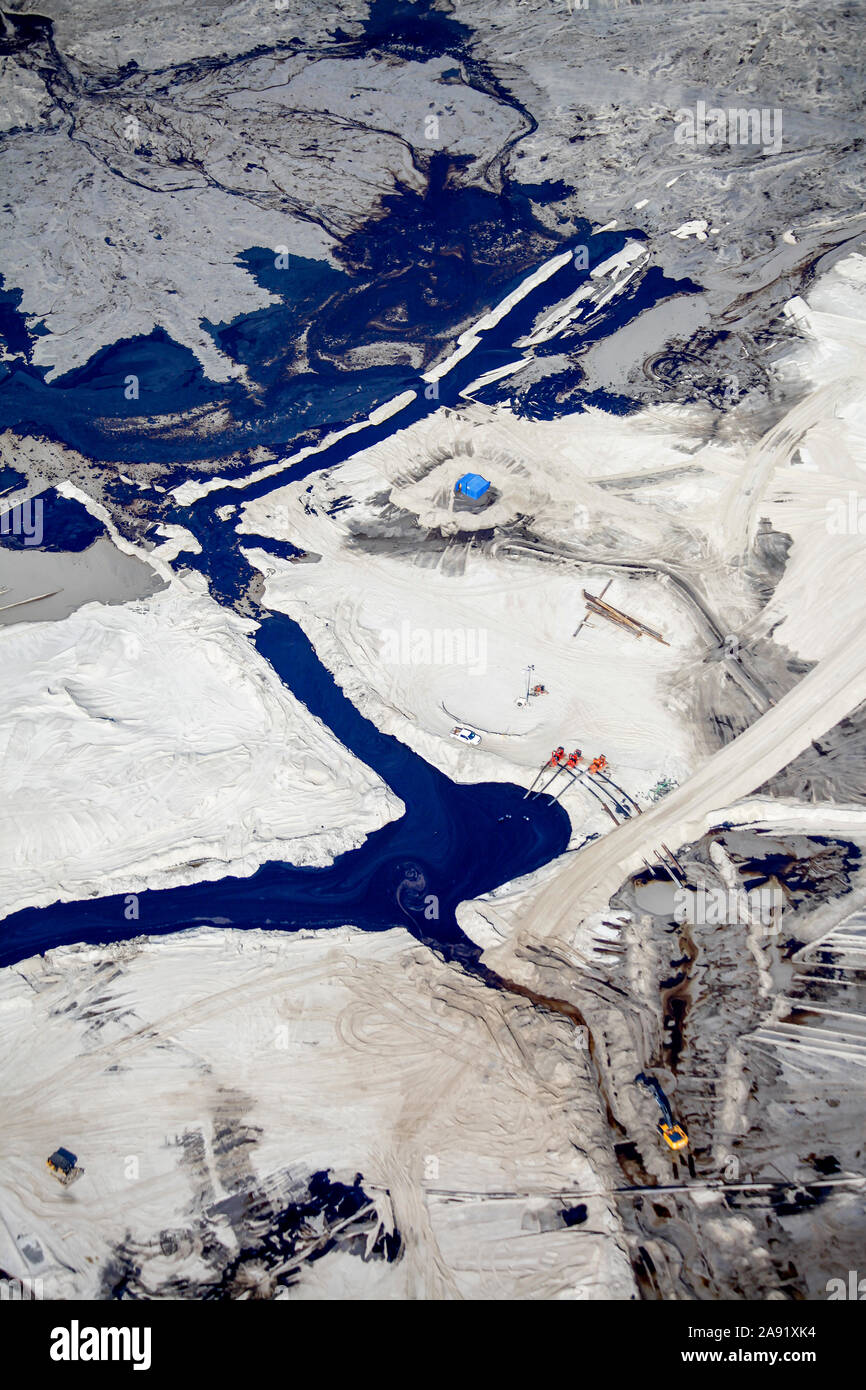 Detail from one of the enormous tailings ponds in Fort McMurray in Alberta, Canada. The ponds are among the largest man made structures in the world, spanning more than 175 square kilometres. They pose an added challenge to the oil sands production: even after ended production, it can take up to 30 years for the silt in the ponds to dry up. The contaminated water is toxic to any living creatures. The Athabasca oil sands deposit is among the largest in the world. The bitumen, also commonly named tar (hence tar sands), contains lots of hydrocarbons, but is notoriously hard to extract. For every Stock Photohttps://www.alamy.com/image-license-details/?v=1https://www.alamy.com/detail-from-one-of-the-enormous-tailings-ponds-in-fort-mcmurray-in-alberta-canada-the-ponds-are-among-the-largest-man-made-structures-in-the-world-spanning-more-than-175-square-kilometres-they-pose-an-added-challenge-to-the-oil-sands-production-even-after-ended-production-it-can-take-up-to-30-years-for-the-silt-in-the-ponds-to-dry-up-the-contaminated-water-is-toxic-to-any-living-creatures-the-athabasca-oil-sands-deposit-is-among-the-largest-in-the-world-the-bitumen-also-commonly-named-tar-hence-tar-sands-contains-lots-of-hydrocarbons-but-is-notoriously-hard-to-extract-for-every-image332571768.html
Detail from one of the enormous tailings ponds in Fort McMurray in Alberta, Canada. The ponds are among the largest man made structures in the world, spanning more than 175 square kilometres. They pose an added challenge to the oil sands production: even after ended production, it can take up to 30 years for the silt in the ponds to dry up. The contaminated water is toxic to any living creatures. The Athabasca oil sands deposit is among the largest in the world. The bitumen, also commonly named tar (hence tar sands), contains lots of hydrocarbons, but is notoriously hard to extract. For every Stock Photohttps://www.alamy.com/image-license-details/?v=1https://www.alamy.com/detail-from-one-of-the-enormous-tailings-ponds-in-fort-mcmurray-in-alberta-canada-the-ponds-are-among-the-largest-man-made-structures-in-the-world-spanning-more-than-175-square-kilometres-they-pose-an-added-challenge-to-the-oil-sands-production-even-after-ended-production-it-can-take-up-to-30-years-for-the-silt-in-the-ponds-to-dry-up-the-contaminated-water-is-toxic-to-any-living-creatures-the-athabasca-oil-sands-deposit-is-among-the-largest-in-the-world-the-bitumen-also-commonly-named-tar-hence-tar-sands-contains-lots-of-hydrocarbons-but-is-notoriously-hard-to-extract-for-every-image332571768.htmlRM2A91XK4–Detail from one of the enormous tailings ponds in Fort McMurray in Alberta, Canada. The ponds are among the largest man made structures in the world, spanning more than 175 square kilometres. They pose an added challenge to the oil sands production: even after ended production, it can take up to 30 years for the silt in the ponds to dry up. The contaminated water is toxic to any living creatures. The Athabasca oil sands deposit is among the largest in the world. The bitumen, also commonly named tar (hence tar sands), contains lots of hydrocarbons, but is notoriously hard to extract. For every
 Activists stage a demonstration near the Arc de Triomphe at the Avenue de la Grande Armee boulevard in Paris, France, on December 12, 2015. A proposed 195-nation accord to curb emissions of the heat-trapping gases that threaten to wreak havoc on Earth's climate system is to be presented at the United Nations conference on climate change COP21 in Le Bourget, on the outskirts of Paris. Photo by Somer/ABACAPRESS.COM Stock Photohttps://www.alamy.com/image-license-details/?v=1https://www.alamy.com/activists-stage-a-demonstration-near-the-arc-de-triomphe-at-the-avenue-de-la-grande-armee-boulevard-in-paris-france-on-december-12-2015-a-proposed-195-nation-accord-to-curb-emissions-of-the-heat-trapping-gases-that-threaten-to-wreak-havoc-on-earths-climate-system-is-to-be-presented-at-the-united-nations-conference-on-climate-change-cop21-in-le-bourget-on-the-outskirts-of-paris-photo-by-somerabacapresscom-image393008950.html
Activists stage a demonstration near the Arc de Triomphe at the Avenue de la Grande Armee boulevard in Paris, France, on December 12, 2015. A proposed 195-nation accord to curb emissions of the heat-trapping gases that threaten to wreak havoc on Earth's climate system is to be presented at the United Nations conference on climate change COP21 in Le Bourget, on the outskirts of Paris. Photo by Somer/ABACAPRESS.COM Stock Photohttps://www.alamy.com/image-license-details/?v=1https://www.alamy.com/activists-stage-a-demonstration-near-the-arc-de-triomphe-at-the-avenue-de-la-grande-armee-boulevard-in-paris-france-on-december-12-2015-a-proposed-195-nation-accord-to-curb-emissions-of-the-heat-trapping-gases-that-threaten-to-wreak-havoc-on-earths-climate-system-is-to-be-presented-at-the-united-nations-conference-on-climate-change-cop21-in-le-bourget-on-the-outskirts-of-paris-photo-by-somerabacapresscom-image393008950.htmlRM2DRB2WX–Activists stage a demonstration near the Arc de Triomphe at the Avenue de la Grande Armee boulevard in Paris, France, on December 12, 2015. A proposed 195-nation accord to curb emissions of the heat-trapping gases that threaten to wreak havoc on Earth's climate system is to be presented at the United Nations conference on climate change COP21 in Le Bourget, on the outskirts of Paris. Photo by Somer/ABACAPRESS.COM
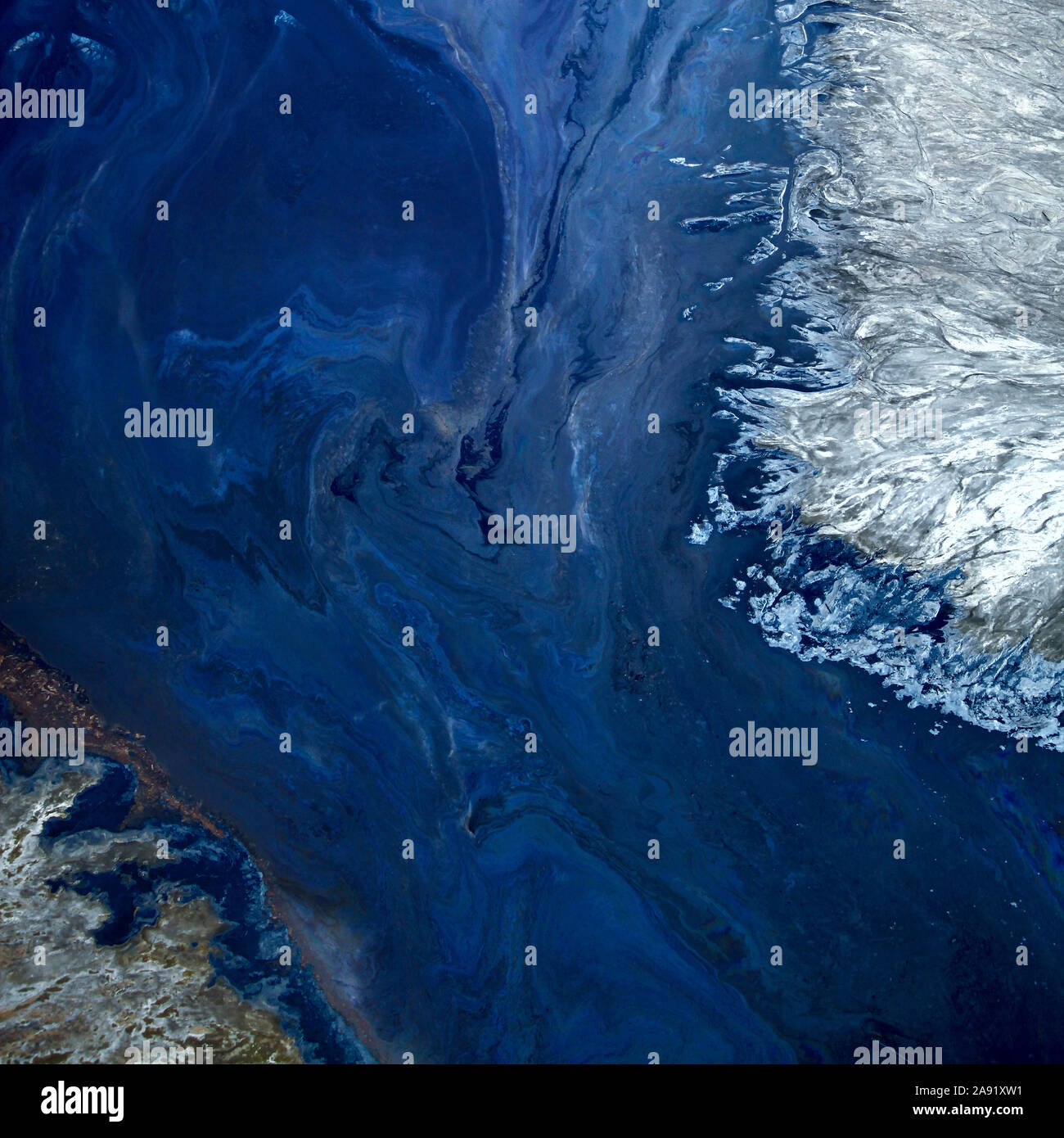 Detail from one of the enormous tailings ponds in Fort McMurray in Alberta, Canada. The ponds are among the largest man made structures in the world, spanning more than 175 square kilometres. They pose an added challenge to the oil sands production: even after ended production, it can take up to 30 years for the silt in the ponds to dry up. The contaminated water is toxic to any living creatures. The Athabasca oil sands deposit is among the largest in the world. The bitumen, also commonly named tar (hence tar sands), contains lots of hydrocarbons, but is notoriously hard to extract. For every Stock Photohttps://www.alamy.com/image-license-details/?v=1https://www.alamy.com/detail-from-one-of-the-enormous-tailings-ponds-in-fort-mcmurray-in-alberta-canada-the-ponds-are-among-the-largest-man-made-structures-in-the-world-spanning-more-than-175-square-kilometres-they-pose-an-added-challenge-to-the-oil-sands-production-even-after-ended-production-it-can-take-up-to-30-years-for-the-silt-in-the-ponds-to-dry-up-the-contaminated-water-is-toxic-to-any-living-creatures-the-athabasca-oil-sands-deposit-is-among-the-largest-in-the-world-the-bitumen-also-commonly-named-tar-hence-tar-sands-contains-lots-of-hydrocarbons-but-is-notoriously-hard-to-extract-for-every-image332571933.html
Detail from one of the enormous tailings ponds in Fort McMurray in Alberta, Canada. The ponds are among the largest man made structures in the world, spanning more than 175 square kilometres. They pose an added challenge to the oil sands production: even after ended production, it can take up to 30 years for the silt in the ponds to dry up. The contaminated water is toxic to any living creatures. The Athabasca oil sands deposit is among the largest in the world. The bitumen, also commonly named tar (hence tar sands), contains lots of hydrocarbons, but is notoriously hard to extract. For every Stock Photohttps://www.alamy.com/image-license-details/?v=1https://www.alamy.com/detail-from-one-of-the-enormous-tailings-ponds-in-fort-mcmurray-in-alberta-canada-the-ponds-are-among-the-largest-man-made-structures-in-the-world-spanning-more-than-175-square-kilometres-they-pose-an-added-challenge-to-the-oil-sands-production-even-after-ended-production-it-can-take-up-to-30-years-for-the-silt-in-the-ponds-to-dry-up-the-contaminated-water-is-toxic-to-any-living-creatures-the-athabasca-oil-sands-deposit-is-among-the-largest-in-the-world-the-bitumen-also-commonly-named-tar-hence-tar-sands-contains-lots-of-hydrocarbons-but-is-notoriously-hard-to-extract-for-every-image332571933.htmlRM2A91XW1–Detail from one of the enormous tailings ponds in Fort McMurray in Alberta, Canada. The ponds are among the largest man made structures in the world, spanning more than 175 square kilometres. They pose an added challenge to the oil sands production: even after ended production, it can take up to 30 years for the silt in the ponds to dry up. The contaminated water is toxic to any living creatures. The Athabasca oil sands deposit is among the largest in the world. The bitumen, also commonly named tar (hence tar sands), contains lots of hydrocarbons, but is notoriously hard to extract. For every
 People wearing polar bear costumes are seen while activists stage a demonstration near the Eiffel Tower in Paris, France, on December 12, 2015. A proposed 195-nation accord to curb emissions of the heat-trapping gases that threaten to wreak havoc on Earth's climate system is to be presented at the United Nations conference on climate change COP21 in Le Bourget, on the outskirts of Paris. Photo by Alain Apaydin/ABACAPRESS.COM Stock Photohttps://www.alamy.com/image-license-details/?v=1https://www.alamy.com/people-wearing-polar-bear-costumes-are-seen-while-activists-stage-a-demonstration-near-the-eiffel-tower-in-paris-france-on-december-12-2015-a-proposed-195-nation-accord-to-curb-emissions-of-the-heat-trapping-gases-that-threaten-to-wreak-havoc-on-earths-climate-system-is-to-be-presented-at-the-united-nations-conference-on-climate-change-cop21-in-le-bourget-on-the-outskirts-of-paris-photo-by-alain-apaydinabacapresscom-image393009012.html
People wearing polar bear costumes are seen while activists stage a demonstration near the Eiffel Tower in Paris, France, on December 12, 2015. A proposed 195-nation accord to curb emissions of the heat-trapping gases that threaten to wreak havoc on Earth's climate system is to be presented at the United Nations conference on climate change COP21 in Le Bourget, on the outskirts of Paris. Photo by Alain Apaydin/ABACAPRESS.COM Stock Photohttps://www.alamy.com/image-license-details/?v=1https://www.alamy.com/people-wearing-polar-bear-costumes-are-seen-while-activists-stage-a-demonstration-near-the-eiffel-tower-in-paris-france-on-december-12-2015-a-proposed-195-nation-accord-to-curb-emissions-of-the-heat-trapping-gases-that-threaten-to-wreak-havoc-on-earths-climate-system-is-to-be-presented-at-the-united-nations-conference-on-climate-change-cop21-in-le-bourget-on-the-outskirts-of-paris-photo-by-alain-apaydinabacapresscom-image393009012.htmlRM2DRB304–People wearing polar bear costumes are seen while activists stage a demonstration near the Eiffel Tower in Paris, France, on December 12, 2015. A proposed 195-nation accord to curb emissions of the heat-trapping gases that threaten to wreak havoc on Earth's climate system is to be presented at the United Nations conference on climate change COP21 in Le Bourget, on the outskirts of Paris. Photo by Alain Apaydin/ABACAPRESS.COM
 Pick up trucks pass trough one of the enormous tailings ponds in Fort McMurray in Alberta, Canada. The ponds are among the largest man made structures in the world, spanning more than 175 square kilometres. They pose an added challenge to the oil sands production: even after ended production, it can take up to 30 years for the silt in the ponds to dry up. The contaminated water is toxic to any living creatures. The Athabasca oil sands deposit is among the largest in the world. The bitumen, also commonly named tar (hence tar sands), contains lots of hydrocarbons, but is notoriously hard to ext Stock Photohttps://www.alamy.com/image-license-details/?v=1https://www.alamy.com/pick-up-trucks-pass-trough-one-of-the-enormous-tailings-ponds-in-fort-mcmurray-in-alberta-canada-the-ponds-are-among-the-largest-man-made-structures-in-the-world-spanning-more-than-175-square-kilometres-they-pose-an-added-challenge-to-the-oil-sands-production-even-after-ended-production-it-can-take-up-to-30-years-for-the-silt-in-the-ponds-to-dry-up-the-contaminated-water-is-toxic-to-any-living-creatures-the-athabasca-oil-sands-deposit-is-among-the-largest-in-the-world-the-bitumen-also-commonly-named-tar-hence-tar-sands-contains-lots-of-hydrocarbons-but-is-notoriously-hard-to-ext-image332571694.html
Pick up trucks pass trough one of the enormous tailings ponds in Fort McMurray in Alberta, Canada. The ponds are among the largest man made structures in the world, spanning more than 175 square kilometres. They pose an added challenge to the oil sands production: even after ended production, it can take up to 30 years for the silt in the ponds to dry up. The contaminated water is toxic to any living creatures. The Athabasca oil sands deposit is among the largest in the world. The bitumen, also commonly named tar (hence tar sands), contains lots of hydrocarbons, but is notoriously hard to ext Stock Photohttps://www.alamy.com/image-license-details/?v=1https://www.alamy.com/pick-up-trucks-pass-trough-one-of-the-enormous-tailings-ponds-in-fort-mcmurray-in-alberta-canada-the-ponds-are-among-the-largest-man-made-structures-in-the-world-spanning-more-than-175-square-kilometres-they-pose-an-added-challenge-to-the-oil-sands-production-even-after-ended-production-it-can-take-up-to-30-years-for-the-silt-in-the-ponds-to-dry-up-the-contaminated-water-is-toxic-to-any-living-creatures-the-athabasca-oil-sands-deposit-is-among-the-largest-in-the-world-the-bitumen-also-commonly-named-tar-hence-tar-sands-contains-lots-of-hydrocarbons-but-is-notoriously-hard-to-ext-image332571694.htmlRM2A91XGE–Pick up trucks pass trough one of the enormous tailings ponds in Fort McMurray in Alberta, Canada. The ponds are among the largest man made structures in the world, spanning more than 175 square kilometres. They pose an added challenge to the oil sands production: even after ended production, it can take up to 30 years for the silt in the ponds to dry up. The contaminated water is toxic to any living creatures. The Athabasca oil sands deposit is among the largest in the world. The bitumen, also commonly named tar (hence tar sands), contains lots of hydrocarbons, but is notoriously hard to ext
 Activists stage a demonstration near the Arc de Triomphe at the Avenue de la Grande Armee boulevard in Paris, France, on December 12, 2015. A proposed 195-nation accord to curb emissions of the heat-trapping gases that threaten to wreak havoc on Earth's climate system is to be presented at the United Nations conference on climate change COP21 in Le Bourget, on the outskirts of Paris. Photo by Somer/ABACAPRESS.COM Stock Photohttps://www.alamy.com/image-license-details/?v=1https://www.alamy.com/activists-stage-a-demonstration-near-the-arc-de-triomphe-at-the-avenue-de-la-grande-armee-boulevard-in-paris-france-on-december-12-2015-a-proposed-195-nation-accord-to-curb-emissions-of-the-heat-trapping-gases-that-threaten-to-wreak-havoc-on-earths-climate-system-is-to-be-presented-at-the-united-nations-conference-on-climate-change-cop21-in-le-bourget-on-the-outskirts-of-paris-photo-by-somerabacapresscom-image393008939.html
Activists stage a demonstration near the Arc de Triomphe at the Avenue de la Grande Armee boulevard in Paris, France, on December 12, 2015. A proposed 195-nation accord to curb emissions of the heat-trapping gases that threaten to wreak havoc on Earth's climate system is to be presented at the United Nations conference on climate change COP21 in Le Bourget, on the outskirts of Paris. Photo by Somer/ABACAPRESS.COM Stock Photohttps://www.alamy.com/image-license-details/?v=1https://www.alamy.com/activists-stage-a-demonstration-near-the-arc-de-triomphe-at-the-avenue-de-la-grande-armee-boulevard-in-paris-france-on-december-12-2015-a-proposed-195-nation-accord-to-curb-emissions-of-the-heat-trapping-gases-that-threaten-to-wreak-havoc-on-earths-climate-system-is-to-be-presented-at-the-united-nations-conference-on-climate-change-cop21-in-le-bourget-on-the-outskirts-of-paris-photo-by-somerabacapresscom-image393008939.htmlRM2DRB2WF–Activists stage a demonstration near the Arc de Triomphe at the Avenue de la Grande Armee boulevard in Paris, France, on December 12, 2015. A proposed 195-nation accord to curb emissions of the heat-trapping gases that threaten to wreak havoc on Earth's climate system is to be presented at the United Nations conference on climate change COP21 in Le Bourget, on the outskirts of Paris. Photo by Somer/ABACAPRESS.COM
 Bulldozers are spreading the toxic waste in one of the enormous tailings ponds in Fort McMurray in Alberta, Canada. The ponds are among the largest man made structures in the world, spanning more than 175 square kilometres. They pose an added challenge to the oil sands production: even after ended production, it can take up to 30 years for the silt in the ponds to dry up. The contaminated water is toxic to any living creatures. The Athabasca oil sands deposit is among the largest in the world. The bitumen, also commonly named tar (hence tar sands), contains lots of hydrocarbons, but is notori Stock Photohttps://www.alamy.com/image-license-details/?v=1https://www.alamy.com/bulldozers-are-spreading-the-toxic-waste-in-one-of-the-enormous-tailings-ponds-in-fort-mcmurray-in-alberta-canada-the-ponds-are-among-the-largest-man-made-structures-in-the-world-spanning-more-than-175-square-kilometres-they-pose-an-added-challenge-to-the-oil-sands-production-even-after-ended-production-it-can-take-up-to-30-years-for-the-silt-in-the-ponds-to-dry-up-the-contaminated-water-is-toxic-to-any-living-creatures-the-athabasca-oil-sands-deposit-is-among-the-largest-in-the-world-the-bitumen-also-commonly-named-tar-hence-tar-sands-contains-lots-of-hydrocarbons-but-is-notori-image332571913.html
Bulldozers are spreading the toxic waste in one of the enormous tailings ponds in Fort McMurray in Alberta, Canada. The ponds are among the largest man made structures in the world, spanning more than 175 square kilometres. They pose an added challenge to the oil sands production: even after ended production, it can take up to 30 years for the silt in the ponds to dry up. The contaminated water is toxic to any living creatures. The Athabasca oil sands deposit is among the largest in the world. The bitumen, also commonly named tar (hence tar sands), contains lots of hydrocarbons, but is notori Stock Photohttps://www.alamy.com/image-license-details/?v=1https://www.alamy.com/bulldozers-are-spreading-the-toxic-waste-in-one-of-the-enormous-tailings-ponds-in-fort-mcmurray-in-alberta-canada-the-ponds-are-among-the-largest-man-made-structures-in-the-world-spanning-more-than-175-square-kilometres-they-pose-an-added-challenge-to-the-oil-sands-production-even-after-ended-production-it-can-take-up-to-30-years-for-the-silt-in-the-ponds-to-dry-up-the-contaminated-water-is-toxic-to-any-living-creatures-the-athabasca-oil-sands-deposit-is-among-the-largest-in-the-world-the-bitumen-also-commonly-named-tar-hence-tar-sands-contains-lots-of-hydrocarbons-but-is-notori-image332571913.htmlRM2A91XT9–Bulldozers are spreading the toxic waste in one of the enormous tailings ponds in Fort McMurray in Alberta, Canada. The ponds are among the largest man made structures in the world, spanning more than 175 square kilometres. They pose an added challenge to the oil sands production: even after ended production, it can take up to 30 years for the silt in the ponds to dry up. The contaminated water is toxic to any living creatures. The Athabasca oil sands deposit is among the largest in the world. The bitumen, also commonly named tar (hence tar sands), contains lots of hydrocarbons, but is notori
 Activists stage a demonstration near the Arc de Triomphe at the Avenue de la Grande Armee boulevard in Paris, France, on December 12, 2015. A proposed 195-nation accord to curb emissions of the heat-trapping gases that threaten to wreak havoc on Earth's climate system is to be presented at the United Nations conference on climate change COP21 in Le Bourget, on the outskirts of Paris. Photo by Somer/ABACAPRESS.COM Stock Photohttps://www.alamy.com/image-license-details/?v=1https://www.alamy.com/activists-stage-a-demonstration-near-the-arc-de-triomphe-at-the-avenue-de-la-grande-armee-boulevard-in-paris-france-on-december-12-2015-a-proposed-195-nation-accord-to-curb-emissions-of-the-heat-trapping-gases-that-threaten-to-wreak-havoc-on-earths-climate-system-is-to-be-presented-at-the-united-nations-conference-on-climate-change-cop21-in-le-bourget-on-the-outskirts-of-paris-photo-by-somerabacapresscom-image393009052.html
Activists stage a demonstration near the Arc de Triomphe at the Avenue de la Grande Armee boulevard in Paris, France, on December 12, 2015. A proposed 195-nation accord to curb emissions of the heat-trapping gases that threaten to wreak havoc on Earth's climate system is to be presented at the United Nations conference on climate change COP21 in Le Bourget, on the outskirts of Paris. Photo by Somer/ABACAPRESS.COM Stock Photohttps://www.alamy.com/image-license-details/?v=1https://www.alamy.com/activists-stage-a-demonstration-near-the-arc-de-triomphe-at-the-avenue-de-la-grande-armee-boulevard-in-paris-france-on-december-12-2015-a-proposed-195-nation-accord-to-curb-emissions-of-the-heat-trapping-gases-that-threaten-to-wreak-havoc-on-earths-climate-system-is-to-be-presented-at-the-united-nations-conference-on-climate-change-cop21-in-le-bourget-on-the-outskirts-of-paris-photo-by-somerabacapresscom-image393009052.htmlRM2DRB31G–Activists stage a demonstration near the Arc de Triomphe at the Avenue de la Grande Armee boulevard in Paris, France, on December 12, 2015. A proposed 195-nation accord to curb emissions of the heat-trapping gases that threaten to wreak havoc on Earth's climate system is to be presented at the United Nations conference on climate change COP21 in Le Bourget, on the outskirts of Paris. Photo by Somer/ABACAPRESS.COM
 Detail from one of the enormous tailings ponds in Fort McMurray in Alberta, Canada. The ponds are among the largest man made structures in the world, spanning more than 175 square kilometres. They pose an added challenge to the oil sands production: even after ended production, it can take up to 30 years for the silt in the ponds to dry up. The contaminated water is toxic to any living creatures. The Athabasca oil sands deposit is among the largest in the world. The bitumen, also commonly named tar (hence tar sands), contains lots of hydrocarbons, but is notoriously hard to extract. For every Stock Photohttps://www.alamy.com/image-license-details/?v=1https://www.alamy.com/detail-from-one-of-the-enormous-tailings-ponds-in-fort-mcmurray-in-alberta-canada-the-ponds-are-among-the-largest-man-made-structures-in-the-world-spanning-more-than-175-square-kilometres-they-pose-an-added-challenge-to-the-oil-sands-production-even-after-ended-production-it-can-take-up-to-30-years-for-the-silt-in-the-ponds-to-dry-up-the-contaminated-water-is-toxic-to-any-living-creatures-the-athabasca-oil-sands-deposit-is-among-the-largest-in-the-world-the-bitumen-also-commonly-named-tar-hence-tar-sands-contains-lots-of-hydrocarbons-but-is-notoriously-hard-to-extract-for-every-image332571788.html
Detail from one of the enormous tailings ponds in Fort McMurray in Alberta, Canada. The ponds are among the largest man made structures in the world, spanning more than 175 square kilometres. They pose an added challenge to the oil sands production: even after ended production, it can take up to 30 years for the silt in the ponds to dry up. The contaminated water is toxic to any living creatures. The Athabasca oil sands deposit is among the largest in the world. The bitumen, also commonly named tar (hence tar sands), contains lots of hydrocarbons, but is notoriously hard to extract. For every Stock Photohttps://www.alamy.com/image-license-details/?v=1https://www.alamy.com/detail-from-one-of-the-enormous-tailings-ponds-in-fort-mcmurray-in-alberta-canada-the-ponds-are-among-the-largest-man-made-structures-in-the-world-spanning-more-than-175-square-kilometres-they-pose-an-added-challenge-to-the-oil-sands-production-even-after-ended-production-it-can-take-up-to-30-years-for-the-silt-in-the-ponds-to-dry-up-the-contaminated-water-is-toxic-to-any-living-creatures-the-athabasca-oil-sands-deposit-is-among-the-largest-in-the-world-the-bitumen-also-commonly-named-tar-hence-tar-sands-contains-lots-of-hydrocarbons-but-is-notoriously-hard-to-extract-for-every-image332571788.htmlRM2A91XKT–Detail from one of the enormous tailings ponds in Fort McMurray in Alberta, Canada. The ponds are among the largest man made structures in the world, spanning more than 175 square kilometres. They pose an added challenge to the oil sands production: even after ended production, it can take up to 30 years for the silt in the ponds to dry up. The contaminated water is toxic to any living creatures. The Athabasca oil sands deposit is among the largest in the world. The bitumen, also commonly named tar (hence tar sands), contains lots of hydrocarbons, but is notoriously hard to extract. For every
 Activists stage a demonstration near the Arc de Triomphe at the Avenue de la Grande Armee boulevard in Paris, France, on December 12, 2015. A proposed 195-nation accord to curb emissions of the heat-trapping gases that threaten to wreak havoc on Earth's climate system is to be presented at the United Nations conference on climate change COP21 in Le Bourget, on the outskirts of Paris. Photo by Somer/ABACAPRESS.COM Stock Photohttps://www.alamy.com/image-license-details/?v=1https://www.alamy.com/activists-stage-a-demonstration-near-the-arc-de-triomphe-at-the-avenue-de-la-grande-armee-boulevard-in-paris-france-on-december-12-2015-a-proposed-195-nation-accord-to-curb-emissions-of-the-heat-trapping-gases-that-threaten-to-wreak-havoc-on-earths-climate-system-is-to-be-presented-at-the-united-nations-conference-on-climate-change-cop21-in-le-bourget-on-the-outskirts-of-paris-photo-by-somerabacapresscom-image393008949.html
Activists stage a demonstration near the Arc de Triomphe at the Avenue de la Grande Armee boulevard in Paris, France, on December 12, 2015. A proposed 195-nation accord to curb emissions of the heat-trapping gases that threaten to wreak havoc on Earth's climate system is to be presented at the United Nations conference on climate change COP21 in Le Bourget, on the outskirts of Paris. Photo by Somer/ABACAPRESS.COM Stock Photohttps://www.alamy.com/image-license-details/?v=1https://www.alamy.com/activists-stage-a-demonstration-near-the-arc-de-triomphe-at-the-avenue-de-la-grande-armee-boulevard-in-paris-france-on-december-12-2015-a-proposed-195-nation-accord-to-curb-emissions-of-the-heat-trapping-gases-that-threaten-to-wreak-havoc-on-earths-climate-system-is-to-be-presented-at-the-united-nations-conference-on-climate-change-cop21-in-le-bourget-on-the-outskirts-of-paris-photo-by-somerabacapresscom-image393008949.htmlRM2DRB2WW–Activists stage a demonstration near the Arc de Triomphe at the Avenue de la Grande Armee boulevard in Paris, France, on December 12, 2015. A proposed 195-nation accord to curb emissions of the heat-trapping gases that threaten to wreak havoc on Earth's climate system is to be presented at the United Nations conference on climate change COP21 in Le Bourget, on the outskirts of Paris. Photo by Somer/ABACAPRESS.COM
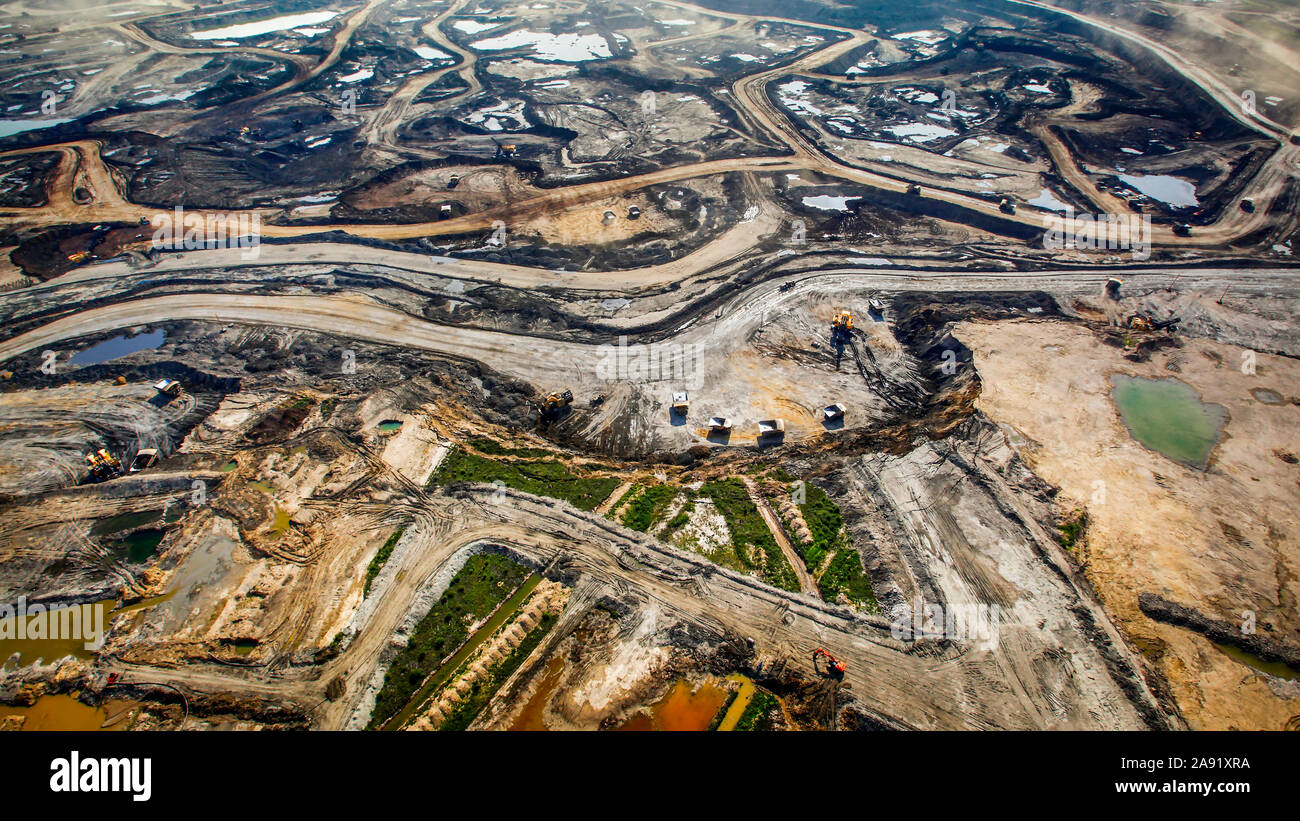 Excavation of oil sand at one of the oil sand mines in Fort McMurray in Alberta, Canada. The Athabasca oil sands deposit is among the largest in the world. The bitumen, also commonly named tar (hence tar sands), contains lots of hydrocarbons, but is notoriously hard to extract. For every 100 BTU of energy extracted, 70 BTU is lost in the process. In 2011 alone, the oil sands operations in Canada produced 55 million tons of ‘greenhouse gas emissions’. That’s eight percent of Canada’s total emissions. Stock Photohttps://www.alamy.com/image-license-details/?v=1https://www.alamy.com/excavation-of-oil-sand-at-one-of-the-oil-sand-mines-in-fort-mcmurray-in-alberta-canada-the-athabasca-oil-sands-deposit-is-among-the-largest-in-the-world-the-bitumen-also-commonly-named-tar-hence-tar-sands-contains-lots-of-hydrocarbons-but-is-notoriously-hard-to-extract-for-every-100-btu-of-energy-extracted-70-btu-is-lost-in-the-process-in-2011-alone-the-oil-sands-operations-in-canada-produced-55-million-tons-of-greenhouse-gas-emissions-thats-eight-percent-of-canadas-total-emissions-image332571886.html
Excavation of oil sand at one of the oil sand mines in Fort McMurray in Alberta, Canada. The Athabasca oil sands deposit is among the largest in the world. The bitumen, also commonly named tar (hence tar sands), contains lots of hydrocarbons, but is notoriously hard to extract. For every 100 BTU of energy extracted, 70 BTU is lost in the process. In 2011 alone, the oil sands operations in Canada produced 55 million tons of ‘greenhouse gas emissions’. That’s eight percent of Canada’s total emissions. Stock Photohttps://www.alamy.com/image-license-details/?v=1https://www.alamy.com/excavation-of-oil-sand-at-one-of-the-oil-sand-mines-in-fort-mcmurray-in-alberta-canada-the-athabasca-oil-sands-deposit-is-among-the-largest-in-the-world-the-bitumen-also-commonly-named-tar-hence-tar-sands-contains-lots-of-hydrocarbons-but-is-notoriously-hard-to-extract-for-every-100-btu-of-energy-extracted-70-btu-is-lost-in-the-process-in-2011-alone-the-oil-sands-operations-in-canada-produced-55-million-tons-of-greenhouse-gas-emissions-thats-eight-percent-of-canadas-total-emissions-image332571886.htmlRM2A91XRA–Excavation of oil sand at one of the oil sand mines in Fort McMurray in Alberta, Canada. The Athabasca oil sands deposit is among the largest in the world. The bitumen, also commonly named tar (hence tar sands), contains lots of hydrocarbons, but is notoriously hard to extract. For every 100 BTU of energy extracted, 70 BTU is lost in the process. In 2011 alone, the oil sands operations in Canada produced 55 million tons of ‘greenhouse gas emissions’. That’s eight percent of Canada’s total emissions.
 Activists stage a demonstration near the Arc de Triomphe at the Avenue de la Grande Armee boulevard in Paris, France, on December 12, 2015. A proposed 195-nation accord to curb emissions of the heat-trapping gases that threaten to wreak havoc on Earth's climate system is to be presented at the United Nations conference on climate change COP21 in Le Bourget, on the outskirts of Paris. Photo by Somer/ABACAPRESS.COM Stock Photohttps://www.alamy.com/image-license-details/?v=1https://www.alamy.com/activists-stage-a-demonstration-near-the-arc-de-triomphe-at-the-avenue-de-la-grande-armee-boulevard-in-paris-france-on-december-12-2015-a-proposed-195-nation-accord-to-curb-emissions-of-the-heat-trapping-gases-that-threaten-to-wreak-havoc-on-earths-climate-system-is-to-be-presented-at-the-united-nations-conference-on-climate-change-cop21-in-le-bourget-on-the-outskirts-of-paris-photo-by-somerabacapresscom-image393009022.html
Activists stage a demonstration near the Arc de Triomphe at the Avenue de la Grande Armee boulevard in Paris, France, on December 12, 2015. A proposed 195-nation accord to curb emissions of the heat-trapping gases that threaten to wreak havoc on Earth's climate system is to be presented at the United Nations conference on climate change COP21 in Le Bourget, on the outskirts of Paris. Photo by Somer/ABACAPRESS.COM Stock Photohttps://www.alamy.com/image-license-details/?v=1https://www.alamy.com/activists-stage-a-demonstration-near-the-arc-de-triomphe-at-the-avenue-de-la-grande-armee-boulevard-in-paris-france-on-december-12-2015-a-proposed-195-nation-accord-to-curb-emissions-of-the-heat-trapping-gases-that-threaten-to-wreak-havoc-on-earths-climate-system-is-to-be-presented-at-the-united-nations-conference-on-climate-change-cop21-in-le-bourget-on-the-outskirts-of-paris-photo-by-somerabacapresscom-image393009022.htmlRM2DRB30E–Activists stage a demonstration near the Arc de Triomphe at the Avenue de la Grande Armee boulevard in Paris, France, on December 12, 2015. A proposed 195-nation accord to curb emissions of the heat-trapping gases that threaten to wreak havoc on Earth's climate system is to be presented at the United Nations conference on climate change COP21 in Le Bourget, on the outskirts of Paris. Photo by Somer/ABACAPRESS.COM
 Detail from one of the enormous tailings ponds in Fort McMurray in Alberta, Canada. The ponds are among the largest man made structures in the world, spanning more than 175 square kilometres. They pose an added challenge to the oil sands production: even after ended production, it can take up to 30 years for the silt in the ponds to dry up. The contaminated water is toxic to any living creatures. The Athabasca oil sands deposit is among the largest in the world. The bitumen, also commonly named tar (hence tar sands), contains lots of hydrocarbons, but is notoriously hard to extract. For every Stock Photohttps://www.alamy.com/image-license-details/?v=1https://www.alamy.com/detail-from-one-of-the-enormous-tailings-ponds-in-fort-mcmurray-in-alberta-canada-the-ponds-are-among-the-largest-man-made-structures-in-the-world-spanning-more-than-175-square-kilometres-they-pose-an-added-challenge-to-the-oil-sands-production-even-after-ended-production-it-can-take-up-to-30-years-for-the-silt-in-the-ponds-to-dry-up-the-contaminated-water-is-toxic-to-any-living-creatures-the-athabasca-oil-sands-deposit-is-among-the-largest-in-the-world-the-bitumen-also-commonly-named-tar-hence-tar-sands-contains-lots-of-hydrocarbons-but-is-notoriously-hard-to-extract-for-every-image332571754.html
Detail from one of the enormous tailings ponds in Fort McMurray in Alberta, Canada. The ponds are among the largest man made structures in the world, spanning more than 175 square kilometres. They pose an added challenge to the oil sands production: even after ended production, it can take up to 30 years for the silt in the ponds to dry up. The contaminated water is toxic to any living creatures. The Athabasca oil sands deposit is among the largest in the world. The bitumen, also commonly named tar (hence tar sands), contains lots of hydrocarbons, but is notoriously hard to extract. For every Stock Photohttps://www.alamy.com/image-license-details/?v=1https://www.alamy.com/detail-from-one-of-the-enormous-tailings-ponds-in-fort-mcmurray-in-alberta-canada-the-ponds-are-among-the-largest-man-made-structures-in-the-world-spanning-more-than-175-square-kilometres-they-pose-an-added-challenge-to-the-oil-sands-production-even-after-ended-production-it-can-take-up-to-30-years-for-the-silt-in-the-ponds-to-dry-up-the-contaminated-water-is-toxic-to-any-living-creatures-the-athabasca-oil-sands-deposit-is-among-the-largest-in-the-world-the-bitumen-also-commonly-named-tar-hence-tar-sands-contains-lots-of-hydrocarbons-but-is-notoriously-hard-to-extract-for-every-image332571754.htmlRM2A91XJJ–Detail from one of the enormous tailings ponds in Fort McMurray in Alberta, Canada. The ponds are among the largest man made structures in the world, spanning more than 175 square kilometres. They pose an added challenge to the oil sands production: even after ended production, it can take up to 30 years for the silt in the ponds to dry up. The contaminated water is toxic to any living creatures. The Athabasca oil sands deposit is among the largest in the world. The bitumen, also commonly named tar (hence tar sands), contains lots of hydrocarbons, but is notoriously hard to extract. For every
 People wearing polar bear costumes are seen while activists stage a demonstration near the Arc de Triomphe at the Avenue de la Grande Armee boulevard in Paris, France, on December 12, 2015. A proposed 195-nation accord to curb emissions of the heat-trapping gases that threaten to wreak havoc on Earth's climate system is to be presented at the United Nations conference on climate change COP21 in Le Bourget, on the outskirts of Paris. Photo by Somer/ABACAPRESS.COM Stock Photohttps://www.alamy.com/image-license-details/?v=1https://www.alamy.com/people-wearing-polar-bear-costumes-are-seen-while-activists-stage-a-demonstration-near-the-arc-de-triomphe-at-the-avenue-de-la-grande-armee-boulevard-in-paris-france-on-december-12-2015-a-proposed-195-nation-accord-to-curb-emissions-of-the-heat-trapping-gases-that-threaten-to-wreak-havoc-on-earths-climate-system-is-to-be-presented-at-the-united-nations-conference-on-climate-change-cop21-in-le-bourget-on-the-outskirts-of-paris-photo-by-somerabacapresscom-image393008992.html
People wearing polar bear costumes are seen while activists stage a demonstration near the Arc de Triomphe at the Avenue de la Grande Armee boulevard in Paris, France, on December 12, 2015. A proposed 195-nation accord to curb emissions of the heat-trapping gases that threaten to wreak havoc on Earth's climate system is to be presented at the United Nations conference on climate change COP21 in Le Bourget, on the outskirts of Paris. Photo by Somer/ABACAPRESS.COM Stock Photohttps://www.alamy.com/image-license-details/?v=1https://www.alamy.com/people-wearing-polar-bear-costumes-are-seen-while-activists-stage-a-demonstration-near-the-arc-de-triomphe-at-the-avenue-de-la-grande-armee-boulevard-in-paris-france-on-december-12-2015-a-proposed-195-nation-accord-to-curb-emissions-of-the-heat-trapping-gases-that-threaten-to-wreak-havoc-on-earths-climate-system-is-to-be-presented-at-the-united-nations-conference-on-climate-change-cop21-in-le-bourget-on-the-outskirts-of-paris-photo-by-somerabacapresscom-image393008992.htmlRM2DRB2YC–People wearing polar bear costumes are seen while activists stage a demonstration near the Arc de Triomphe at the Avenue de la Grande Armee boulevard in Paris, France, on December 12, 2015. A proposed 195-nation accord to curb emissions of the heat-trapping gases that threaten to wreak havoc on Earth's climate system is to be presented at the United Nations conference on climate change COP21 in Le Bourget, on the outskirts of Paris. Photo by Somer/ABACAPRESS.COM
 Excavation of oil sand at one of the oil sand mines in Fort McMurray in Alberta, Canada. The Athabasca oil sands deposit is among the largest in the world. The bitumen, also commonly named tar (hence tar sands), contains lots of hydrocarbons, but is notoriously hard to extract. For every 100 BTU of energy extracted, 70 BTU is lost in the process. In 2011 alone, the oil sands operations in Canada produced 55 million tons of ‘greenhouse gas emissions’. That’s eight percent of Canada’s total emissions. Stock Photohttps://www.alamy.com/image-license-details/?v=1https://www.alamy.com/excavation-of-oil-sand-at-one-of-the-oil-sand-mines-in-fort-mcmurray-in-alberta-canada-the-athabasca-oil-sands-deposit-is-among-the-largest-in-the-world-the-bitumen-also-commonly-named-tar-hence-tar-sands-contains-lots-of-hydrocarbons-but-is-notoriously-hard-to-extract-for-every-100-btu-of-energy-extracted-70-btu-is-lost-in-the-process-in-2011-alone-the-oil-sands-operations-in-canada-produced-55-million-tons-of-greenhouse-gas-emissions-thats-eight-percent-of-canadas-total-emissions-image332571855.html
Excavation of oil sand at one of the oil sand mines in Fort McMurray in Alberta, Canada. The Athabasca oil sands deposit is among the largest in the world. The bitumen, also commonly named tar (hence tar sands), contains lots of hydrocarbons, but is notoriously hard to extract. For every 100 BTU of energy extracted, 70 BTU is lost in the process. In 2011 alone, the oil sands operations in Canada produced 55 million tons of ‘greenhouse gas emissions’. That’s eight percent of Canada’s total emissions. Stock Photohttps://www.alamy.com/image-license-details/?v=1https://www.alamy.com/excavation-of-oil-sand-at-one-of-the-oil-sand-mines-in-fort-mcmurray-in-alberta-canada-the-athabasca-oil-sands-deposit-is-among-the-largest-in-the-world-the-bitumen-also-commonly-named-tar-hence-tar-sands-contains-lots-of-hydrocarbons-but-is-notoriously-hard-to-extract-for-every-100-btu-of-energy-extracted-70-btu-is-lost-in-the-process-in-2011-alone-the-oil-sands-operations-in-canada-produced-55-million-tons-of-greenhouse-gas-emissions-thats-eight-percent-of-canadas-total-emissions-image332571855.htmlRM2A91XP7–Excavation of oil sand at one of the oil sand mines in Fort McMurray in Alberta, Canada. The Athabasca oil sands deposit is among the largest in the world. The bitumen, also commonly named tar (hence tar sands), contains lots of hydrocarbons, but is notoriously hard to extract. For every 100 BTU of energy extracted, 70 BTU is lost in the process. In 2011 alone, the oil sands operations in Canada produced 55 million tons of ‘greenhouse gas emissions’. That’s eight percent of Canada’s total emissions.
 Activists form a giant red line during a demonstration near the Arc de Triomphe at the Avenue de la Grande armee boulevard in Paris, France, on December 12, 2015, as a proposed 195-nation accord to curb emissions of the heat-trapping gases that threaten to wreak havoc on Earth's climate system is to be presented at the United Nations conference on climate change COP21 in Le Bourget, on the outskirts of Paris. Photo by Somer/ABACAPRESS.COM Stock Photohttps://www.alamy.com/image-license-details/?v=1https://www.alamy.com/activists-form-a-giant-red-line-during-a-demonstration-near-the-arc-de-triomphe-at-the-avenue-de-la-grande-armee-boulevard-in-paris-france-on-december-12-2015-as-a-proposed-195-nation-accord-to-curb-emissions-of-the-heat-trapping-gases-that-threaten-to-wreak-havoc-on-earths-climate-system-is-to-be-presented-at-the-united-nations-conference-on-climate-change-cop21-in-le-bourget-on-the-outskirts-of-paris-photo-by-somerabacapresscom-image393009058.html
Activists form a giant red line during a demonstration near the Arc de Triomphe at the Avenue de la Grande armee boulevard in Paris, France, on December 12, 2015, as a proposed 195-nation accord to curb emissions of the heat-trapping gases that threaten to wreak havoc on Earth's climate system is to be presented at the United Nations conference on climate change COP21 in Le Bourget, on the outskirts of Paris. Photo by Somer/ABACAPRESS.COM Stock Photohttps://www.alamy.com/image-license-details/?v=1https://www.alamy.com/activists-form-a-giant-red-line-during-a-demonstration-near-the-arc-de-triomphe-at-the-avenue-de-la-grande-armee-boulevard-in-paris-france-on-december-12-2015-as-a-proposed-195-nation-accord-to-curb-emissions-of-the-heat-trapping-gases-that-threaten-to-wreak-havoc-on-earths-climate-system-is-to-be-presented-at-the-united-nations-conference-on-climate-change-cop21-in-le-bourget-on-the-outskirts-of-paris-photo-by-somerabacapresscom-image393009058.htmlRM2DRB31P–Activists form a giant red line during a demonstration near the Arc de Triomphe at the Avenue de la Grande armee boulevard in Paris, France, on December 12, 2015, as a proposed 195-nation accord to curb emissions of the heat-trapping gases that threaten to wreak havoc on Earth's climate system is to be presented at the United Nations conference on climate change COP21 in Le Bourget, on the outskirts of Paris. Photo by Somer/ABACAPRESS.COM
 Bulldozers are spreading the toxic waste in one of the enormous tailings ponds in Fort McMurray in Alberta, Canada. The ponds are among the largest man made structures in the world, spanning more than 175 square kilometres. They pose an added challenge to the oil sands production: even after ended production, it can take up to 30 years for the silt in the ponds to dry up. The contaminated water is toxic to any living creatures. The Athabasca oil sands deposit is among the largest in the world. The bitumen, also commonly named tar (hence tar sands), contains lots of hydrocarbons, but is notori Stock Photohttps://www.alamy.com/image-license-details/?v=1https://www.alamy.com/bulldozers-are-spreading-the-toxic-waste-in-one-of-the-enormous-tailings-ponds-in-fort-mcmurray-in-alberta-canada-the-ponds-are-among-the-largest-man-made-structures-in-the-world-spanning-more-than-175-square-kilometres-they-pose-an-added-challenge-to-the-oil-sands-production-even-after-ended-production-it-can-take-up-to-30-years-for-the-silt-in-the-ponds-to-dry-up-the-contaminated-water-is-toxic-to-any-living-creatures-the-athabasca-oil-sands-deposit-is-among-the-largest-in-the-world-the-bitumen-also-commonly-named-tar-hence-tar-sands-contains-lots-of-hydrocarbons-but-is-notori-image332571922.html
Bulldozers are spreading the toxic waste in one of the enormous tailings ponds in Fort McMurray in Alberta, Canada. The ponds are among the largest man made structures in the world, spanning more than 175 square kilometres. They pose an added challenge to the oil sands production: even after ended production, it can take up to 30 years for the silt in the ponds to dry up. The contaminated water is toxic to any living creatures. The Athabasca oil sands deposit is among the largest in the world. The bitumen, also commonly named tar (hence tar sands), contains lots of hydrocarbons, but is notori Stock Photohttps://www.alamy.com/image-license-details/?v=1https://www.alamy.com/bulldozers-are-spreading-the-toxic-waste-in-one-of-the-enormous-tailings-ponds-in-fort-mcmurray-in-alberta-canada-the-ponds-are-among-the-largest-man-made-structures-in-the-world-spanning-more-than-175-square-kilometres-they-pose-an-added-challenge-to-the-oil-sands-production-even-after-ended-production-it-can-take-up-to-30-years-for-the-silt-in-the-ponds-to-dry-up-the-contaminated-water-is-toxic-to-any-living-creatures-the-athabasca-oil-sands-deposit-is-among-the-largest-in-the-world-the-bitumen-also-commonly-named-tar-hence-tar-sands-contains-lots-of-hydrocarbons-but-is-notori-image332571922.htmlRM2A91XTJ–Bulldozers are spreading the toxic waste in one of the enormous tailings ponds in Fort McMurray in Alberta, Canada. The ponds are among the largest man made structures in the world, spanning more than 175 square kilometres. They pose an added challenge to the oil sands production: even after ended production, it can take up to 30 years for the silt in the ponds to dry up. The contaminated water is toxic to any living creatures. The Athabasca oil sands deposit is among the largest in the world. The bitumen, also commonly named tar (hence tar sands), contains lots of hydrocarbons, but is notori
 Activists form a giant red line during a demonstration near the Arc de Triomphe at the Avenue de la Grande armee boulevard in Paris, France, on December 12, 2015, as a proposed 195-nation accord to curb emissions of the heat-trapping gases that threaten to wreak havoc on Earth's climate system is to be presented at the United Nations conference on climate change COP21 in Le Bourget, on the outskirts of Paris. Photo by Somer/ABACAPRESS.COM Stock Photohttps://www.alamy.com/image-license-details/?v=1https://www.alamy.com/activists-form-a-giant-red-line-during-a-demonstration-near-the-arc-de-triomphe-at-the-avenue-de-la-grande-armee-boulevard-in-paris-france-on-december-12-2015-as-a-proposed-195-nation-accord-to-curb-emissions-of-the-heat-trapping-gases-that-threaten-to-wreak-havoc-on-earths-climate-system-is-to-be-presented-at-the-united-nations-conference-on-climate-change-cop21-in-le-bourget-on-the-outskirts-of-paris-photo-by-somerabacapresscom-image393008993.html
Activists form a giant red line during a demonstration near the Arc de Triomphe at the Avenue de la Grande armee boulevard in Paris, France, on December 12, 2015, as a proposed 195-nation accord to curb emissions of the heat-trapping gases that threaten to wreak havoc on Earth's climate system is to be presented at the United Nations conference on climate change COP21 in Le Bourget, on the outskirts of Paris. Photo by Somer/ABACAPRESS.COM Stock Photohttps://www.alamy.com/image-license-details/?v=1https://www.alamy.com/activists-form-a-giant-red-line-during-a-demonstration-near-the-arc-de-triomphe-at-the-avenue-de-la-grande-armee-boulevard-in-paris-france-on-december-12-2015-as-a-proposed-195-nation-accord-to-curb-emissions-of-the-heat-trapping-gases-that-threaten-to-wreak-havoc-on-earths-climate-system-is-to-be-presented-at-the-united-nations-conference-on-climate-change-cop21-in-le-bourget-on-the-outskirts-of-paris-photo-by-somerabacapresscom-image393008993.htmlRM2DRB2YD–Activists form a giant red line during a demonstration near the Arc de Triomphe at the Avenue de la Grande armee boulevard in Paris, France, on December 12, 2015, as a proposed 195-nation accord to curb emissions of the heat-trapping gases that threaten to wreak havoc on Earth's climate system is to be presented at the United Nations conference on climate change COP21 in Le Bourget, on the outskirts of Paris. Photo by Somer/ABACAPRESS.COM
 Excavation of oil sand at one of the oil sand mines in Fort McMurray in Alberta, Canada. The Athabasca oil sands deposit is among the largest in the world. The bitumen, also commonly named tar (hence tar sands), contains lots of hydrocarbons, but is notoriously hard to extract. For every 100 BTU of energy extracted, 70 BTU is lost in the process. In 2011 alone, the oil sands operations in Canada produced 55 million tons of ‘greenhouse gas emissions’. That’s eight percent of Canada’s total emissions. Stock Photohttps://www.alamy.com/image-license-details/?v=1https://www.alamy.com/excavation-of-oil-sand-at-one-of-the-oil-sand-mines-in-fort-mcmurray-in-alberta-canada-the-athabasca-oil-sands-deposit-is-among-the-largest-in-the-world-the-bitumen-also-commonly-named-tar-hence-tar-sands-contains-lots-of-hydrocarbons-but-is-notoriously-hard-to-extract-for-every-100-btu-of-energy-extracted-70-btu-is-lost-in-the-process-in-2011-alone-the-oil-sands-operations-in-canada-produced-55-million-tons-of-greenhouse-gas-emissions-thats-eight-percent-of-canadas-total-emissions-image332571926.html
Excavation of oil sand at one of the oil sand mines in Fort McMurray in Alberta, Canada. The Athabasca oil sands deposit is among the largest in the world. The bitumen, also commonly named tar (hence tar sands), contains lots of hydrocarbons, but is notoriously hard to extract. For every 100 BTU of energy extracted, 70 BTU is lost in the process. In 2011 alone, the oil sands operations in Canada produced 55 million tons of ‘greenhouse gas emissions’. That’s eight percent of Canada’s total emissions. Stock Photohttps://www.alamy.com/image-license-details/?v=1https://www.alamy.com/excavation-of-oil-sand-at-one-of-the-oil-sand-mines-in-fort-mcmurray-in-alberta-canada-the-athabasca-oil-sands-deposit-is-among-the-largest-in-the-world-the-bitumen-also-commonly-named-tar-hence-tar-sands-contains-lots-of-hydrocarbons-but-is-notoriously-hard-to-extract-for-every-100-btu-of-energy-extracted-70-btu-is-lost-in-the-process-in-2011-alone-the-oil-sands-operations-in-canada-produced-55-million-tons-of-greenhouse-gas-emissions-thats-eight-percent-of-canadas-total-emissions-image332571926.htmlRM2A91XTP–Excavation of oil sand at one of the oil sand mines in Fort McMurray in Alberta, Canada. The Athabasca oil sands deposit is among the largest in the world. The bitumen, also commonly named tar (hence tar sands), contains lots of hydrocarbons, but is notoriously hard to extract. For every 100 BTU of energy extracted, 70 BTU is lost in the process. In 2011 alone, the oil sands operations in Canada produced 55 million tons of ‘greenhouse gas emissions’. That’s eight percent of Canada’s total emissions.
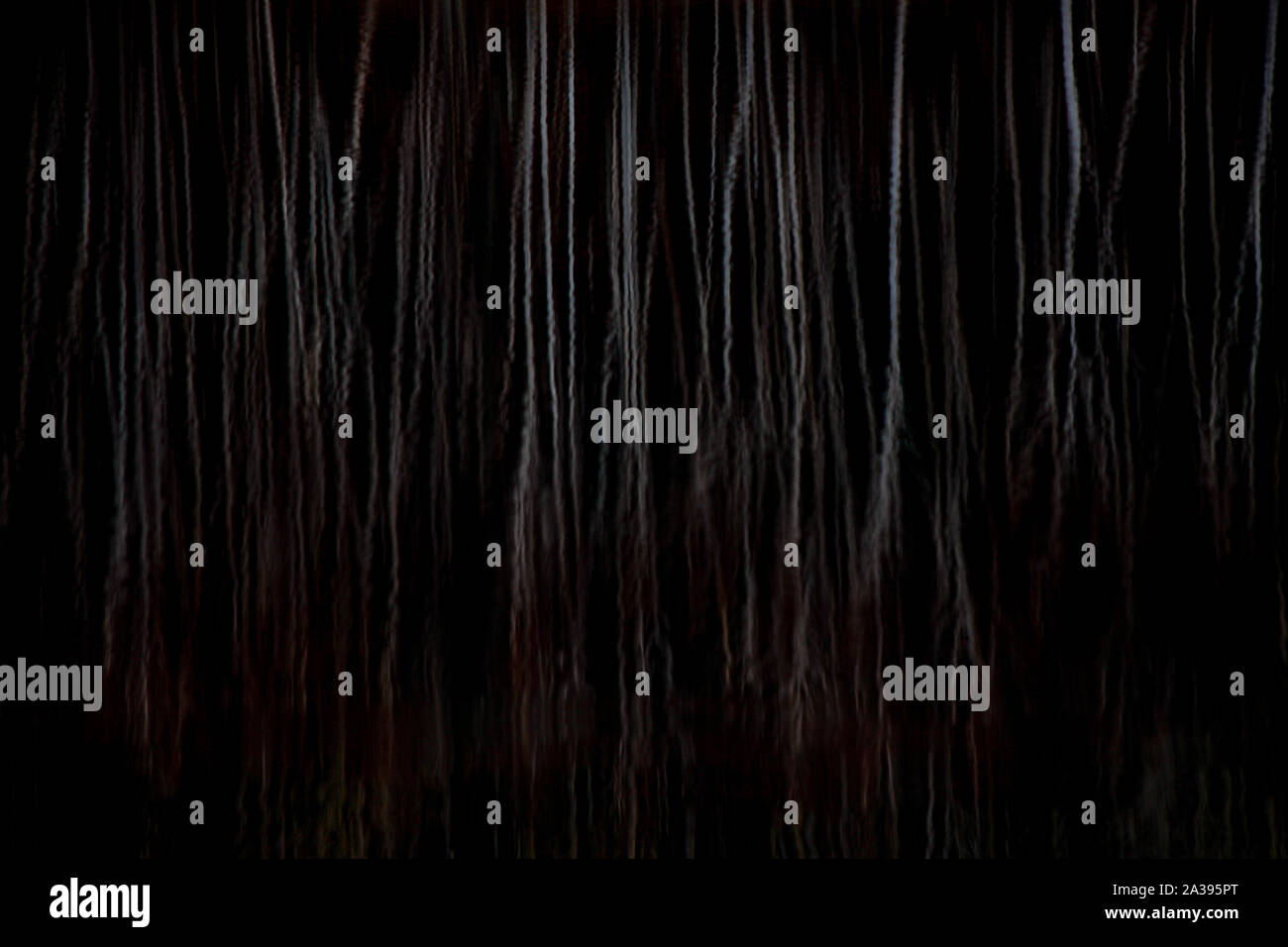 Birch forest in the Acadia National Park in Maine. Cool, moist climate has been the norm on the North Atlantic Coast, but that is changing with the ongoing global warming. With current level of heat trapping emissions, the temperature in the area is likely to rise by more than 5 degrees Fahrenheit by 2070 compared to 1990 levels. That means drier climate and disrupted eco systems. With warmer climate, birch forests in the northern hemisphere are expanding. Forest expansion has been seen as good news, as the trees are important for sequestering of CO2. However; the new vegetation in what used Stock Photohttps://www.alamy.com/image-license-details/?v=1https://www.alamy.com/birch-forest-in-the-acadia-national-park-in-maine-cool-moist-climate-has-been-the-norm-on-the-north-atlantic-coast-but-that-is-changing-with-the-ongoing-global-warming-with-current-level-of-heat-trapping-emissions-the-temperature-in-the-area-is-likely-to-rise-by-more-than-5-degrees-fahrenheit-by-2070-compared-to-1990-levels-that-means-drier-climate-and-disrupted-eco-systems-with-warmer-climate-birch-forests-in-the-northern-hemisphere-are-expanding-forest-expansion-has-been-seen-as-good-news-as-the-trees-are-important-for-sequestering-of-co2-however-the-new-vegetation-in-what-used-image329043088.html
Birch forest in the Acadia National Park in Maine. Cool, moist climate has been the norm on the North Atlantic Coast, but that is changing with the ongoing global warming. With current level of heat trapping emissions, the temperature in the area is likely to rise by more than 5 degrees Fahrenheit by 2070 compared to 1990 levels. That means drier climate and disrupted eco systems. With warmer climate, birch forests in the northern hemisphere are expanding. Forest expansion has been seen as good news, as the trees are important for sequestering of CO2. However; the new vegetation in what used Stock Photohttps://www.alamy.com/image-license-details/?v=1https://www.alamy.com/birch-forest-in-the-acadia-national-park-in-maine-cool-moist-climate-has-been-the-norm-on-the-north-atlantic-coast-but-that-is-changing-with-the-ongoing-global-warming-with-current-level-of-heat-trapping-emissions-the-temperature-in-the-area-is-likely-to-rise-by-more-than-5-degrees-fahrenheit-by-2070-compared-to-1990-levels-that-means-drier-climate-and-disrupted-eco-systems-with-warmer-climate-birch-forests-in-the-northern-hemisphere-are-expanding-forest-expansion-has-been-seen-as-good-news-as-the-trees-are-important-for-sequestering-of-co2-however-the-new-vegetation-in-what-used-image329043088.htmlRM2A395PT–Birch forest in the Acadia National Park in Maine. Cool, moist climate has been the norm on the North Atlantic Coast, but that is changing with the ongoing global warming. With current level of heat trapping emissions, the temperature in the area is likely to rise by more than 5 degrees Fahrenheit by 2070 compared to 1990 levels. That means drier climate and disrupted eco systems. With warmer climate, birch forests in the northern hemisphere are expanding. Forest expansion has been seen as good news, as the trees are important for sequestering of CO2. However; the new vegetation in what used
 Activists form a giant red line during a demonstration near the Arc de Triomphe at the Avenue de la Grande armee boulevard in Paris, France, on December 12, 2015, as a proposed 195-nation accord to curb emissions of the heat-trapping gases that threaten to wreak havoc on Earth's climate system is to be presented at the United Nations conference on climate change COP21 in Le Bourget, on the outskirts of Paris. Photo by Somer/ABACAPRESS.COM Stock Photohttps://www.alamy.com/image-license-details/?v=1https://www.alamy.com/activists-form-a-giant-red-line-during-a-demonstration-near-the-arc-de-triomphe-at-the-avenue-de-la-grande-armee-boulevard-in-paris-france-on-december-12-2015-as-a-proposed-195-nation-accord-to-curb-emissions-of-the-heat-trapping-gases-that-threaten-to-wreak-havoc-on-earths-climate-system-is-to-be-presented-at-the-united-nations-conference-on-climate-change-cop21-in-le-bourget-on-the-outskirts-of-paris-photo-by-somerabacapresscom-image393009020.html
Activists form a giant red line during a demonstration near the Arc de Triomphe at the Avenue de la Grande armee boulevard in Paris, France, on December 12, 2015, as a proposed 195-nation accord to curb emissions of the heat-trapping gases that threaten to wreak havoc on Earth's climate system is to be presented at the United Nations conference on climate change COP21 in Le Bourget, on the outskirts of Paris. Photo by Somer/ABACAPRESS.COM Stock Photohttps://www.alamy.com/image-license-details/?v=1https://www.alamy.com/activists-form-a-giant-red-line-during-a-demonstration-near-the-arc-de-triomphe-at-the-avenue-de-la-grande-armee-boulevard-in-paris-france-on-december-12-2015-as-a-proposed-195-nation-accord-to-curb-emissions-of-the-heat-trapping-gases-that-threaten-to-wreak-havoc-on-earths-climate-system-is-to-be-presented-at-the-united-nations-conference-on-climate-change-cop21-in-le-bourget-on-the-outskirts-of-paris-photo-by-somerabacapresscom-image393009020.htmlRM2DRB30C–Activists form a giant red line during a demonstration near the Arc de Triomphe at the Avenue de la Grande armee boulevard in Paris, France, on December 12, 2015, as a proposed 195-nation accord to curb emissions of the heat-trapping gases that threaten to wreak havoc on Earth's climate system is to be presented at the United Nations conference on climate change COP21 in Le Bourget, on the outskirts of Paris. Photo by Somer/ABACAPRESS.COM
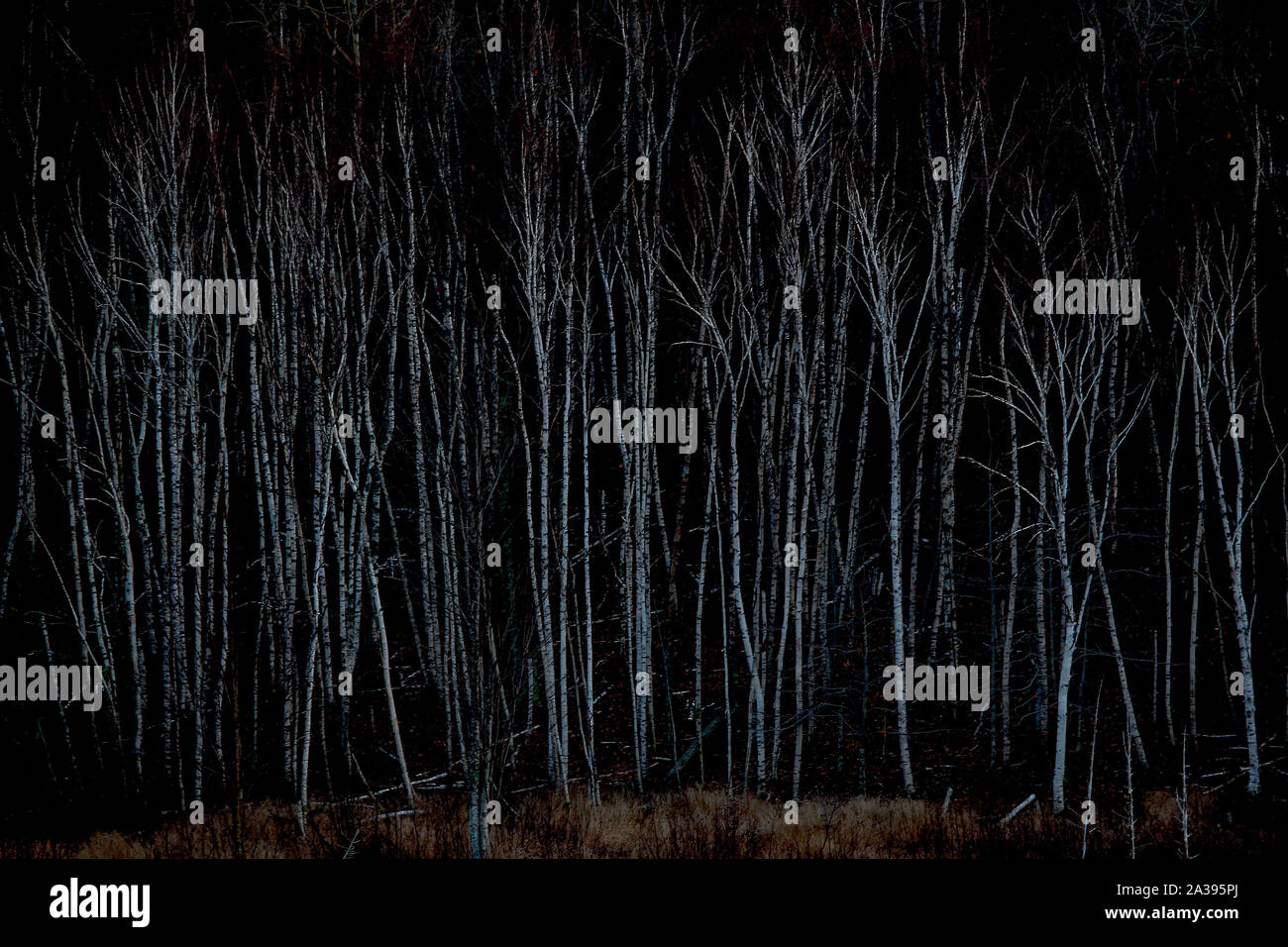 Birch forest in the Acadia National Park in Maine. Cool, moist climate has been the norm on the North Atlantic Coast, but that is changing with the ongoing global warming. With current level of heat trapping emissions, the temperature in the area is likely to rise by more than 5 degrees Fahrenheit by 2070 compared to 1990 levels. That means drier climate and disrupted eco systems. With warmer climate, birch forests in the northern hemisphere are expanding. Forest expansion has been seen as good news, as the trees are important for sequestering of CO2. However; the new vegetation in what used Stock Photohttps://www.alamy.com/image-license-details/?v=1https://www.alamy.com/birch-forest-in-the-acadia-national-park-in-maine-cool-moist-climate-has-been-the-norm-on-the-north-atlantic-coast-but-that-is-changing-with-the-ongoing-global-warming-with-current-level-of-heat-trapping-emissions-the-temperature-in-the-area-is-likely-to-rise-by-more-than-5-degrees-fahrenheit-by-2070-compared-to-1990-levels-that-means-drier-climate-and-disrupted-eco-systems-with-warmer-climate-birch-forests-in-the-northern-hemisphere-are-expanding-forest-expansion-has-been-seen-as-good-news-as-the-trees-are-important-for-sequestering-of-co2-however-the-new-vegetation-in-what-used-image329043082.html
Birch forest in the Acadia National Park in Maine. Cool, moist climate has been the norm on the North Atlantic Coast, but that is changing with the ongoing global warming. With current level of heat trapping emissions, the temperature in the area is likely to rise by more than 5 degrees Fahrenheit by 2070 compared to 1990 levels. That means drier climate and disrupted eco systems. With warmer climate, birch forests in the northern hemisphere are expanding. Forest expansion has been seen as good news, as the trees are important for sequestering of CO2. However; the new vegetation in what used Stock Photohttps://www.alamy.com/image-license-details/?v=1https://www.alamy.com/birch-forest-in-the-acadia-national-park-in-maine-cool-moist-climate-has-been-the-norm-on-the-north-atlantic-coast-but-that-is-changing-with-the-ongoing-global-warming-with-current-level-of-heat-trapping-emissions-the-temperature-in-the-area-is-likely-to-rise-by-more-than-5-degrees-fahrenheit-by-2070-compared-to-1990-levels-that-means-drier-climate-and-disrupted-eco-systems-with-warmer-climate-birch-forests-in-the-northern-hemisphere-are-expanding-forest-expansion-has-been-seen-as-good-news-as-the-trees-are-important-for-sequestering-of-co2-however-the-new-vegetation-in-what-used-image329043082.htmlRM2A395PJ–Birch forest in the Acadia National Park in Maine. Cool, moist climate has been the norm on the North Atlantic Coast, but that is changing with the ongoing global warming. With current level of heat trapping emissions, the temperature in the area is likely to rise by more than 5 degrees Fahrenheit by 2070 compared to 1990 levels. That means drier climate and disrupted eco systems. With warmer climate, birch forests in the northern hemisphere are expanding. Forest expansion has been seen as good news, as the trees are important for sequestering of CO2. However; the new vegetation in what used
 Activists form a giant red line during a demonstration near the Arc de Triomphe at the Avenue de la Grande armee boulevard in Paris, France, on December 12, 2015, as a proposed 195-nation accord to curb emissions of the heat-trapping gases that threaten to wreak havoc on Earth's climate system is to be presented at the United Nations conference on climate change COP21 in Le Bourget, on the outskirts of Paris. Photo by Somer/ABACAPRESS.COM Stock Photohttps://www.alamy.com/image-license-details/?v=1https://www.alamy.com/activists-form-a-giant-red-line-during-a-demonstration-near-the-arc-de-triomphe-at-the-avenue-de-la-grande-armee-boulevard-in-paris-france-on-december-12-2015-as-a-proposed-195-nation-accord-to-curb-emissions-of-the-heat-trapping-gases-that-threaten-to-wreak-havoc-on-earths-climate-system-is-to-be-presented-at-the-united-nations-conference-on-climate-change-cop21-in-le-bourget-on-the-outskirts-of-paris-photo-by-somerabacapresscom-image393008978.html
Activists form a giant red line during a demonstration near the Arc de Triomphe at the Avenue de la Grande armee boulevard in Paris, France, on December 12, 2015, as a proposed 195-nation accord to curb emissions of the heat-trapping gases that threaten to wreak havoc on Earth's climate system is to be presented at the United Nations conference on climate change COP21 in Le Bourget, on the outskirts of Paris. Photo by Somer/ABACAPRESS.COM Stock Photohttps://www.alamy.com/image-license-details/?v=1https://www.alamy.com/activists-form-a-giant-red-line-during-a-demonstration-near-the-arc-de-triomphe-at-the-avenue-de-la-grande-armee-boulevard-in-paris-france-on-december-12-2015-as-a-proposed-195-nation-accord-to-curb-emissions-of-the-heat-trapping-gases-that-threaten-to-wreak-havoc-on-earths-climate-system-is-to-be-presented-at-the-united-nations-conference-on-climate-change-cop21-in-le-bourget-on-the-outskirts-of-paris-photo-by-somerabacapresscom-image393008978.htmlRM2DRB2XX–Activists form a giant red line during a demonstration near the Arc de Triomphe at the Avenue de la Grande armee boulevard in Paris, France, on December 12, 2015, as a proposed 195-nation accord to curb emissions of the heat-trapping gases that threaten to wreak havoc on Earth's climate system is to be presented at the United Nations conference on climate change COP21 in Le Bourget, on the outskirts of Paris. Photo by Somer/ABACAPRESS.COM
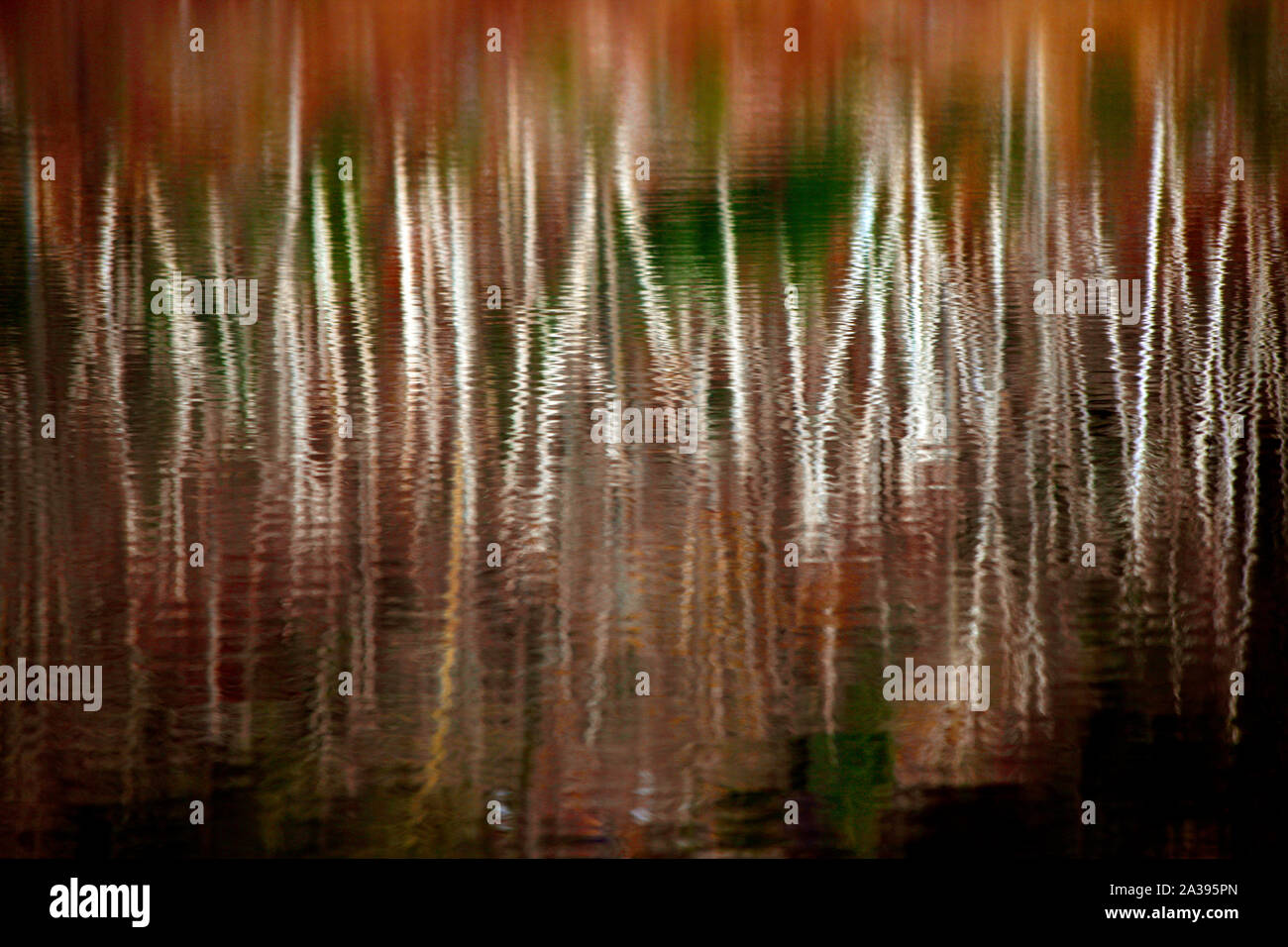 Birch forest in the Acadia National Park in Maine. Cool, moist climate has been the norm on the North Atlantic Coast, but that is changing with the ongoing global warming. With current level of heat trapping emissions, the temperature in the area is likely to rise by more than 5 degrees Fahrenheit by 2070 compared to 1990 levels. That means drier climate and disrupted eco systems. With warmer climate, birch forests in the northern hemisphere are expanding. Forest expansion has been seen as good news, as the trees are important for sequestering of CO2. However; the new vegetation in what used Stock Photohttps://www.alamy.com/image-license-details/?v=1https://www.alamy.com/birch-forest-in-the-acadia-national-park-in-maine-cool-moist-climate-has-been-the-norm-on-the-north-atlantic-coast-but-that-is-changing-with-the-ongoing-global-warming-with-current-level-of-heat-trapping-emissions-the-temperature-in-the-area-is-likely-to-rise-by-more-than-5-degrees-fahrenheit-by-2070-compared-to-1990-levels-that-means-drier-climate-and-disrupted-eco-systems-with-warmer-climate-birch-forests-in-the-northern-hemisphere-are-expanding-forest-expansion-has-been-seen-as-good-news-as-the-trees-are-important-for-sequestering-of-co2-however-the-new-vegetation-in-what-used-image329043085.html
Birch forest in the Acadia National Park in Maine. Cool, moist climate has been the norm on the North Atlantic Coast, but that is changing with the ongoing global warming. With current level of heat trapping emissions, the temperature in the area is likely to rise by more than 5 degrees Fahrenheit by 2070 compared to 1990 levels. That means drier climate and disrupted eco systems. With warmer climate, birch forests in the northern hemisphere are expanding. Forest expansion has been seen as good news, as the trees are important for sequestering of CO2. However; the new vegetation in what used Stock Photohttps://www.alamy.com/image-license-details/?v=1https://www.alamy.com/birch-forest-in-the-acadia-national-park-in-maine-cool-moist-climate-has-been-the-norm-on-the-north-atlantic-coast-but-that-is-changing-with-the-ongoing-global-warming-with-current-level-of-heat-trapping-emissions-the-temperature-in-the-area-is-likely-to-rise-by-more-than-5-degrees-fahrenheit-by-2070-compared-to-1990-levels-that-means-drier-climate-and-disrupted-eco-systems-with-warmer-climate-birch-forests-in-the-northern-hemisphere-are-expanding-forest-expansion-has-been-seen-as-good-news-as-the-trees-are-important-for-sequestering-of-co2-however-the-new-vegetation-in-what-used-image329043085.htmlRM2A395PN–Birch forest in the Acadia National Park in Maine. Cool, moist climate has been the norm on the North Atlantic Coast, but that is changing with the ongoing global warming. With current level of heat trapping emissions, the temperature in the area is likely to rise by more than 5 degrees Fahrenheit by 2070 compared to 1990 levels. That means drier climate and disrupted eco systems. With warmer climate, birch forests in the northern hemisphere are expanding. Forest expansion has been seen as good news, as the trees are important for sequestering of CO2. However; the new vegetation in what used
 Activists form a giant red line during a demonstration near the Arc de Triomphe at the Avenue de la Grande armee boulevard in Paris, France, on December 12, 2015, as a proposed 195-nation accord to curb emissions of the heat-trapping gases that threaten to wreak havoc on Earth's climate system is to be presented at the United Nations conference on climate change COP21 in Le Bourget, on the outskirts of Paris. Photo by Somer/ABACAPRESS.COM Stock Photohttps://www.alamy.com/image-license-details/?v=1https://www.alamy.com/activists-form-a-giant-red-line-during-a-demonstration-near-the-arc-de-triomphe-at-the-avenue-de-la-grande-armee-boulevard-in-paris-france-on-december-12-2015-as-a-proposed-195-nation-accord-to-curb-emissions-of-the-heat-trapping-gases-that-threaten-to-wreak-havoc-on-earths-climate-system-is-to-be-presented-at-the-united-nations-conference-on-climate-change-cop21-in-le-bourget-on-the-outskirts-of-paris-photo-by-somerabacapresscom-image393008947.html
Activists form a giant red line during a demonstration near the Arc de Triomphe at the Avenue de la Grande armee boulevard in Paris, France, on December 12, 2015, as a proposed 195-nation accord to curb emissions of the heat-trapping gases that threaten to wreak havoc on Earth's climate system is to be presented at the United Nations conference on climate change COP21 in Le Bourget, on the outskirts of Paris. Photo by Somer/ABACAPRESS.COM Stock Photohttps://www.alamy.com/image-license-details/?v=1https://www.alamy.com/activists-form-a-giant-red-line-during-a-demonstration-near-the-arc-de-triomphe-at-the-avenue-de-la-grande-armee-boulevard-in-paris-france-on-december-12-2015-as-a-proposed-195-nation-accord-to-curb-emissions-of-the-heat-trapping-gases-that-threaten-to-wreak-havoc-on-earths-climate-system-is-to-be-presented-at-the-united-nations-conference-on-climate-change-cop21-in-le-bourget-on-the-outskirts-of-paris-photo-by-somerabacapresscom-image393008947.htmlRM2DRB2WR–Activists form a giant red line during a demonstration near the Arc de Triomphe at the Avenue de la Grande armee boulevard in Paris, France, on December 12, 2015, as a proposed 195-nation accord to curb emissions of the heat-trapping gases that threaten to wreak havoc on Earth's climate system is to be presented at the United Nations conference on climate change COP21 in Le Bourget, on the outskirts of Paris. Photo by Somer/ABACAPRESS.COM
 Birch forest in the Acadia National Park in Maine. Cool, moist climate has been the norm on the North Atlantic Coast, but that is changing with the ongoing global warming. With current level of heat trapping emissions, the temperature in the area is likely to rise by more than 5 degrees Fahrenheit by 2070 compared to 1990 levels. That means drier climate and disrupted eco systems. With warmer climate, birch forests in the northern hemisphere are expanding. Forest expansion has been seen as good news, as the trees are important for sequestering of CO2. However; the new vegetation in what used Stock Photohttps://www.alamy.com/image-license-details/?v=1https://www.alamy.com/birch-forest-in-the-acadia-national-park-in-maine-cool-moist-climate-has-been-the-norm-on-the-north-atlantic-coast-but-that-is-changing-with-the-ongoing-global-warming-with-current-level-of-heat-trapping-emissions-the-temperature-in-the-area-is-likely-to-rise-by-more-than-5-degrees-fahrenheit-by-2070-compared-to-1990-levels-that-means-drier-climate-and-disrupted-eco-systems-with-warmer-climate-birch-forests-in-the-northern-hemisphere-are-expanding-forest-expansion-has-been-seen-as-good-news-as-the-trees-are-important-for-sequestering-of-co2-however-the-new-vegetation-in-what-used-image329043090.html
Birch forest in the Acadia National Park in Maine. Cool, moist climate has been the norm on the North Atlantic Coast, but that is changing with the ongoing global warming. With current level of heat trapping emissions, the temperature in the area is likely to rise by more than 5 degrees Fahrenheit by 2070 compared to 1990 levels. That means drier climate and disrupted eco systems. With warmer climate, birch forests in the northern hemisphere are expanding. Forest expansion has been seen as good news, as the trees are important for sequestering of CO2. However; the new vegetation in what used Stock Photohttps://www.alamy.com/image-license-details/?v=1https://www.alamy.com/birch-forest-in-the-acadia-national-park-in-maine-cool-moist-climate-has-been-the-norm-on-the-north-atlantic-coast-but-that-is-changing-with-the-ongoing-global-warming-with-current-level-of-heat-trapping-emissions-the-temperature-in-the-area-is-likely-to-rise-by-more-than-5-degrees-fahrenheit-by-2070-compared-to-1990-levels-that-means-drier-climate-and-disrupted-eco-systems-with-warmer-climate-birch-forests-in-the-northern-hemisphere-are-expanding-forest-expansion-has-been-seen-as-good-news-as-the-trees-are-important-for-sequestering-of-co2-however-the-new-vegetation-in-what-used-image329043090.htmlRM2A395PX–Birch forest in the Acadia National Park in Maine. Cool, moist climate has been the norm on the North Atlantic Coast, but that is changing with the ongoing global warming. With current level of heat trapping emissions, the temperature in the area is likely to rise by more than 5 degrees Fahrenheit by 2070 compared to 1990 levels. That means drier climate and disrupted eco systems. With warmer climate, birch forests in the northern hemisphere are expanding. Forest expansion has been seen as good news, as the trees are important for sequestering of CO2. However; the new vegetation in what used
 Activists form a giant red line during a demonstration near the Arc de Triomphe at the Avenue de la Grande armee boulevard in Paris, France, on December 12, 2015, as a proposed 195-nation accord to curb emissions of the heat-trapping gases that threaten to wreak havoc on Earth's climate system is to be presented at the United Nations conference on climate change COP21 in Le Bourget, on the outskirts of Paris. Photo by Somer/ABACAPRESS.COM Stock Photohttps://www.alamy.com/image-license-details/?v=1https://www.alamy.com/activists-form-a-giant-red-line-during-a-demonstration-near-the-arc-de-triomphe-at-the-avenue-de-la-grande-armee-boulevard-in-paris-france-on-december-12-2015-as-a-proposed-195-nation-accord-to-curb-emissions-of-the-heat-trapping-gases-that-threaten-to-wreak-havoc-on-earths-climate-system-is-to-be-presented-at-the-united-nations-conference-on-climate-change-cop21-in-le-bourget-on-the-outskirts-of-paris-photo-by-somerabacapresscom-image393008970.html
Activists form a giant red line during a demonstration near the Arc de Triomphe at the Avenue de la Grande armee boulevard in Paris, France, on December 12, 2015, as a proposed 195-nation accord to curb emissions of the heat-trapping gases that threaten to wreak havoc on Earth's climate system is to be presented at the United Nations conference on climate change COP21 in Le Bourget, on the outskirts of Paris. Photo by Somer/ABACAPRESS.COM Stock Photohttps://www.alamy.com/image-license-details/?v=1https://www.alamy.com/activists-form-a-giant-red-line-during-a-demonstration-near-the-arc-de-triomphe-at-the-avenue-de-la-grande-armee-boulevard-in-paris-france-on-december-12-2015-as-a-proposed-195-nation-accord-to-curb-emissions-of-the-heat-trapping-gases-that-threaten-to-wreak-havoc-on-earths-climate-system-is-to-be-presented-at-the-united-nations-conference-on-climate-change-cop21-in-le-bourget-on-the-outskirts-of-paris-photo-by-somerabacapresscom-image393008970.htmlRM2DRB2XJ–Activists form a giant red line during a demonstration near the Arc de Triomphe at the Avenue de la Grande armee boulevard in Paris, France, on December 12, 2015, as a proposed 195-nation accord to curb emissions of the heat-trapping gases that threaten to wreak havoc on Earth's climate system is to be presented at the United Nations conference on climate change COP21 in Le Bourget, on the outskirts of Paris. Photo by Somer/ABACAPRESS.COM
 Birch forest in the Acadia National Park in Maine. Cool, moist climate has been the norm on the North Atlantic Coast, but that is changing with the ongoing global warming. With current level of heat trapping emissions, the temperature in the area is likely to rise by more than 5 degrees Fahrenheit by 2070 compared to 1990 levels. That means drier climate and disrupted eco systems. With warmer climate, birch forests in the northern hemisphere are expanding. Forest expansion has been seen as good news, as the trees are important for sequestering of CO2. However; the new vegetation in what used Stock Photohttps://www.alamy.com/image-license-details/?v=1https://www.alamy.com/birch-forest-in-the-acadia-national-park-in-maine-cool-moist-climate-has-been-the-norm-on-the-north-atlantic-coast-but-that-is-changing-with-the-ongoing-global-warming-with-current-level-of-heat-trapping-emissions-the-temperature-in-the-area-is-likely-to-rise-by-more-than-5-degrees-fahrenheit-by-2070-compared-to-1990-levels-that-means-drier-climate-and-disrupted-eco-systems-with-warmer-climate-birch-forests-in-the-northern-hemisphere-are-expanding-forest-expansion-has-been-seen-as-good-news-as-the-trees-are-important-for-sequestering-of-co2-however-the-new-vegetation-in-what-used-image329043086.html
Birch forest in the Acadia National Park in Maine. Cool, moist climate has been the norm on the North Atlantic Coast, but that is changing with the ongoing global warming. With current level of heat trapping emissions, the temperature in the area is likely to rise by more than 5 degrees Fahrenheit by 2070 compared to 1990 levels. That means drier climate and disrupted eco systems. With warmer climate, birch forests in the northern hemisphere are expanding. Forest expansion has been seen as good news, as the trees are important for sequestering of CO2. However; the new vegetation in what used Stock Photohttps://www.alamy.com/image-license-details/?v=1https://www.alamy.com/birch-forest-in-the-acadia-national-park-in-maine-cool-moist-climate-has-been-the-norm-on-the-north-atlantic-coast-but-that-is-changing-with-the-ongoing-global-warming-with-current-level-of-heat-trapping-emissions-the-temperature-in-the-area-is-likely-to-rise-by-more-than-5-degrees-fahrenheit-by-2070-compared-to-1990-levels-that-means-drier-climate-and-disrupted-eco-systems-with-warmer-climate-birch-forests-in-the-northern-hemisphere-are-expanding-forest-expansion-has-been-seen-as-good-news-as-the-trees-are-important-for-sequestering-of-co2-however-the-new-vegetation-in-what-used-image329043086.htmlRM2A395PP–Birch forest in the Acadia National Park in Maine. Cool, moist climate has been the norm on the North Atlantic Coast, but that is changing with the ongoing global warming. With current level of heat trapping emissions, the temperature in the area is likely to rise by more than 5 degrees Fahrenheit by 2070 compared to 1990 levels. That means drier climate and disrupted eco systems. With warmer climate, birch forests in the northern hemisphere are expanding. Forest expansion has been seen as good news, as the trees are important for sequestering of CO2. However; the new vegetation in what used
 Activists form a giant red line during a demonstration near the Arc de Triomphe at the Avenue de la Grande armee boulevard in Paris, France, on December 12, 2015, as a proposed 195-nation accord to curb emissions of the heat-trapping gases that threaten to wreak havoc on Earth's climate system is to be presented at the United Nations conference on climate change COP21 in Le Bourget, on the outskirts of Paris. Photo by Somer/ABACAPRESS.COM Stock Photohttps://www.alamy.com/image-license-details/?v=1https://www.alamy.com/activists-form-a-giant-red-line-during-a-demonstration-near-the-arc-de-triomphe-at-the-avenue-de-la-grande-armee-boulevard-in-paris-france-on-december-12-2015-as-a-proposed-195-nation-accord-to-curb-emissions-of-the-heat-trapping-gases-that-threaten-to-wreak-havoc-on-earths-climate-system-is-to-be-presented-at-the-united-nations-conference-on-climate-change-cop21-in-le-bourget-on-the-outskirts-of-paris-photo-by-somerabacapresscom-image393008958.html
Activists form a giant red line during a demonstration near the Arc de Triomphe at the Avenue de la Grande armee boulevard in Paris, France, on December 12, 2015, as a proposed 195-nation accord to curb emissions of the heat-trapping gases that threaten to wreak havoc on Earth's climate system is to be presented at the United Nations conference on climate change COP21 in Le Bourget, on the outskirts of Paris. Photo by Somer/ABACAPRESS.COM Stock Photohttps://www.alamy.com/image-license-details/?v=1https://www.alamy.com/activists-form-a-giant-red-line-during-a-demonstration-near-the-arc-de-triomphe-at-the-avenue-de-la-grande-armee-boulevard-in-paris-france-on-december-12-2015-as-a-proposed-195-nation-accord-to-curb-emissions-of-the-heat-trapping-gases-that-threaten-to-wreak-havoc-on-earths-climate-system-is-to-be-presented-at-the-united-nations-conference-on-climate-change-cop21-in-le-bourget-on-the-outskirts-of-paris-photo-by-somerabacapresscom-image393008958.htmlRM2DRB2X6–Activists form a giant red line during a demonstration near the Arc de Triomphe at the Avenue de la Grande armee boulevard in Paris, France, on December 12, 2015, as a proposed 195-nation accord to curb emissions of the heat-trapping gases that threaten to wreak havoc on Earth's climate system is to be presented at the United Nations conference on climate change COP21 in Le Bourget, on the outskirts of Paris. Photo by Somer/ABACAPRESS.COM
 Birch forest in the Acadia National Park in Maine. Cool, moist climate has been the norm on the North Atlantic Coast, but that is changing with the ongoing global warming. With current level of heat trapping emissions, the temperature in the area is likely to rise by more than 5 degrees Fahrenheit by 2070 compared to 1990 levels. That means drier climate and disrupted eco systems. With warmer climate, birch forests in the northern hemisphere are expanding. Forest expansion has been seen as good news, as the trees are important for sequestering of CO2. However; the new vegetation in what used Stock Photohttps://www.alamy.com/image-license-details/?v=1https://www.alamy.com/birch-forest-in-the-acadia-national-park-in-maine-cool-moist-climate-has-been-the-norm-on-the-north-atlantic-coast-but-that-is-changing-with-the-ongoing-global-warming-with-current-level-of-heat-trapping-emissions-the-temperature-in-the-area-is-likely-to-rise-by-more-than-5-degrees-fahrenheit-by-2070-compared-to-1990-levels-that-means-drier-climate-and-disrupted-eco-systems-with-warmer-climate-birch-forests-in-the-northern-hemisphere-are-expanding-forest-expansion-has-been-seen-as-good-news-as-the-trees-are-important-for-sequestering-of-co2-however-the-new-vegetation-in-what-used-image329043093.html
Birch forest in the Acadia National Park in Maine. Cool, moist climate has been the norm on the North Atlantic Coast, but that is changing with the ongoing global warming. With current level of heat trapping emissions, the temperature in the area is likely to rise by more than 5 degrees Fahrenheit by 2070 compared to 1990 levels. That means drier climate and disrupted eco systems. With warmer climate, birch forests in the northern hemisphere are expanding. Forest expansion has been seen as good news, as the trees are important for sequestering of CO2. However; the new vegetation in what used Stock Photohttps://www.alamy.com/image-license-details/?v=1https://www.alamy.com/birch-forest-in-the-acadia-national-park-in-maine-cool-moist-climate-has-been-the-norm-on-the-north-atlantic-coast-but-that-is-changing-with-the-ongoing-global-warming-with-current-level-of-heat-trapping-emissions-the-temperature-in-the-area-is-likely-to-rise-by-more-than-5-degrees-fahrenheit-by-2070-compared-to-1990-levels-that-means-drier-climate-and-disrupted-eco-systems-with-warmer-climate-birch-forests-in-the-northern-hemisphere-are-expanding-forest-expansion-has-been-seen-as-good-news-as-the-trees-are-important-for-sequestering-of-co2-however-the-new-vegetation-in-what-used-image329043093.htmlRM2A395R1–Birch forest in the Acadia National Park in Maine. Cool, moist climate has been the norm on the North Atlantic Coast, but that is changing with the ongoing global warming. With current level of heat trapping emissions, the temperature in the area is likely to rise by more than 5 degrees Fahrenheit by 2070 compared to 1990 levels. That means drier climate and disrupted eco systems. With warmer climate, birch forests in the northern hemisphere are expanding. Forest expansion has been seen as good news, as the trees are important for sequestering of CO2. However; the new vegetation in what used
 Activists form a giant red line during a demonstration near the Arc de Triomphe at the Avenue de la Grande armee boulevard in Paris, France, on December 12, 2015, as a proposed 195-nation accord to curb emissions of the heat-trapping gases that threaten to wreak havoc on Earth's climate system is to be presented at the United Nations conference on climate change COP21 in Le Bourget, on the outskirts of Paris. Photo by Somer/ABACAPRESS.COM Stock Photohttps://www.alamy.com/image-license-details/?v=1https://www.alamy.com/activists-form-a-giant-red-line-during-a-demonstration-near-the-arc-de-triomphe-at-the-avenue-de-la-grande-armee-boulevard-in-paris-france-on-december-12-2015-as-a-proposed-195-nation-accord-to-curb-emissions-of-the-heat-trapping-gases-that-threaten-to-wreak-havoc-on-earths-climate-system-is-to-be-presented-at-the-united-nations-conference-on-climate-change-cop21-in-le-bourget-on-the-outskirts-of-paris-photo-by-somerabacapresscom-image393009013.html
Activists form a giant red line during a demonstration near the Arc de Triomphe at the Avenue de la Grande armee boulevard in Paris, France, on December 12, 2015, as a proposed 195-nation accord to curb emissions of the heat-trapping gases that threaten to wreak havoc on Earth's climate system is to be presented at the United Nations conference on climate change COP21 in Le Bourget, on the outskirts of Paris. Photo by Somer/ABACAPRESS.COM Stock Photohttps://www.alamy.com/image-license-details/?v=1https://www.alamy.com/activists-form-a-giant-red-line-during-a-demonstration-near-the-arc-de-triomphe-at-the-avenue-de-la-grande-armee-boulevard-in-paris-france-on-december-12-2015-as-a-proposed-195-nation-accord-to-curb-emissions-of-the-heat-trapping-gases-that-threaten-to-wreak-havoc-on-earths-climate-system-is-to-be-presented-at-the-united-nations-conference-on-climate-change-cop21-in-le-bourget-on-the-outskirts-of-paris-photo-by-somerabacapresscom-image393009013.htmlRM2DRB305–Activists form a giant red line during a demonstration near the Arc de Triomphe at the Avenue de la Grande armee boulevard in Paris, France, on December 12, 2015, as a proposed 195-nation accord to curb emissions of the heat-trapping gases that threaten to wreak havoc on Earth's climate system is to be presented at the United Nations conference on climate change COP21 in Le Bourget, on the outskirts of Paris. Photo by Somer/ABACAPRESS.COM
 Birch forest in the Acadia National Park in Maine. Cool, moist climate has been the norm on the North Atlantic Coast, but that is changing with the ongoing global warming. With current level of heat trapping emissions, the temperature in the area is likely to rise by more than 5 degrees Fahrenheit by 2070 compared to 1990 levels. That means drier climate and disrupted eco systems. With warmer climate, birch forests in the northern hemisphere are expanding. Forest expansion has been seen as good news, as the trees are important for sequestering of CO2. However; the new vegetation in what used Stock Photohttps://www.alamy.com/image-license-details/?v=1https://www.alamy.com/birch-forest-in-the-acadia-national-park-in-maine-cool-moist-climate-has-been-the-norm-on-the-north-atlantic-coast-but-that-is-changing-with-the-ongoing-global-warming-with-current-level-of-heat-trapping-emissions-the-temperature-in-the-area-is-likely-to-rise-by-more-than-5-degrees-fahrenheit-by-2070-compared-to-1990-levels-that-means-drier-climate-and-disrupted-eco-systems-with-warmer-climate-birch-forests-in-the-northern-hemisphere-are-expanding-forest-expansion-has-been-seen-as-good-news-as-the-trees-are-important-for-sequestering-of-co2-however-the-new-vegetation-in-what-used-image329043087.html
Birch forest in the Acadia National Park in Maine. Cool, moist climate has been the norm on the North Atlantic Coast, but that is changing with the ongoing global warming. With current level of heat trapping emissions, the temperature in the area is likely to rise by more than 5 degrees Fahrenheit by 2070 compared to 1990 levels. That means drier climate and disrupted eco systems. With warmer climate, birch forests in the northern hemisphere are expanding. Forest expansion has been seen as good news, as the trees are important for sequestering of CO2. However; the new vegetation in what used Stock Photohttps://www.alamy.com/image-license-details/?v=1https://www.alamy.com/birch-forest-in-the-acadia-national-park-in-maine-cool-moist-climate-has-been-the-norm-on-the-north-atlantic-coast-but-that-is-changing-with-the-ongoing-global-warming-with-current-level-of-heat-trapping-emissions-the-temperature-in-the-area-is-likely-to-rise-by-more-than-5-degrees-fahrenheit-by-2070-compared-to-1990-levels-that-means-drier-climate-and-disrupted-eco-systems-with-warmer-climate-birch-forests-in-the-northern-hemisphere-are-expanding-forest-expansion-has-been-seen-as-good-news-as-the-trees-are-important-for-sequestering-of-co2-however-the-new-vegetation-in-what-used-image329043087.htmlRM2A395PR–Birch forest in the Acadia National Park in Maine. Cool, moist climate has been the norm on the North Atlantic Coast, but that is changing with the ongoing global warming. With current level of heat trapping emissions, the temperature in the area is likely to rise by more than 5 degrees Fahrenheit by 2070 compared to 1990 levels. That means drier climate and disrupted eco systems. With warmer climate, birch forests in the northern hemisphere are expanding. Forest expansion has been seen as good news, as the trees are important for sequestering of CO2. However; the new vegetation in what used
 Activists form a giant red line during a demonstration near the Arc de Triomphe at the Avenue de la Grande armee boulevard in Paris, France, on December 12, 2015, as a proposed 195-nation accord to curb emissions of the heat-trapping gases that threaten to wreak havoc on Earth's climate system is to be presented at the United Nations conference on climate change COP21 in Le Bourget, on the outskirts of Paris. Photo by Somer/ABACAPRESS.COM Stock Photohttps://www.alamy.com/image-license-details/?v=1https://www.alamy.com/activists-form-a-giant-red-line-during-a-demonstration-near-the-arc-de-triomphe-at-the-avenue-de-la-grande-armee-boulevard-in-paris-france-on-december-12-2015-as-a-proposed-195-nation-accord-to-curb-emissions-of-the-heat-trapping-gases-that-threaten-to-wreak-havoc-on-earths-climate-system-is-to-be-presented-at-the-united-nations-conference-on-climate-change-cop21-in-le-bourget-on-the-outskirts-of-paris-photo-by-somerabacapresscom-image393009024.html
Activists form a giant red line during a demonstration near the Arc de Triomphe at the Avenue de la Grande armee boulevard in Paris, France, on December 12, 2015, as a proposed 195-nation accord to curb emissions of the heat-trapping gases that threaten to wreak havoc on Earth's climate system is to be presented at the United Nations conference on climate change COP21 in Le Bourget, on the outskirts of Paris. Photo by Somer/ABACAPRESS.COM Stock Photohttps://www.alamy.com/image-license-details/?v=1https://www.alamy.com/activists-form-a-giant-red-line-during-a-demonstration-near-the-arc-de-triomphe-at-the-avenue-de-la-grande-armee-boulevard-in-paris-france-on-december-12-2015-as-a-proposed-195-nation-accord-to-curb-emissions-of-the-heat-trapping-gases-that-threaten-to-wreak-havoc-on-earths-climate-system-is-to-be-presented-at-the-united-nations-conference-on-climate-change-cop21-in-le-bourget-on-the-outskirts-of-paris-photo-by-somerabacapresscom-image393009024.htmlRM2DRB30G–Activists form a giant red line during a demonstration near the Arc de Triomphe at the Avenue de la Grande armee boulevard in Paris, France, on December 12, 2015, as a proposed 195-nation accord to curb emissions of the heat-trapping gases that threaten to wreak havoc on Earth's climate system is to be presented at the United Nations conference on climate change COP21 in Le Bourget, on the outskirts of Paris. Photo by Somer/ABACAPRESS.COM
 Birch forest in the Acadia National Park in Maine. Cool, moist climate has been the norm on the North Atlantic Coast, but that is changing with the ongoing global warming. With current level of heat trapping emissions, the temperature in the area is likely to rise by more than 5 degrees Fahrenheit by 2070 compared to 1990 levels. That means drier climate and disrupted eco systems. With warmer climate, birch forests in the northern hemisphere are expanding. Forest expansion has been seen as good news, as the trees are important for sequestering of CO2. However; the new vegetation in what used Stock Photohttps://www.alamy.com/image-license-details/?v=1https://www.alamy.com/birch-forest-in-the-acadia-national-park-in-maine-cool-moist-climate-has-been-the-norm-on-the-north-atlantic-coast-but-that-is-changing-with-the-ongoing-global-warming-with-current-level-of-heat-trapping-emissions-the-temperature-in-the-area-is-likely-to-rise-by-more-than-5-degrees-fahrenheit-by-2070-compared-to-1990-levels-that-means-drier-climate-and-disrupted-eco-systems-with-warmer-climate-birch-forests-in-the-northern-hemisphere-are-expanding-forest-expansion-has-been-seen-as-good-news-as-the-trees-are-important-for-sequestering-of-co2-however-the-new-vegetation-in-what-used-image329043091.html
Birch forest in the Acadia National Park in Maine. Cool, moist climate has been the norm on the North Atlantic Coast, but that is changing with the ongoing global warming. With current level of heat trapping emissions, the temperature in the area is likely to rise by more than 5 degrees Fahrenheit by 2070 compared to 1990 levels. That means drier climate and disrupted eco systems. With warmer climate, birch forests in the northern hemisphere are expanding. Forest expansion has been seen as good news, as the trees are important for sequestering of CO2. However; the new vegetation in what used Stock Photohttps://www.alamy.com/image-license-details/?v=1https://www.alamy.com/birch-forest-in-the-acadia-national-park-in-maine-cool-moist-climate-has-been-the-norm-on-the-north-atlantic-coast-but-that-is-changing-with-the-ongoing-global-warming-with-current-level-of-heat-trapping-emissions-the-temperature-in-the-area-is-likely-to-rise-by-more-than-5-degrees-fahrenheit-by-2070-compared-to-1990-levels-that-means-drier-climate-and-disrupted-eco-systems-with-warmer-climate-birch-forests-in-the-northern-hemisphere-are-expanding-forest-expansion-has-been-seen-as-good-news-as-the-trees-are-important-for-sequestering-of-co2-however-the-new-vegetation-in-what-used-image329043091.htmlRM2A395PY–Birch forest in the Acadia National Park in Maine. Cool, moist climate has been the norm on the North Atlantic Coast, but that is changing with the ongoing global warming. With current level of heat trapping emissions, the temperature in the area is likely to rise by more than 5 degrees Fahrenheit by 2070 compared to 1990 levels. That means drier climate and disrupted eco systems. With warmer climate, birch forests in the northern hemisphere are expanding. Forest expansion has been seen as good news, as the trees are important for sequestering of CO2. However; the new vegetation in what used
 Activists form a giant red line during a demonstration near the Arc de Triomphe at the Avenue de la Grande armee boulevard in Paris, France, on December 12, 2015, as a proposed 195-nation accord to curb emissions of the heat-trapping gases that threaten to wreak havoc on Earth's climate system is to be presented at the United Nations conference on climate change COP21 in Le Bourget, on the outskirts of Paris. Photo by Somer/ABACAPRESS.COM Stock Photohttps://www.alamy.com/image-license-details/?v=1https://www.alamy.com/activists-form-a-giant-red-line-during-a-demonstration-near-the-arc-de-triomphe-at-the-avenue-de-la-grande-armee-boulevard-in-paris-france-on-december-12-2015-as-a-proposed-195-nation-accord-to-curb-emissions-of-the-heat-trapping-gases-that-threaten-to-wreak-havoc-on-earths-climate-system-is-to-be-presented-at-the-united-nations-conference-on-climate-change-cop21-in-le-bourget-on-the-outskirts-of-paris-photo-by-somerabacapresscom-image393009002.html
Activists form a giant red line during a demonstration near the Arc de Triomphe at the Avenue de la Grande armee boulevard in Paris, France, on December 12, 2015, as a proposed 195-nation accord to curb emissions of the heat-trapping gases that threaten to wreak havoc on Earth's climate system is to be presented at the United Nations conference on climate change COP21 in Le Bourget, on the outskirts of Paris. Photo by Somer/ABACAPRESS.COM Stock Photohttps://www.alamy.com/image-license-details/?v=1https://www.alamy.com/activists-form-a-giant-red-line-during-a-demonstration-near-the-arc-de-triomphe-at-the-avenue-de-la-grande-armee-boulevard-in-paris-france-on-december-12-2015-as-a-proposed-195-nation-accord-to-curb-emissions-of-the-heat-trapping-gases-that-threaten-to-wreak-havoc-on-earths-climate-system-is-to-be-presented-at-the-united-nations-conference-on-climate-change-cop21-in-le-bourget-on-the-outskirts-of-paris-photo-by-somerabacapresscom-image393009002.htmlRM2DRB2YP–Activists form a giant red line during a demonstration near the Arc de Triomphe at the Avenue de la Grande armee boulevard in Paris, France, on December 12, 2015, as a proposed 195-nation accord to curb emissions of the heat-trapping gases that threaten to wreak havoc on Earth's climate system is to be presented at the United Nations conference on climate change COP21 in Le Bourget, on the outskirts of Paris. Photo by Somer/ABACAPRESS.COM
 Birch forest in the Acadia National Park in Maine. Cool, moist climate has been the norm on the North Atlantic Coast, but that is changing with the ongoing global warming. With current level of heat trapping emissions, the temperature in the area is likely to rise by more than 5 degrees Fahrenheit by 2070 compared to 1990 levels. That means drier climate and disrupted eco systems. With warmer climate, birch forests in the northern hemisphere are expanding. Forest expansion has been seen as good news, as the trees are important for sequestering of CO2. However; the new vegetation in what used Stock Photohttps://www.alamy.com/image-license-details/?v=1https://www.alamy.com/birch-forest-in-the-acadia-national-park-in-maine-cool-moist-climate-has-been-the-norm-on-the-north-atlantic-coast-but-that-is-changing-with-the-ongoing-global-warming-with-current-level-of-heat-trapping-emissions-the-temperature-in-the-area-is-likely-to-rise-by-more-than-5-degrees-fahrenheit-by-2070-compared-to-1990-levels-that-means-drier-climate-and-disrupted-eco-systems-with-warmer-climate-birch-forests-in-the-northern-hemisphere-are-expanding-forest-expansion-has-been-seen-as-good-news-as-the-trees-are-important-for-sequestering-of-co2-however-the-new-vegetation-in-what-used-image617535395.html
Birch forest in the Acadia National Park in Maine. Cool, moist climate has been the norm on the North Atlantic Coast, but that is changing with the ongoing global warming. With current level of heat trapping emissions, the temperature in the area is likely to rise by more than 5 degrees Fahrenheit by 2070 compared to 1990 levels. That means drier climate and disrupted eco systems. With warmer climate, birch forests in the northern hemisphere are expanding. Forest expansion has been seen as good news, as the trees are important for sequestering of CO2. However; the new vegetation in what used Stock Photohttps://www.alamy.com/image-license-details/?v=1https://www.alamy.com/birch-forest-in-the-acadia-national-park-in-maine-cool-moist-climate-has-been-the-norm-on-the-north-atlantic-coast-but-that-is-changing-with-the-ongoing-global-warming-with-current-level-of-heat-trapping-emissions-the-temperature-in-the-area-is-likely-to-rise-by-more-than-5-degrees-fahrenheit-by-2070-compared-to-1990-levels-that-means-drier-climate-and-disrupted-eco-systems-with-warmer-climate-birch-forests-in-the-northern-hemisphere-are-expanding-forest-expansion-has-been-seen-as-good-news-as-the-trees-are-important-for-sequestering-of-co2-however-the-new-vegetation-in-what-used-image617535395.htmlRM2XTK4KF–Birch forest in the Acadia National Park in Maine. Cool, moist climate has been the norm on the North Atlantic Coast, but that is changing with the ongoing global warming. With current level of heat trapping emissions, the temperature in the area is likely to rise by more than 5 degrees Fahrenheit by 2070 compared to 1990 levels. That means drier climate and disrupted eco systems. With warmer climate, birch forests in the northern hemisphere are expanding. Forest expansion has been seen as good news, as the trees are important for sequestering of CO2. However; the new vegetation in what used
 Activists form a giant red line during a demonstration near the Arc de Triomphe at the Avenue de la Grande armee boulevard in Paris, France, on December 12, 2015, as a proposed 195-nation accord to curb emissions of the heat-trapping gases that threaten to wreak havoc on Earth's climate system is to be presented at the United Nations conference on climate change COP21 in Le Bourget, on the outskirts of Paris. Photo by Somer/ABACAPRESS.COM Stock Photohttps://www.alamy.com/image-license-details/?v=1https://www.alamy.com/activists-form-a-giant-red-line-during-a-demonstration-near-the-arc-de-triomphe-at-the-avenue-de-la-grande-armee-boulevard-in-paris-france-on-december-12-2015-as-a-proposed-195-nation-accord-to-curb-emissions-of-the-heat-trapping-gases-that-threaten-to-wreak-havoc-on-earths-climate-system-is-to-be-presented-at-the-united-nations-conference-on-climate-change-cop21-in-le-bourget-on-the-outskirts-of-paris-photo-by-somerabacapresscom-image393009038.html
Activists form a giant red line during a demonstration near the Arc de Triomphe at the Avenue de la Grande armee boulevard in Paris, France, on December 12, 2015, as a proposed 195-nation accord to curb emissions of the heat-trapping gases that threaten to wreak havoc on Earth's climate system is to be presented at the United Nations conference on climate change COP21 in Le Bourget, on the outskirts of Paris. Photo by Somer/ABACAPRESS.COM Stock Photohttps://www.alamy.com/image-license-details/?v=1https://www.alamy.com/activists-form-a-giant-red-line-during-a-demonstration-near-the-arc-de-triomphe-at-the-avenue-de-la-grande-armee-boulevard-in-paris-france-on-december-12-2015-as-a-proposed-195-nation-accord-to-curb-emissions-of-the-heat-trapping-gases-that-threaten-to-wreak-havoc-on-earths-climate-system-is-to-be-presented-at-the-united-nations-conference-on-climate-change-cop21-in-le-bourget-on-the-outskirts-of-paris-photo-by-somerabacapresscom-image393009038.htmlRM2DRB312–Activists form a giant red line during a demonstration near the Arc de Triomphe at the Avenue de la Grande armee boulevard in Paris, France, on December 12, 2015, as a proposed 195-nation accord to curb emissions of the heat-trapping gases that threaten to wreak havoc on Earth's climate system is to be presented at the United Nations conference on climate change COP21 in Le Bourget, on the outskirts of Paris. Photo by Somer/ABACAPRESS.COM
 Birch forest in the Acadia National Park in Maine. Cool, moist climate has been the norm on the North Atlantic Coast, but that is changing with the ongoing global warming. With current level of heat trapping emissions, the temperature in the area is likely to rise by more than 5 degrees Fahrenheit by 2070 compared to 1990 levels. That means drier climate and disrupted eco systems. With warmer climate, birch forests in the northern hemisphere are expanding. Forest expansion has been seen as good news, as the trees are important for sequestering of CO2. However; the new vegetation in what used Stock Photohttps://www.alamy.com/image-license-details/?v=1https://www.alamy.com/birch-forest-in-the-acadia-national-park-in-maine-cool-moist-climate-has-been-the-norm-on-the-north-atlantic-coast-but-that-is-changing-with-the-ongoing-global-warming-with-current-level-of-heat-trapping-emissions-the-temperature-in-the-area-is-likely-to-rise-by-more-than-5-degrees-fahrenheit-by-2070-compared-to-1990-levels-that-means-drier-climate-and-disrupted-eco-systems-with-warmer-climate-birch-forests-in-the-northern-hemisphere-are-expanding-forest-expansion-has-been-seen-as-good-news-as-the-trees-are-important-for-sequestering-of-co2-however-the-new-vegetation-in-what-used-image617535398.html
Birch forest in the Acadia National Park in Maine. Cool, moist climate has been the norm on the North Atlantic Coast, but that is changing with the ongoing global warming. With current level of heat trapping emissions, the temperature in the area is likely to rise by more than 5 degrees Fahrenheit by 2070 compared to 1990 levels. That means drier climate and disrupted eco systems. With warmer climate, birch forests in the northern hemisphere are expanding. Forest expansion has been seen as good news, as the trees are important for sequestering of CO2. However; the new vegetation in what used Stock Photohttps://www.alamy.com/image-license-details/?v=1https://www.alamy.com/birch-forest-in-the-acadia-national-park-in-maine-cool-moist-climate-has-been-the-norm-on-the-north-atlantic-coast-but-that-is-changing-with-the-ongoing-global-warming-with-current-level-of-heat-trapping-emissions-the-temperature-in-the-area-is-likely-to-rise-by-more-than-5-degrees-fahrenheit-by-2070-compared-to-1990-levels-that-means-drier-climate-and-disrupted-eco-systems-with-warmer-climate-birch-forests-in-the-northern-hemisphere-are-expanding-forest-expansion-has-been-seen-as-good-news-as-the-trees-are-important-for-sequestering-of-co2-however-the-new-vegetation-in-what-used-image617535398.htmlRM2XTK4KJ–Birch forest in the Acadia National Park in Maine. Cool, moist climate has been the norm on the North Atlantic Coast, but that is changing with the ongoing global warming. With current level of heat trapping emissions, the temperature in the area is likely to rise by more than 5 degrees Fahrenheit by 2070 compared to 1990 levels. That means drier climate and disrupted eco systems. With warmer climate, birch forests in the northern hemisphere are expanding. Forest expansion has been seen as good news, as the trees are important for sequestering of CO2. However; the new vegetation in what used
 Activists form a giant red line during a demonstration near the Arc de Triomphe at the Avenue de la Grande armee boulevard in Paris, France, on December 12, 2015, as a proposed 195-nation accord to curb emissions of the heat-trapping gases that threaten to wreak havoc on Earth's climate system is to be presented at the United Nations conference on climate change COP21 in Le Bourget, on the outskirts of Paris. Photo by Somer/ABACAPRESS.COM Stock Photohttps://www.alamy.com/image-license-details/?v=1https://www.alamy.com/activists-form-a-giant-red-line-during-a-demonstration-near-the-arc-de-triomphe-at-the-avenue-de-la-grande-armee-boulevard-in-paris-france-on-december-12-2015-as-a-proposed-195-nation-accord-to-curb-emissions-of-the-heat-trapping-gases-that-threaten-to-wreak-havoc-on-earths-climate-system-is-to-be-presented-at-the-united-nations-conference-on-climate-change-cop21-in-le-bourget-on-the-outskirts-of-paris-photo-by-somerabacapresscom-image393008976.html
Activists form a giant red line during a demonstration near the Arc de Triomphe at the Avenue de la Grande armee boulevard in Paris, France, on December 12, 2015, as a proposed 195-nation accord to curb emissions of the heat-trapping gases that threaten to wreak havoc on Earth's climate system is to be presented at the United Nations conference on climate change COP21 in Le Bourget, on the outskirts of Paris. Photo by Somer/ABACAPRESS.COM Stock Photohttps://www.alamy.com/image-license-details/?v=1https://www.alamy.com/activists-form-a-giant-red-line-during-a-demonstration-near-the-arc-de-triomphe-at-the-avenue-de-la-grande-armee-boulevard-in-paris-france-on-december-12-2015-as-a-proposed-195-nation-accord-to-curb-emissions-of-the-heat-trapping-gases-that-threaten-to-wreak-havoc-on-earths-climate-system-is-to-be-presented-at-the-united-nations-conference-on-climate-change-cop21-in-le-bourget-on-the-outskirts-of-paris-photo-by-somerabacapresscom-image393008976.htmlRM2DRB2XT–Activists form a giant red line during a demonstration near the Arc de Triomphe at the Avenue de la Grande armee boulevard in Paris, France, on December 12, 2015, as a proposed 195-nation accord to curb emissions of the heat-trapping gases that threaten to wreak havoc on Earth's climate system is to be presented at the United Nations conference on climate change COP21 in Le Bourget, on the outskirts of Paris. Photo by Somer/ABACAPRESS.COM